SOURCING















































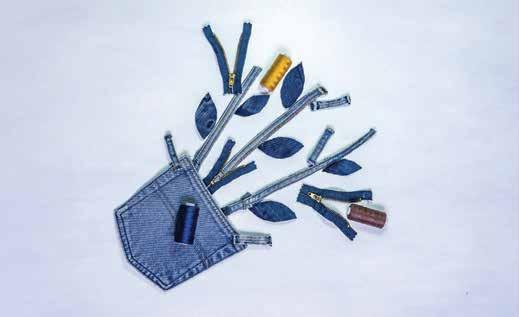
to our new readers , welcome to sj denim
To long-time readers and industry friends, welcome to the next evolution of Rivet.
Ten years ago, Sourcing Journal (a.k.a. SJ) launched Rivet as a separate publication tailor-made for the denim sector. Fast forward to today, and so much has changed. Denim is no longer confined to the traditional denim-only brands; a more diverse range of companies are now integrating denim into their collections, raising new challenges and perspectives that some industry players may have overlooked. The stigma once associated with secondhand shopping has shifted toward fast fashion, opening exciting resale opportunities for brands. Add to that the pressing realities of climate change, trade wars, and volatile economies, which are pushing denim manufacturers to stay informed and make smarter business decisions.
With sourcing, boycotts, tariffs and corporate responsibility dominating the news, the time has come to strengthen Rivet’s connection to SJ and leverage its global reputation as a leader in supply chain news. Rest assured, our core team remains unchanged, as does our unwavering commitment to representing the global denim industry.
SJ Denim will go even deeper into the business of denim, highlighting disruptors, innovators, and tapping into the expertise of denim legends who have shaped the industry.
Think of it like when Levi’s updated the red tab on its jeans from “Levi’s” with a big E to “Levi’s” with a small e in the 1970s. While the look changed, the quality and fit that consumers had come to expect remained the same. Similarly, SJ Denim will continue to deliver the same deep, engaging denim content that Rivet pioneered, but with a fresh perspective and expanded focus.
This debut spring issue exemplifies our renewed mission. In “Game Changers” on pg. 34 we reflect on the 10 innovations that changed the denim industry forever. From advanced finishing technologies to recycling machinery, to water treatment facilities, it is clear how every part of the supply chain has played a role in making denim a more responsible industry.
Looking ahead, fabric mills discuss the potential positive impact of digitally printed jeans in “Digital Denim” on pg. 48. In “Elastic Ethics,” (pg. 52) fiber producers share how they’re leaning into renewable resources to produce stretch denim. In “Fade Away,” (pg. 54) chemical suppliers and manufacturers reveal the challenges in eliminating potassium permanganate from production, and the reasons why they remain hopeful for green chemistry.
Whether it’s new trends and brands or technological breakthroughs, denim is always in motion. Know that wherever the industry goes SJ Denim will be there and take you along for the ride.
FAIRCHILD
EDIT OR IAL
Peter Sadera Editor in Chief, Sourcing Journal Angela Velasquez Executive Editor
Vicki M. Young Executive Financial Reporter
Jasmin Malik Chua Sourcing & Labor Editor
Kate Nishimura Senior News & Features Editor Glenn Taylor Logistics Editor Meghan Hall Business Editor Alexandra Harrell Sustainability & Innovation Reporter
Lauren Parker Director Fairchild Studio/SJ Studio
Sarah Jones Senior Editor, Strategic Content Development
Andre Claudio Staff Writer, Strategic Content
ART DEPARTMENT
Ken DeLago Art Director Logan Case Senior Designer Eric Pak Senior Designer Trinity Krakora Designer
SOURCING JOURNAL ADVERTISING
Deborah B. Baron Advertising Director
PRODUCTION
Anne Leonard Production Manager
Adeline Saez Production Manager
Therese Hurter PreMedia Specialist
ADVERTISING
Melissa Rocco Senior Vice President, Sales Samantha Rumsky Advertising Director Jennifer Petersen Advertising Director, Fashion & Luxury
Stacey Lankind West Coast Director
Katherine Hogan Account Manager, Tech
INTERNATIONAL OFFICES
Olga Kouznetsova European Director, Italy Giulia Squeri European Director, Italy
Elisabeth Sugy Rawson European Director, France
MARKETING
William Gasperoni Vice President Christine Staley Senior Director, Marketing & Fairchild Studio Sara Shenasky Head of Client Activation Barbra Leung Director, Integrated Marketing Alexa Dorfman Senior Marketing Manager
Kayla Gaussaint Associate Integrated Manager
OPERATIONS
Ashley Faradineh Executive Director, Operations
Rosa Stancil Media Planner
Emanuela Altimani Senior Sales Coordinator
SOURCING JOURNAL IS OWNED AND PUBLISHED BY PENSKE MEDIA CORPORATION
Jay Penske Chairman & CEO
Gerry Byrne Vice Chairman
George Grobar Chief Operating Officer
Sarlina See Chief Accounting Officer
Ryan Young Chief Security Officer
Craig Perreault Chief Digital Officer
Todd Greene EVP, Business Affairs & Chief Legal Officer
Celine Perrot-Johnson EVP, Operations & Finance
Paul Rainey EVP, Operations & Finance
Tom Finn EVP, Operations & Finance
Jenny Connelly EVP, Product & Engineering
Ken DelAlcazar EVP, Finance
Debashish Ghosh Managing Director, International Markets
Dan Owen EVP, GM of Strategic Industry Group
Brian Levine Sebior Vice President, Revenue Operations
Brooke Jaffe Vice President, Public Affairs & Strategy
David Roberson Senior Vice President, Subscriptions
Doug Bandes Head of Live Event Partnerships
Frank McCallick Vice President, Global Tax
Gabriel Koen Vice President, Technology
Jessica Kadden Senior Vice President, Programmatic Sales
Judith R. Margolin Senior Vice President, Deputy General Counsel
Ken DelAlcazar Senior Vice President, Finance
Lauren Utecht Senior Vice President, Human Resources
Marissa O’Hare Senior Vice President, Business Development Nelson Anderson Senior Vice President, Creative
Adrian White Vice President, Associate General Counsel
Andrew Root Vice President, Digital Marketing
Andy Limpus Vice President, Executive Search
& Head of Talent Acquisition
Anne Doyle Vice President, Human Resources
Ashley Snyder Vice President, Associate General Counsel
Brian Vrabel Head of Industry, CPG and Health
Constance Ejuma Vice President, Content Performance & Analytics
Courtney Goldstein Vice President, Human Resources
Dan Feinberg Vice President, Associate General Counsel
Danielle Levine Vice President, Associate General Counsel
Denise Tooman Vice President, Marketing, Strategic Solutions Group
Eddie Ko Vice President, Advertising Operations
Greta Shafrazian Vice President, Business Intelligence
Jamie Miles Vice President, eCommerce
James Kiernan Head of Industry, Agency Development
Jennifer Garber Head of Industry, Travel
Jerry Ruiz Vice President, Acquisitions & Operations
Joni Antonacci Vice President, Production Operations
Karen Reed Vice President, Finance
Karl Walter Vice President, Content
Katrina Barlow Vice President, Business Development
Kay Swift Vice President, Information Technology
Keir McMullen Vice President, Human Resources
Matthew Cline Head of Automotive Industry
Mike Ye Vice President, Strategic Planning & Acquisitions Noemi Lazo Vice President, Customer Experience
& Marketing Operations
Richard Han Vice President, International Sales
Scott Ginsberg Head of Industry, Performance Marketing
Sonal Jain Vice President, Associate General Counsel
Richard Han Vice President, International Sales
Scott Ginsberg Head of Industry, Performance Marketing Sonal Jain Vice President, Associate General Counsel
Angela Jean Velasquez EXECUTIVE EDITOR
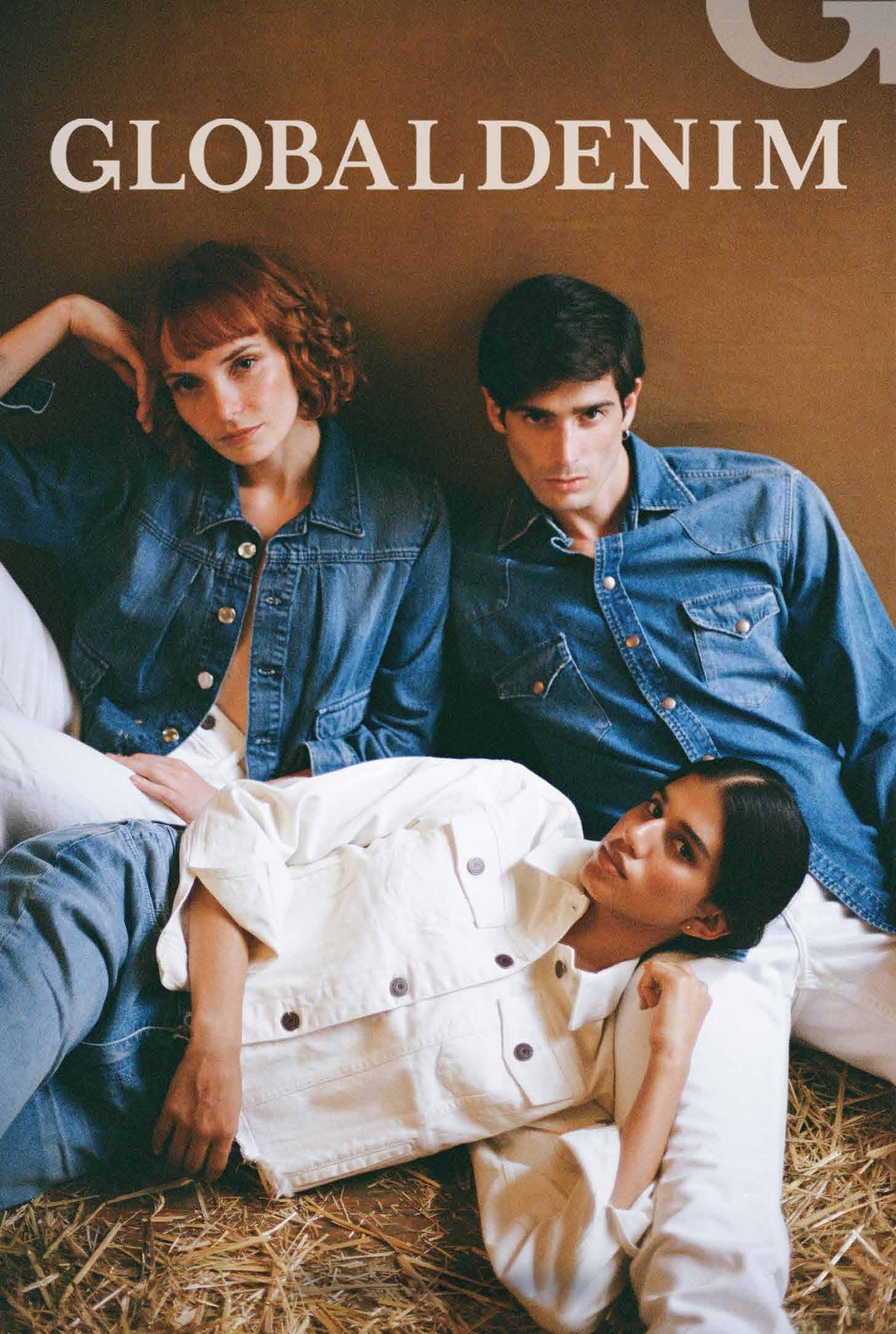

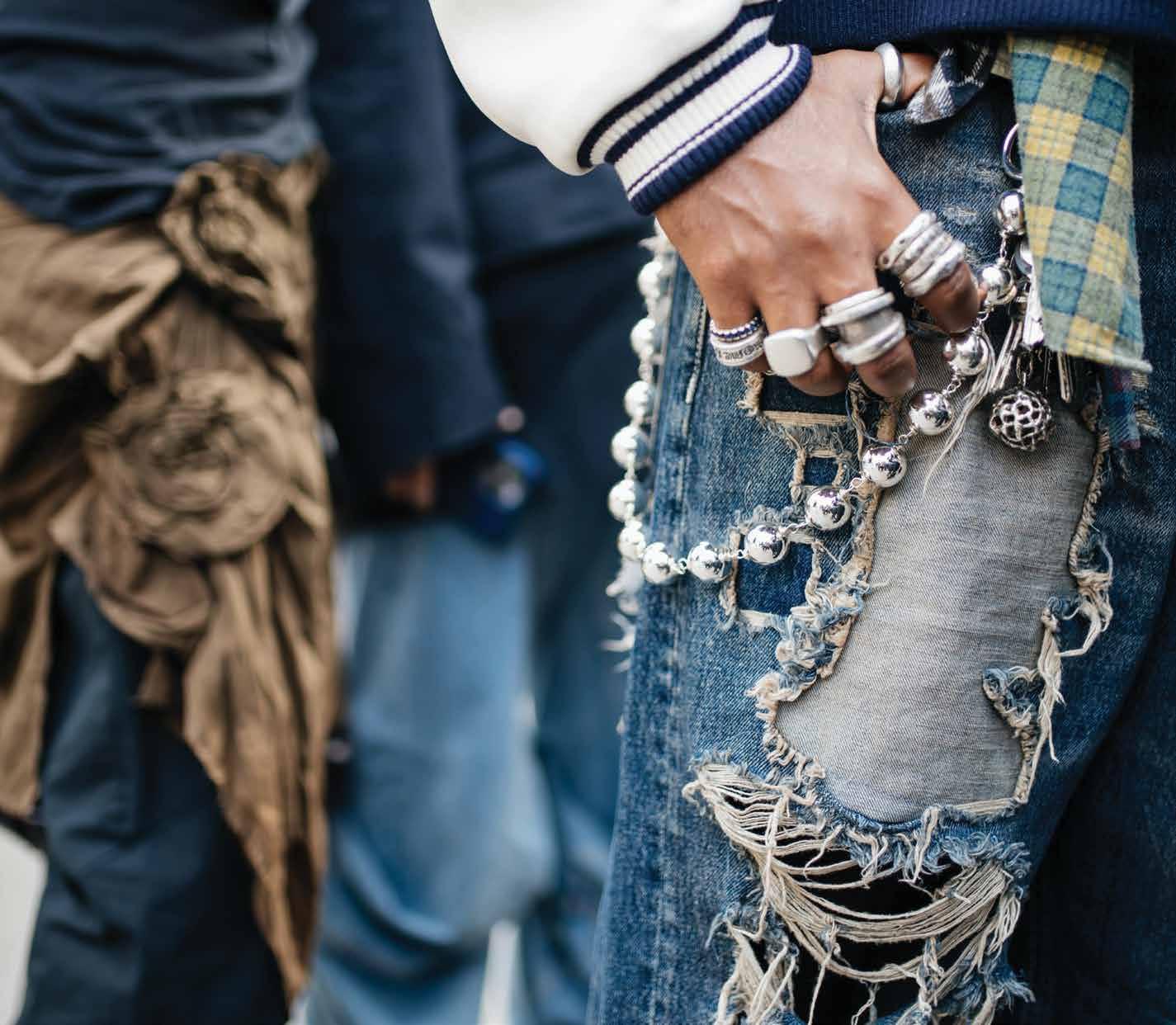
Trump’s
Trade show organizers are bracing for

The bohemian spirit of the 2010s is making a stylish comeback, reimagined with fresh touches of western flair, vintage charm


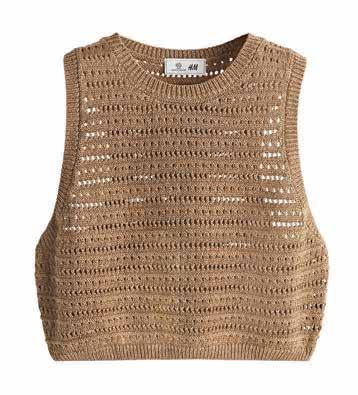
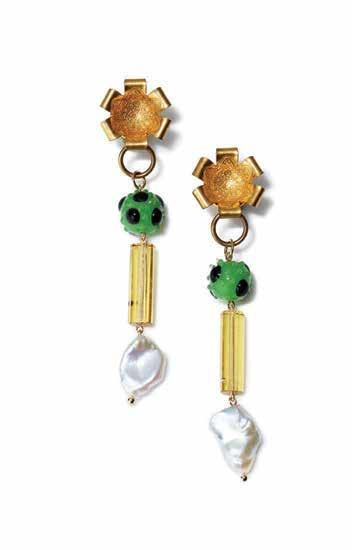
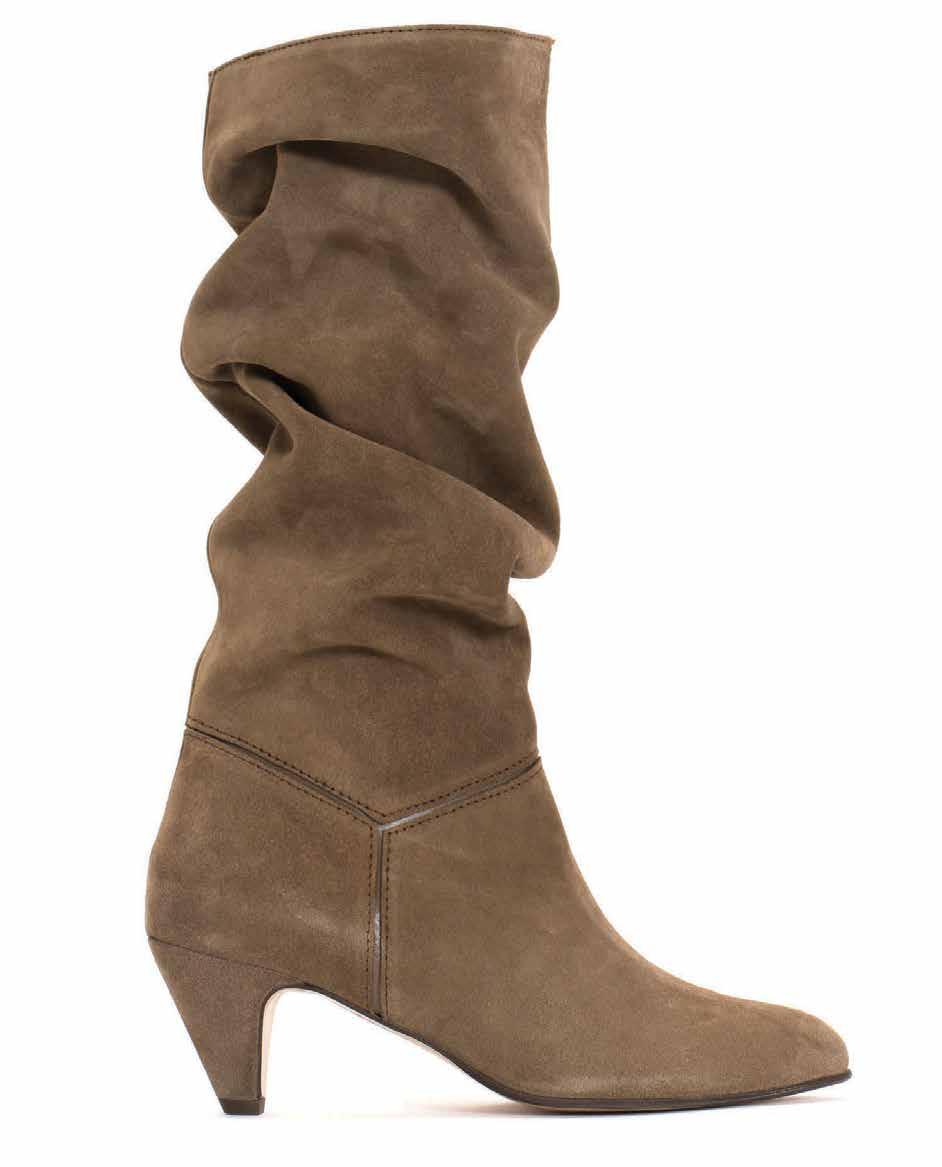

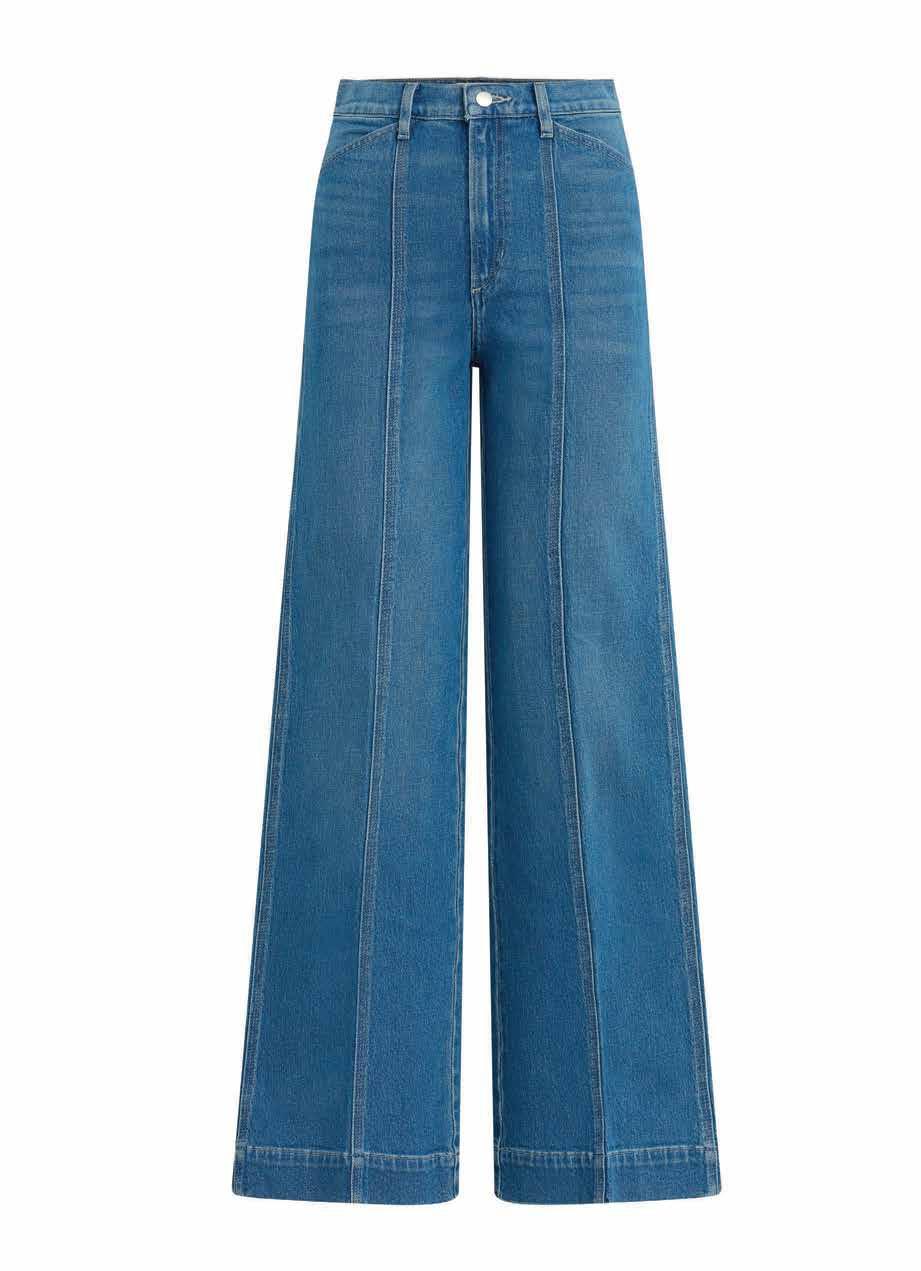


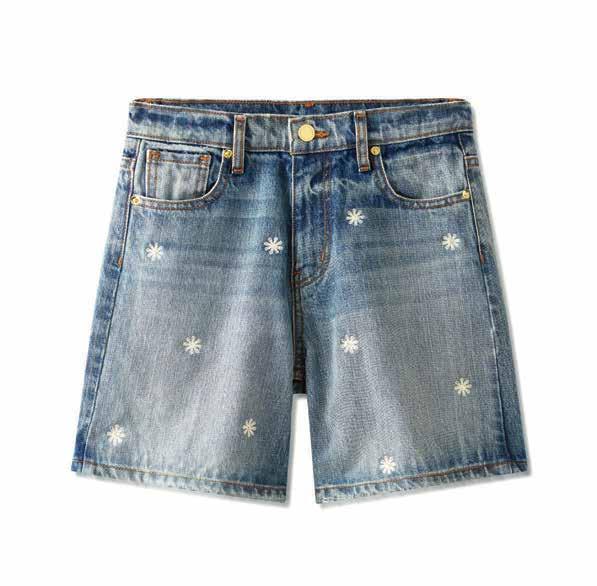


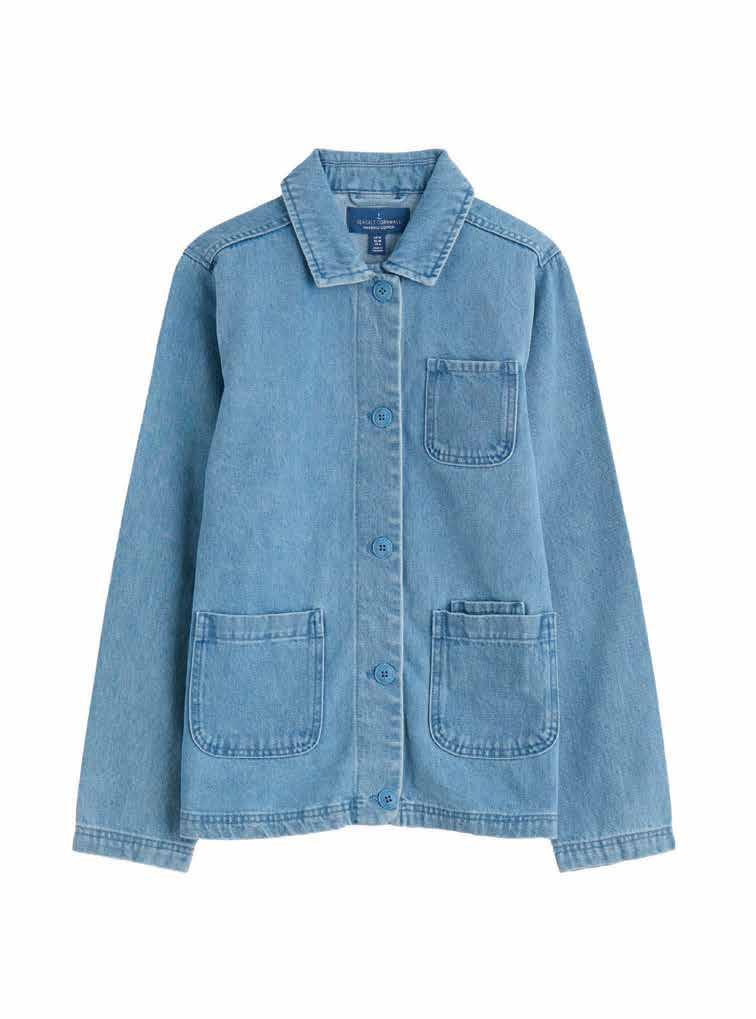


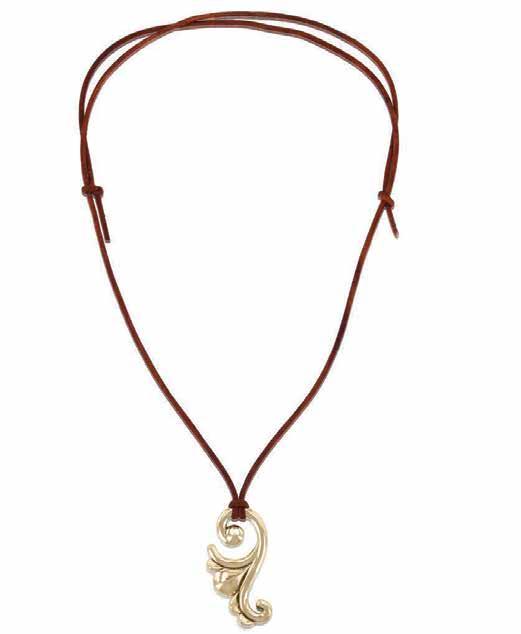
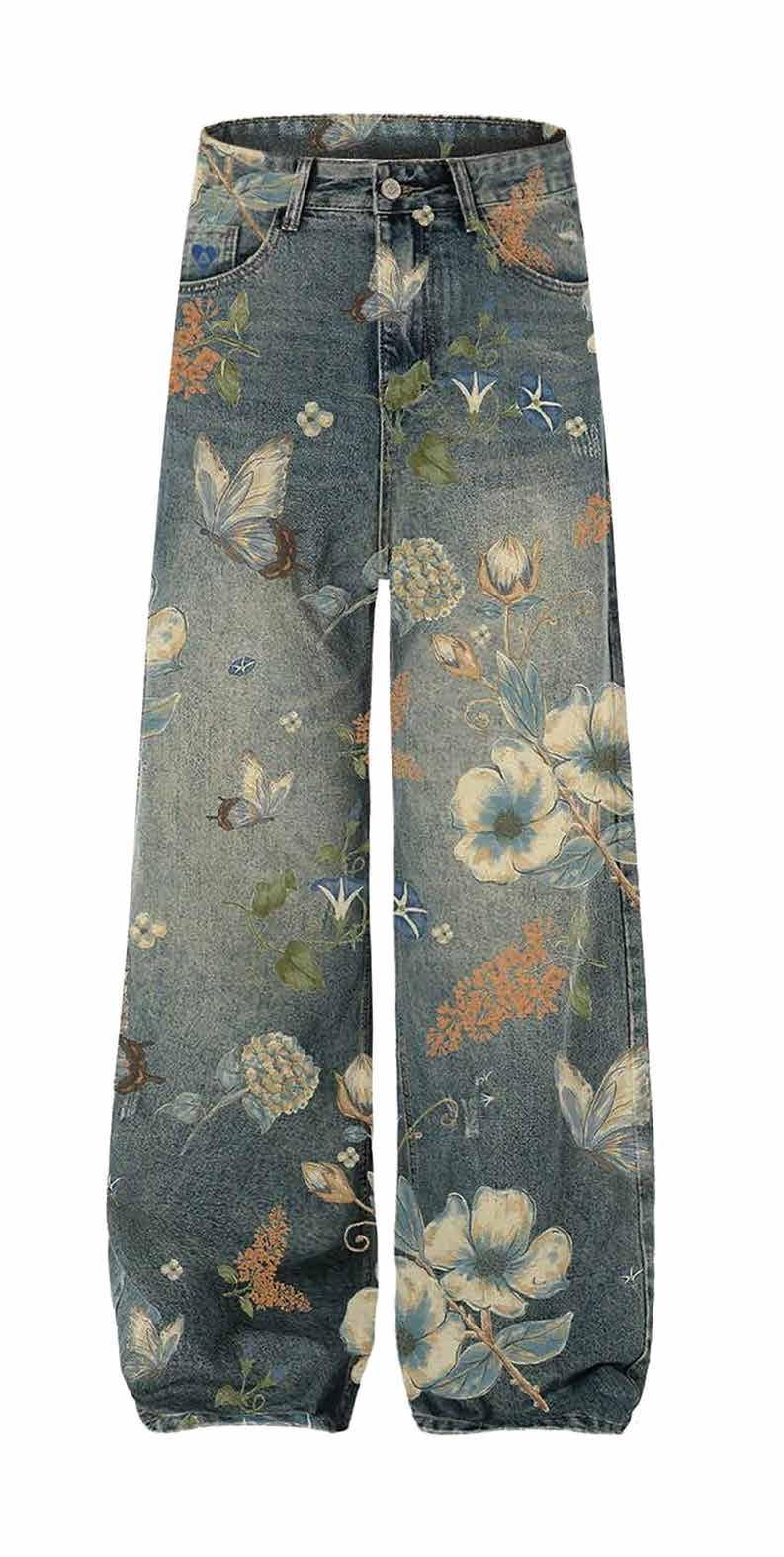





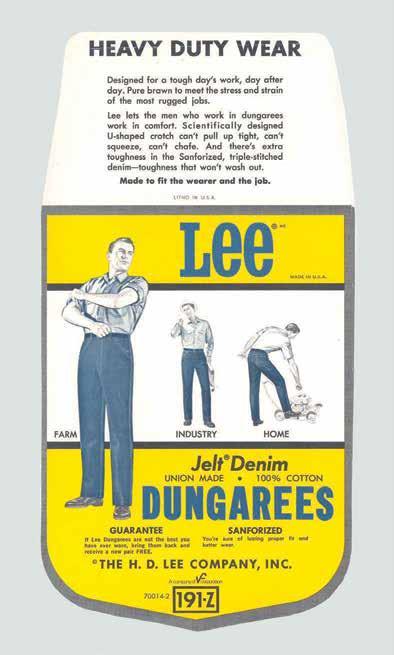
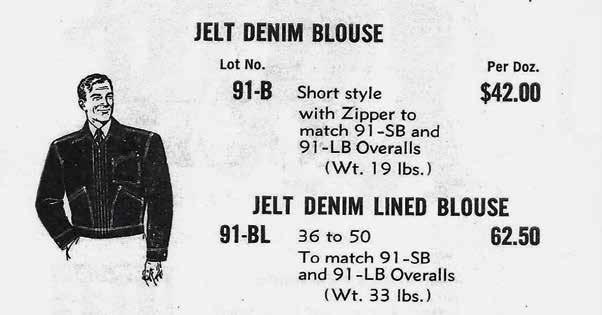
lee’s jelt denim turns 100 this year, highlighting the brand’s unwavering commitment to delivering garments built to last. The fabric is a reminder how consumers have valued durability and comfort since denim’s beginning.
In 1925, Lee worked with Canton Mills of Canton, Ga., to develop a fabric touted as “New Lee Denim,” a stronger, tighter weave for durable work and western wear. This 11.5-oz denim was made by twisting the yarn tighter than ever before and engineered as a tougher, stronger denim—harder to snag, tear or rip—and yet pliable and comfortable. In 1931, Lee renamed this fabric “Jelt.” The trademark was granted in 1933.
The fabrication was used in several of Lee’s iconic workwear products, including overalls and the 91-J chore jacket. In 1925, it was introduced to wear over Lee overalls. Jelt was also used in the launch of the 91B, a waist-length zipper-front work jacket with angled pockets, introduced in 1940 and consistently sold until 1982.
The strength and durability of the fabric was a key feature for advertising. In the mid30s, Lee partnered with American cartoonist Robert Ripley, showcasing nearly unbelievable feats all without tearing or splitting the fabric. The first photograph ad of the 91B also highlighted its durability.
The unique fabric has endured denim’s evolution from its roots as durable workwear to becoming a treasured addition to heritageinspired collections. Nowadays, the centennial fabric is reserved for select premium pieces, particularly new iterations of Lee’s heritage workwear, like the 91W jacket and carpenter pants, currently sold in Europe.
“While Jelt may not always be a featured part of our collection, it remains an integral part of our brand’s DNA,” said Frank Gilbert, Lee men’s senior designer. “Our goal is to honor its legacy while pushing the boundaries of design and performance, ensuring Jelt continues to evolve while staying true to Lee’s roots.”


www.pantherdenim.com
I’M CONTINUOUSLY WORKING TO REDEFINE FASHION BY MERGING ART AND CLOTHING, CREATING TIMELESS PIECES THAT CHALLENGE TRADITIONAL FASHION NORMS.” Raf Reyes, Veryrare
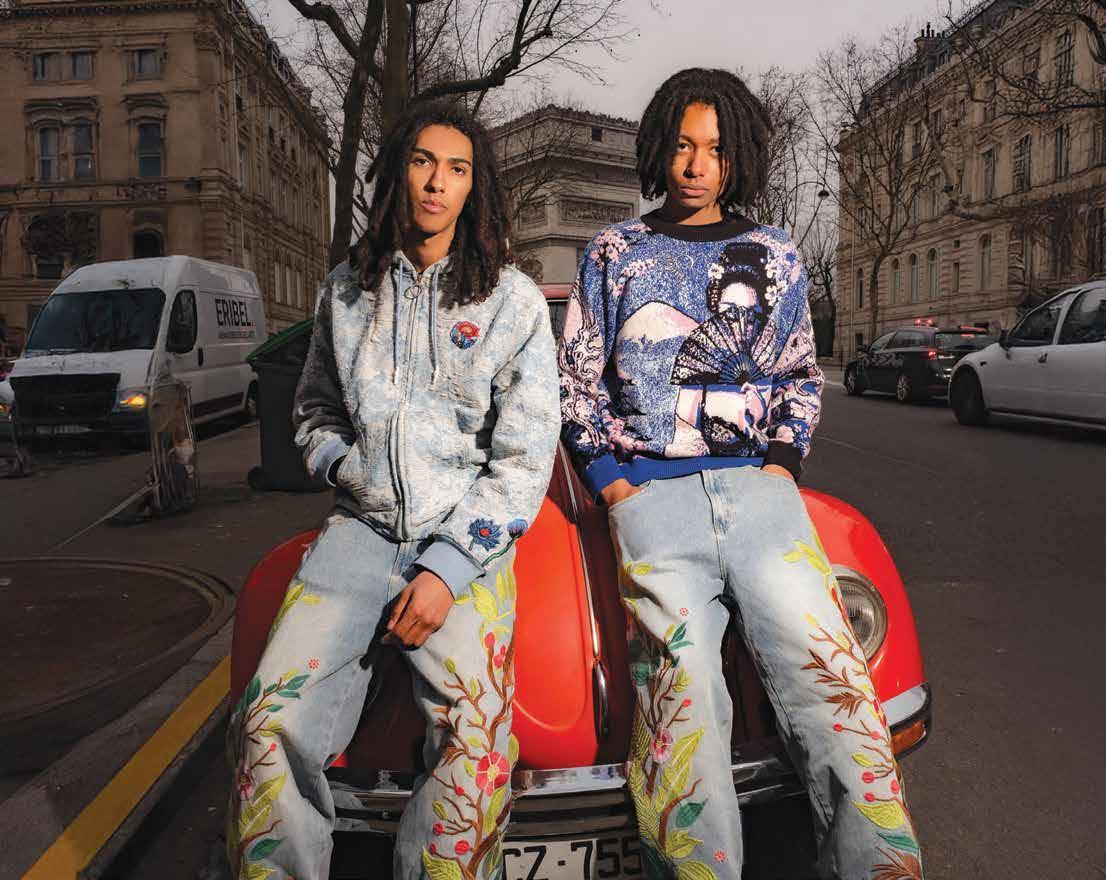
J. Cole-approved brand Veryrare is shaking up fashion,particularly with its unique denim pieces.
by Andre Claudio
veryrare is on a mission to revolutionize fashion with its “bold, fresh and reimagined” designs.
Founded by Raf Reyes, the Paris-based brand emerged in 2020 during the pandemic while Reyes was a postgraduate student at the Royal College of Art in London. According to the designer, the brand was born from a desire to merge art and fashion, creating pieces that “democratize art” by making it wearable and accessible.
“The concept behind the brand is to reference design’s history and signal its presence within the colliding worlds of archive and 21st-century fashion,” Reyes told SJ Denim. “Selected visuals feature various universes, ranging from collector ’90s aesthetics to contemporary subculture imagery. These elements are either amplified or stripped down to create a fresh and reimagined clothing style—where opposing ideas speak to one another—resulting in very rare pieces.”
Five years in and the brand has built a strong international presence, reaching customers in over 86 countries, with the U.S. as its primary market. This growth has been fueled by its online platform and partnerships with prominent retailers such as Selfridges in London, H Lorenzo, Wolf & Badger, Simons in Canada and HBX in Hong Kong.
This rapid growth has helped the brand gain
recognition from some of pop culture’s hottest names, including J. Cole, Jake Paul, Jaylen Brown, Lil Tjay, Rich The Kid and Famous Dex, to name a few.
“With my brand, I’m continuously working to redefine fashion by merging art and clothing, creating timeless pieces that challenge traditional fashion norms, [which is what] Veryrare consumers love,” Reyes said.
A key aspect of Veryrare’s buiness is its distinctive denim designs, which often feature “ultra-limited” lifestyle pieces that combine “intertwined narratives and visuals,” Reyes noted. Take, for example, the Sakura jean—made of 100 percent cotton—which features vibrant cherry blossom embroidery running up each side of the leg. Reyes said the $129 jean takes over 15 hours to hand-embroider, a process that incorporates various techniques, including chain stitch and piqué.
Veryrare sources fabrics globally, collaborating with textile associates in France, Portugal, Turkey, China and Japan. “We are committed to finding the best fabrics in terms of quality, durability and originality, ensuring each piece meets our high standards,” Reyes said. “We even know each of our denim artisans by name, visiting their weaving mills and dyeing factories regularly to ensure the craftsmanship and materials align with our [ethos] of transparency and authenticity.”

What’s one word to describe Veryrare? Unapologetic.
Who (or what) inspires your designs the most?
The global community, humanity, existence and the creative tribe—our mentors, the scenius, the collective genius of everything we’ve made and conceptualized since emerging from our Neanderthal caves.
• Coffee or tea while designing? Coffee.
What’s a guilty pleasure you have when it comes to fashion?
Indulging in maximalist designs and collaborating with friends (shoutout to Kiji Opera, my homie with the matcha tea saloon—we’ll be doing a matcha set/box together soon).
E Veryrare merges art with denim.
F E Veryrare founder Raf Reyes.
G Veryrare infuses denim with a rebellious spirit.
What’s the best compliment you’ve received about your brand? Being told that our pieces are timeless and inspirational.
• What’s your favorite city to visit for fashion inspiration? Tokyo.
If Veryrare was a music genre, what would it be?
Probably a fusion of synthwave, ambient, phonk, punk, indie, house, hip-hop/rap, jungle, DnB, UK garage, drill, trap and jazz.

What’s the most important thing you want customers to feel when they wear your designs?
All the pieces I release are designed to be worn like armor or second skins for the absurd reality we navigate daily. So flex them, rock them proudly. They say things you don’t need to express aloud; they speak for you.
Source: Cotton
2) Source: Marielis C. Zambrano
on

(2021).
p. 112030. https://doi.org/10.1016/j.marpolbul.2021.112030.
by Angela Velasquez
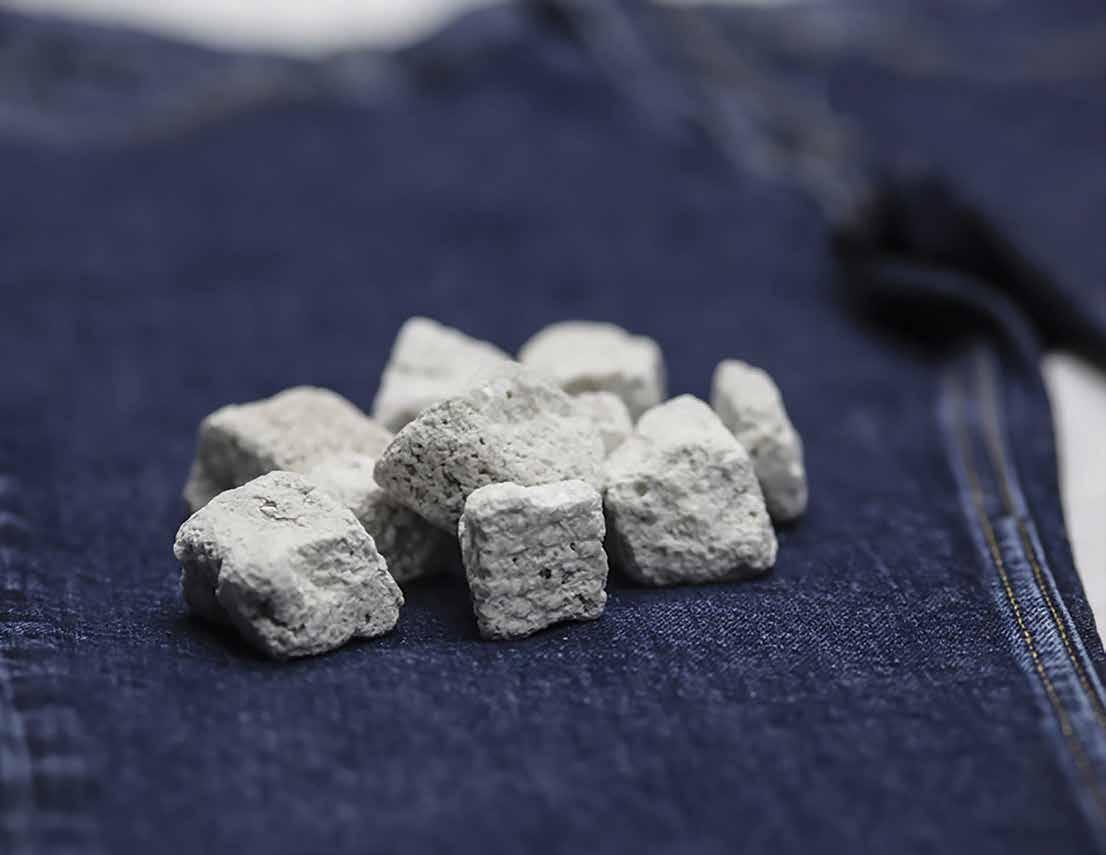
baytech-hms (Hand Made Stone) is settling into its first international office space in London.
In October, the Turkish supplier of ecological pumice stone alternatives, won first prize in the Techstyle for Social Good Global Innovation Challenge organized by The Mills Fabrica for its innovative and sustainable approach to denim washing. The grand prize includes mentorship from the sustainable materials science company Pangaia, complimentary office space in London, and incubation by The Mills Fabrica—support that’s providing valuable resources to propel Baytech-HMS’s growth.
SJ Denim caught up with Beyza Baykan, founder and managing director of BaytechHMS (Hand Made Stone), to learn how the company is leveraging its winnings to take their impact to the next level.
SJ Denim: What do you aim to achieve during the incubation?
Beyza Baykan: My primary goal is to leverage this opportunity to scale HMS into a globally recognized leader in sustainable denim washing solutions. Specifically, I aim to secure strategic funding, expand HMS’s reach in retail and manufacturing, strengthen our business strategy, enhance industry collaborations and build community and awareness. Ultimately, my goal is
to leave Mills Fabrica with a stronger network, increased adoption of HMS, and a clear pathway for long-term growth in both industrial and retail markets.
SJD: What have you learned from Pangaia’s mentorship?
BB: One of the biggest lessons we’ve learned so far is the importance of having a welldefined brand bible—a clear and structured identity that guides everything from our messaging to visual storytelling. This realization is helping us strengthen HMS’s presence and communicate our values more effectively.
SJD: What’s unique about denim style in London?
BB: Being in the Camden-King’s Cross area, steps away from Central Saint Martins, has exposed us to some of the most creative iterations of personalized denim. The influence of fashion students is undeniable—many have distinct, eye-catching styles. London street style is a mix of vintageinspired workwear, oversized and deconstructed silhouettes, and bold customization. Denim is a key staple throughout the city, whether styled in a bold, statement-making way or kept refined and timeless.
MY PRIMARY GOAL IS TO LEVERAGE THIS OPPORTUNITY TO SCALE HMS INTO A GLOBALLY RECOGNIZED LEADER IN SUSTAINABLE DENIM WASHING SOLUTIONS.” Bayza Baykan, Baytech—HMS
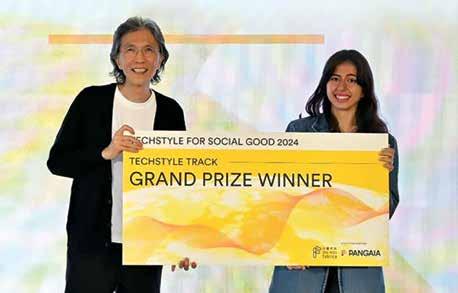
E Bayza Baykan colleted the grand prize.
E E HMS is a pumice replacement that disintegrates slower and requires less water and energy to use.
SJD: What’s next for HMS after this prize ends?
BB: Our focus is on scaling up sustainably by expanding our manufacturing capacity, securing key partnerships with brands and retailers, and driving the adoption of HMS as the industry standard in both denim and non-denim washing. We also aim to deepen our global footprint. While we already sell to many countries, there are key regions where we’d like to establish a stronger presence. So, who knows? After our London adventure, we might find ourselves in yet another part of the world.

Vintage Style Research Archive Vo. 1: The Golden Age of Hong Kong Vintage Collectors is the latest tome from U.K.-based denim consultancy Endrime. The 400page book features 70 rare styles from six Hong Kong collectors David Cheng, Patrick Sui, Gary Kwan, Kenny Chiu, Victor Chu and Ricci Lau—whom Endrime co-founders Mohsin Sajid and Sadia Rafique met while teaching denim design at the Hong Kong Design Institute in 2023.
“We were invited to dinner one evening, and after dinner, these collectors started pulling out vintage from their backpacks,” Sajid said. “I just stopped them, as I immediately recognized most of the pieces from denim and workwear auction sites. I was blown away by the quality of what this group of friends had collected. One of the collectors showed me his phone and scrolled through what seemed like a never-ending collection of incredible pieces.”
That evening, Sajid agreed with the collectors that Endrime would publish a series of books about the collectors. “We returned to Hong Kong soon after, hired a photographic studio, and started cataloging the Vintage Style Research archive,” he said.
Spanning denim, workwear, military, fashion, and rare denim scraps, each garment is accompanied by detailed descriptions and historical context in English and Chinese. The book is available at Inspiration LA and Kingpins Amsterdam. It will also be available on endrime. com in May. A second volume will publish April 2026. AV



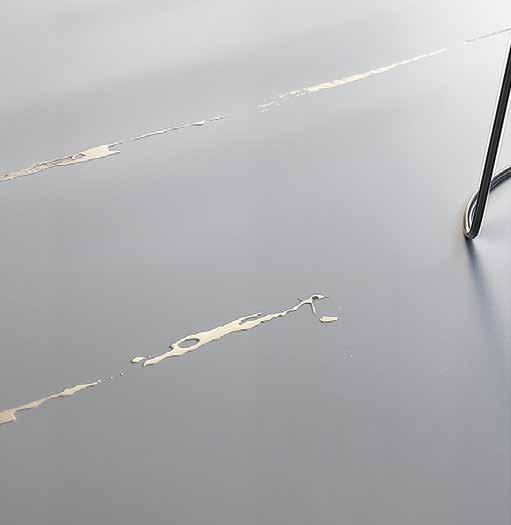








Kantamanto Social Group highlights the potential of sustainable fashion while raising awareness of the global overproduction crisis.

by Angela Velasquez

kantamanto social group is on a mission to repurpose a fraction of the textile waste discarded in West Africa and resell it to the Global North. c Founded by Anabel Poh and Daan Sonnemans, this innovative venture supports a diverse network of retailers, tailors, designers, and recyclers at Kantamanto Market in Accra, Ghana—the world’s largest secondhand clothing market. Through pop-ups and e-commerce platforms, Kantamanto Social Group showcases one-ofa-kind garments crafted from discarded denim and tapestries, while raising awareness about the harmful cycle of overproduction and overconsumption that plagues the fashion industry.
The marketplace is the product of a residency program with the Or Foundation, a not-for-profit organization working to develop solutions to fashion’s global waste crisis and the communities that are most impacted by it. The hybrid online program offers an in-depth exploration of the secondhand textile system, focusing on how vast quantities of clothing end up in Africa. Participants are encouraged to initiate small interventions in their local communities as part of the program.
“For us, we thought what if we sell these upcycled garments back to the consumer at a premium price to showcase the absurdity of the secondhand textile ecosystem,” Sonnemans said. “And that’s what we did, starting with a small exhibition in London.”
The Or Foundation estimates 15 million secondhand garments arrive weekly from the Europe and North America to the market. A community of more than 30,000 people working in the market is responsible for recirculating 25 million pieces of secondhand clothing every month through resale, reuse, repair, and remanufacturing. However, of the 15 million garments that enter Kantamanto every week, 40 percent leave as garbage because they’re too stained or damaged to resell.
DENIM IS OFTEN OF HIGHER QUALITY THAN OTHER MATERIALS MAKING IT A PREFERRED CHOICE FOR DESIGNERS WHO APPRECIATE ITS DURABILITY AND AESTHETIC.”
Though still in its early stages, Kantamanto Social Group reinvests all profits into developing the project. Sonnemans currently works with eight designers, with plans to expand. Communication with designers largely takes place via WhatsApp, and Sonnemans plans to return to the market this spring to strengthen these connections. Garments are transported using the “suitcase trade” method, where items are carried by individuals traveling between Europe and Ghana, helping to keep the operation sustainable despite its small scale.
The garments range from bleached denim kimonos to jean jackets featuring Marvel comic prints. Sonnemans explained that denim is often of higher quality than other materials like cheap synthetics, making it a preferred choice for designers who appreciate its durability and aesthetic, particularly for patchwork designs.
Support for the vendors has never been greater. On Jan. 1, an inferno of unknown origin devastated the market, killing two people and burning eight acres of stalls, or the equivalent of 60 percent of the market’s retail-facing side. More than 10,000 vendors have witnessed their livelihoods literally go up in smoke, including several of the businesses that work with Kantamanto Social Group. Two designers lost their whole shops, while others lost machinery and inventory. Sonnemans said some had to take out loans to buy new machines and have been struggling financially to get new materials to work with.
While selling one-of-a-kind garments online presents challenges— especially due to the variability in sizing—Sonnemans remains optimistic about the project’s long-term impact. He believes Kantamanto Social Group’s broader mission, to establish the market as a circular and sustainable fashion ecosystem, will resonate with consumers.
“I think it’s time to have communities like this take the lead in the conversation on how we should move to more sustainable, regenerative fashion,” he said.


most brands scale back when business slows, but Blackhorse Lane Atelier (BLA), the London-based smallbatch denim manufacturer, did the opposite by opening a second London store in SoHo last fall. c The new store is a response to the post-pandemic disruptions in denim retail and manufacturing and a strategic move by founder Han Ates to safeguard BLA’s workforce. During the pandemic, many brands faced supply chain breakdowns and turned to U.K.-based production, prompting a surge in orders. To keep up with the demand, BLA expanded its team, but as restrictions lifted, Ates said brands returned to cheaper suppliers in countries like Turkey.

“It was a business decision, so we found ourselves having to make one, either we were going to let people go, or we were going to be more creative and increase our own brand’s production,” he said. “With that, we decided to open another store in Soho, in order to look after our workforce really.”
The store is a showcase of BLA’s denim expertise as both a direct-to-consumer brand and a manufacturing partner. Around 70 percent of the products are BLA’s own denim, while 30 percent comes from small, likeminded brands from the UK and Europe with whom BLA has strong partnerships. Located at 96 Berwick Street, nestled among centuries-old buildings on the historic haberdashery street, the 700-square-foot ground floor is dedicated to jeans and fabric, while the 4,400-squarefoot basement houses BLA’s made-to-measure services. The first BLA store is just a 30-minute tube ride away in Coal Drops Yard. Ates steps away from BLA’s Walthamstow factory once or twice a week to visit the stores. He compares those days to a crash course on
customers’ expectations and lifestyles. “It teaches us so much like how they love the fact that the jeans are made in London. That’s important for them,” he said.
Providing top-tier service is also central to BLA’s mission of creating the best jeans in the world. By not hemming any jeans in advance, BLA ensures that customers can personalize the fit right in the store. “We create that kind of constant connectivity on the spot with the customer, so that we understand them a bit better. It’s a two-way street,” Ates said. “They see our professionalism and understand our quality.” That commitment to quality, combined with competitive price points, has resonated with consumers. BLA’s sales grew by 40 percent last
THEY SEE OUR PROFESSIONALISM AND UNDERSTAND OUR QUALITY.” Han Ates
year, and despite the high costs of producing denim in London, eliminating wholesale and retail profit margins allows BLA to offer Italian denim jeans for for 220-240 pounds and Japanese denim jeans for 280 pounds—prices that Ates notes would typically exceed 700 pounds through traditional wholesale channels.
The SoHo store serves as a key asset in BLA’s efforts to raise awareness not only for the brand but for higher quality denim. Ates said consumers are increasingly recognizing that they can purchase a pair of locally made small batch jeans crafted from premium fabrics at a price comparable to mass-produced options.
“I think people are more knowledgeable, and they really want to invest in good quality clothes,” he said.
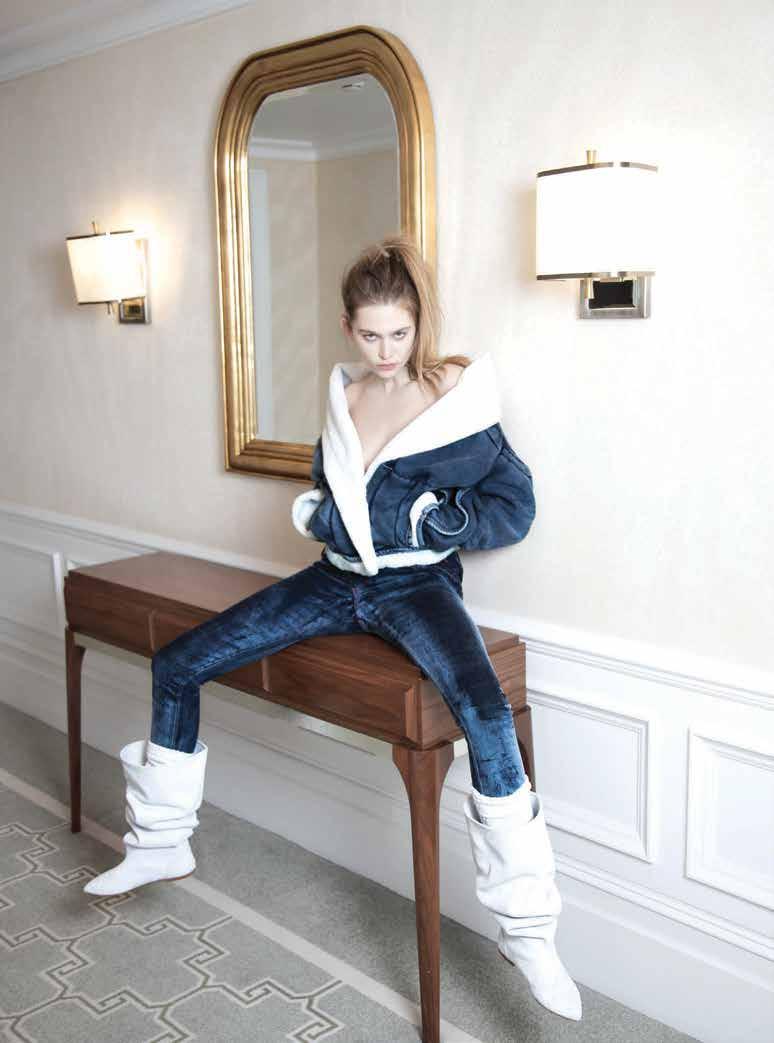
“there’s a certain intimacy in the details we’re not meant to see,” according to Ukranianborn, London-based designer Masha Popova. c With her Fall/Winter 2025 collection, the creative seeks to strip away the polished veneer inherent to dressing for public view, instead exalting the theme of “unfiltered dressing”—clothes that are “lived in rather than styled.” c Since launching her eponymous brand three years ago, Popova said she’s rarely stayed in one place for more than a few months, never fully unpacking. Her jet-setting lifestyle, along with stumbling upon a book by photographer Sophie Calle called “The Hotel,” fed into a desire to design a collection that feels ephemeral and maybe a little undressed.

“She was working as a chamber maid in a hotel,” she said of Calle, “and she was taking pictures of empty rooms while she was cleaning; unpacked suitcases and lipstick on the mirrors and all the things people have forgotten.”
Speaking with SJ Denim, Popova said she was inspired by “temporary spaces—how you make them your own and leave your trace behind.”
Bringing the feeling these images evoke to life, Popova’s line of womenswear, dubbed “Do Not Disturb,” features dynamic draping reminiscent of hotel curtains, a jacket cut like a bathrobe with an off-the-shoulder shawl collar and shirting with a texture like rumpled bedding.
While the line contains an array of garments—tops, dresses, outerwear and trousers—made with different materials, denim weaves its way through the collection like the protagonist of an epic odyssey.
“Transforming the garments and fabrications, for me, is one of the most
important things,” she said. “That’s why I really like denim, because it’s a very moldable, transformative fabric. It’s like an empty canvas, and we can reuse it through seasons and transform it, so it always looks different.”
Structure versus softness and the interplay between tradition and explorative new technique are on display across the line. Ever-present in Popova’s catalog, denim “is distressed, aged, and treated, shaping structured yet slouchy silhouettes.”
It’s a fabric she continues to come back to even as her perspective shifts with each new collection. “It’s in a way a sustainable approach, because by using these fabrics all the time, I never have unused stock,” she said. “I’m reusing it from season to season. And now I take the same approach with other fabrications.”
That approach is a unique one that sets her garments apart from the pack, even within the endless scroll of an online marketplace like

SSENSE or Revolve. It relies on the strategic lifting of color from the denim—whether it’s blue or a more unconventional hue—to create patterns and motifs that wrap around pant legs and swirl across shirts. The fabric is overlaid with hand-painted wax, shielding certain areas from treatment with dye and creating unexpected textures and aged effects.
“When I was still at school, I did some little tests, but obviously I had to do it at home with bleach,” she explained—a process she knew was unpolished, unsustainable and tough to replicate at scale. “My teachers were like, ‘Wow, this is exciting, why don’t you develop it more?’”
Following university, Popova worked with Italian denim finishing technology firm Tonello to develop her signature. “I learned the technical side of denim treatments with them initially; I just went down for a few days, and we were figuring out how to make my samples, but in sustainable way.”

“We tried different ways of doing it, like ozone laser and washing, and every season I try to take it further with different dyes and cold dyes,” she explained. “They’re amazing experts, they love the challenge. And we would always come up with amazing techniques.”
In addition to dyes and washes, Popova plays with texture, manipulating denim to mimic other fabrics. “I do reinterpret, for example, this season a bonded denim like a fake fur,” she said. “As we finish it, it looks like a shearling jacket.” The indigo, ecru and soot palette of the denim offering is complemented by the fall line’s more classic fabrics, like cotton and velvet, in metallics, washed blues, earth tones and neutrals.
While Popova used to produce her denim pieces in Ukraine and more recently London, she’s had to find new partners due to the ongoing war and the closure of denim laundries where she is now based. She’s recently made inroads with new producers in Spain but said
TRANSFORMING THE GARMENTS AND FABRICATIONS, FOR ME, IS ONE OF THE MOST IMPORTANT THINGS. THAT’S WHY I REALLY LIKE DENIM, BECAUSE IT’S A VERY MOLDABLE, TRANSFORMATIVE FABRIC.” Masha Popova

finding suppliers capable of replicating her unique approach, even on a small scale, is the most pressing issue with sourcing. “That was the biggest challenge: figuring out a new place that will be able to do our treatments,” she said. But navigating those hurdles can sometimes lead to discovery. “You know what you expect [from a process] and what you already know, you can sort of improve,” she said. “But the little things that come from mistakes are always the most exciting.”

denim took center stage in New York, London, Milan, and Paris, each city showcasing unique interpretations of this timeless fabric. In New York, designers highlighted dark washes, bootcut and ’90s skate influences, while London designers experimented with deadstock materials.
Milan’s offerings included low-rise jeans and embellished denim. In Paris, designers leaned into avant-garde approaches with material mixing and layered garments. Each city brought a distinct take on denim, from practicality and nostalgia to experimental and artistic designs.
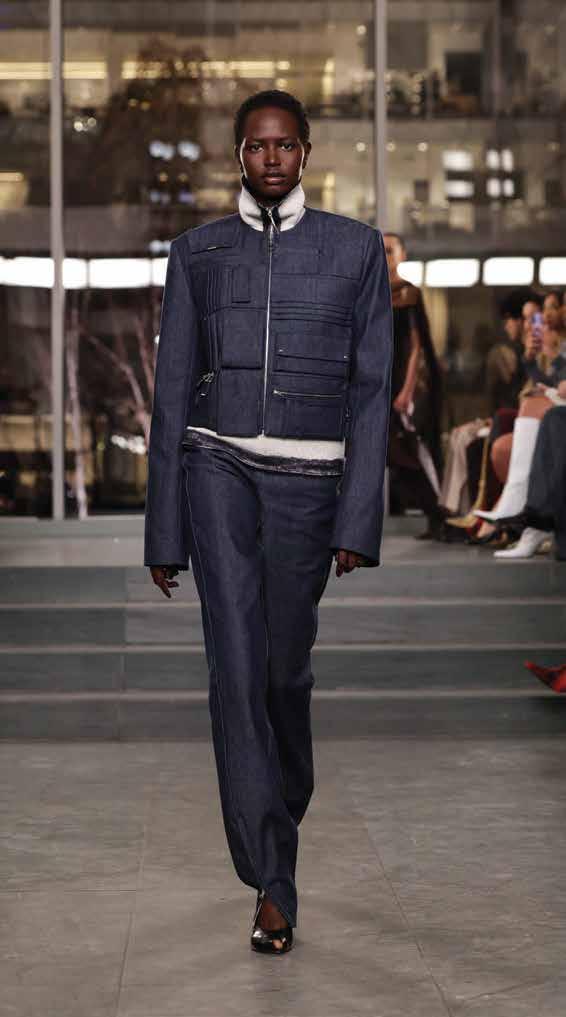
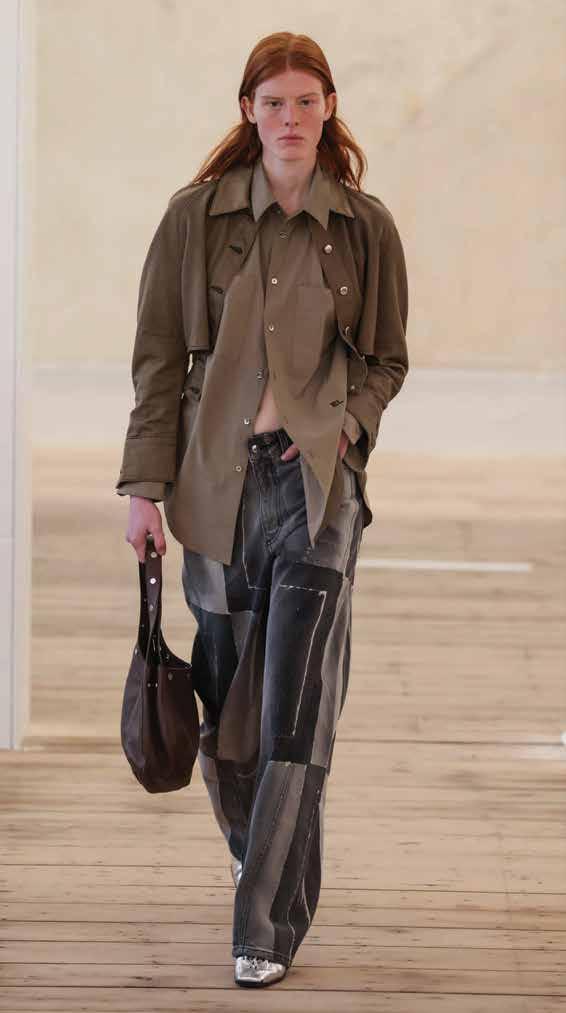
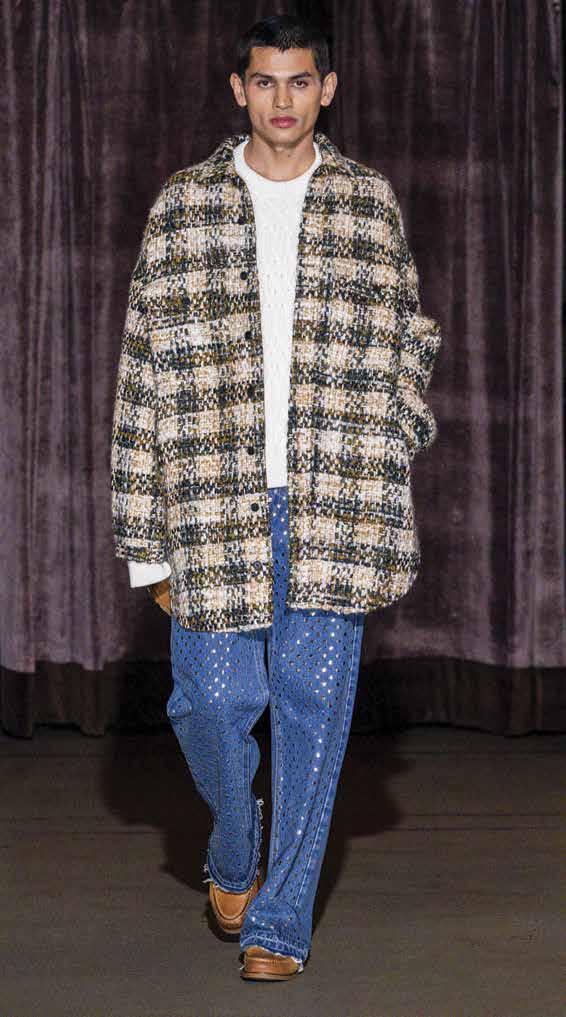

Ultra-wide-leg jeans, denim coordinates, and deep, dark washes made a striking impact at New York Fashion Week. Designers showcased their F/W 2526 collections, seamlessly blending denim with everything from elegant dresses to sleek minimalist suiting and cropped leather jackets.
Despite the slowdown of viral fashion cores and aesthetics, the New York runway was home to several distinct fashion tropes.
R13 delivered the fit of the moment—the bootcut—in a collection that introduced a goth element to the brand’s signature downtown New York vibe. Dark floral denim, inky blue slim jeans and cuffed and cropped jeans showed off witchy black boots.
The ’90s skate-inspired jeans in Coach’s presentation were crafted from repurposed secondhand denim. The mostly light wash baggy jeans puddled over sneakers adorned with charms and pompoms. Some were layered beneath 1920s style day dresses.
Sandy Liang kept the Polly Pocket aesthetic alive in a collection inspired by childhood. Fur trimmed the hems of ankleskimming jeans, a cropped jacket and matching miniskirt.
Cinq à Sept joined the boho revival with a collection of dark wash denim pieces styled with suede jackets, Penny Lane coats, studded belts and fringe handbags.
Dark wash jeans grounded several collections including Khaite and Tory Burch, which presented a structured utilitarian jacket. Ulla Johnson showed a dark jean caplet jacket and matching denim trousers. Tibi experimented with celestial dye effects on dark denim, as well as jeans that zipped off into Bermuda shorts.
Calvin Klein referenced French workwear with a faded blue jacket and jeans in its return to the runway. Black jeans and baggy light wash jeans were also part of the minimalist collection. Eckhaus Latta played with grayscales and presented an abstract interpretation of animal prints on jeans. Tanya Taylor continued to surprise with proportions with a range of vivid indigo denim.
F Skate
F Dark washes
F Boho
In London, emerging designers and established names took a bold departure from traditional denim.
Chopova Lowena continued to recycle folkloric fabrics and deadstock materials in a collection that referenced dream girls and the U.K. rave culture of the late ’80s. “Rebellious brightness” permeated the collection of pleated denim miniskirts and dresses, each adorned with childlike bands of beaded inserts. A denim skirt was layered over jeans—both trimmed with fur and decorated with punk patches.
Luxury streetwear designer Abigail Ajobi showed “I’m not English, I’m British,” a collection patchwork and warped tartan juxtaposed to dark wash denim pieces with unfurled seams. Silhouettes spanned flare jeans with center seam details to men’s paper bag waist jeans and jean shorts.
In his London Fashion Week debut, Jawara Alleyne stacked cargo denim shorts over jeans. Other styles in the collection called “Construction,” were made from deconstructed jeans with different washes, stitched and pinned together.
Following a lavishly embellished Spring 2025 collection, Simone Rocha dialed down the extravagance with pared-back denim pieces. A distressed denim jacket was cinched by a chain belt with an engraved padlock. A distressed midi skirt and shrunken jacket with pearl baubles shared a blue-gray wash. The denim was balanced by several black leather and fur looks.
Sinéad O’Dwyer, a semi-finalist for the 2025 LVMH prize, used a tinted blue-gray wash for several body-hugging looks as well. In a show that promoted body diversity, the silhouettes of bodysuits, collar-less jackets and jeans were emphasized by seam details and hi-low contrasts.
Gradient denim pieces that went from dark into to white were part of SRVC’s collection. Jeans and skirts were embellished with long straps and undone belts and styled with plaid shirts and deconstructed athleisure jackets.
F Deadstock F Ombré F Distressing

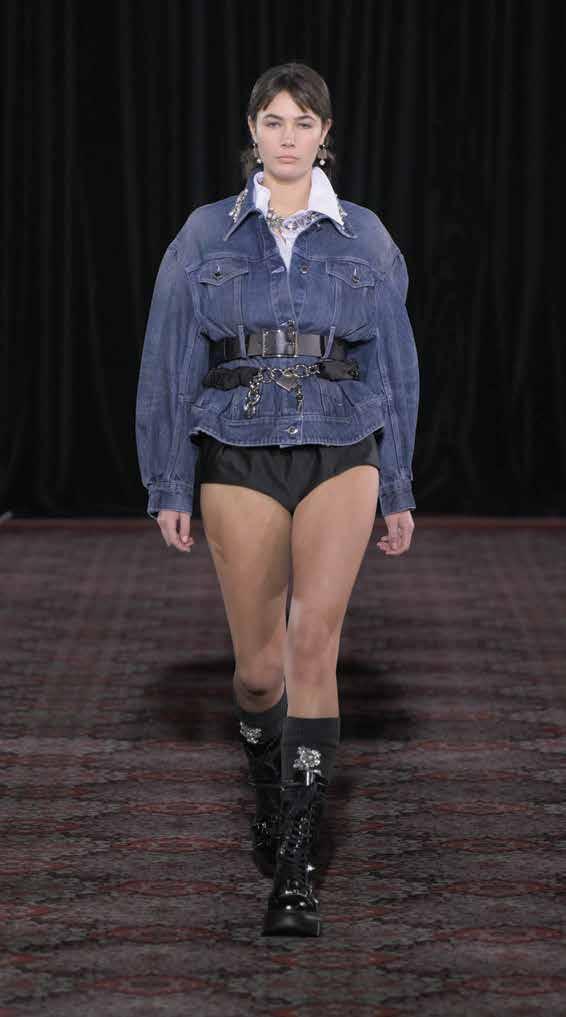
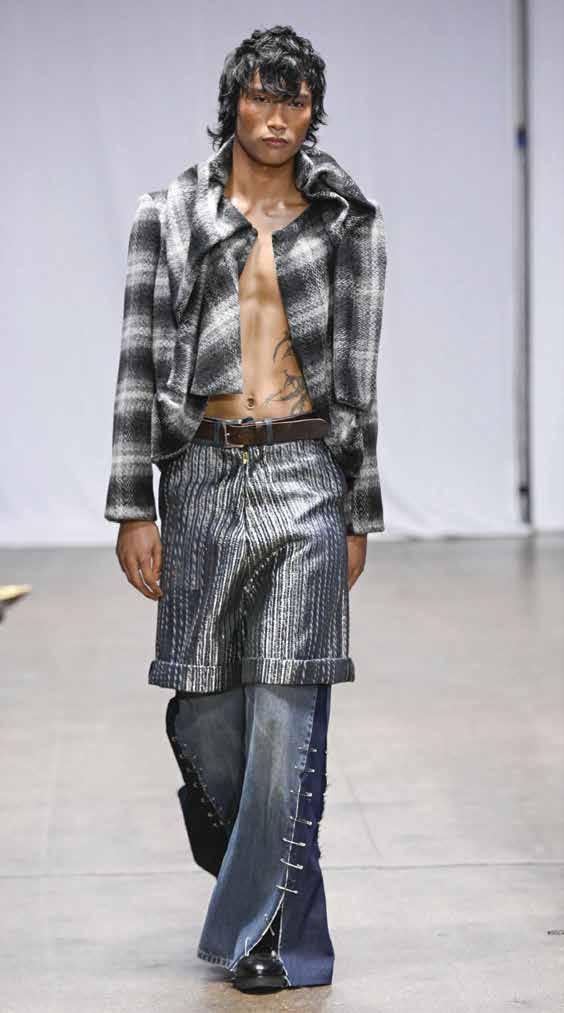

Explore Soorty’s AW2627 Collection, Denim Reflections.
Powered by the sun and the wind. Transforming waste. Empowering communities. Traceable by DNA marking & blockchain.



Denim was artfully woven into collections presented at Milan Fashion Week.
Some jeans were a blast from the past for millennials who grew up with low rises and flare fits in vogue. References from the aughties underpinned several collections.
Diesel delivered the week’s viral moment with its collection of bum-bearing low-rise jeans. In general, the collection balanced classic straight fits with extreme silhouettes like distressed denim hot pants and micro skirts. Jackets were often collarless; coatings mimicked the appearance of lamination and distressed houndstooth was carried through men’s and women’s pieces.
Dsquared2 celebrated its 30th anniversary with a collection that featured all the brand’s hallmarks, including glittery embellishments, paint splatter and brash washes. Jeans with peel-away constructions, shortshorts and skinny overalls with a micro bib were among the label’s boldest denim looks.
Italian cinema served as the blueprint for Blumarine’s dramatic denim pieces. Creative director David Koma decorated faded blue and black jeans with 3-D denim flowers made from the same material, cutouts and masses of silver metal hardware applied in organic shapes.
The mostly low-rise slim jeans flared over pointed toe stilettos and were styled with large medallion-like belts.
Denim broke up an abundance of black leather and silk prints Versace’s baroque collection.
Slouchy fits with grungy washes were embellished with baubles, distressing and color contrasting patchwork. Men’s jeans were finished with leopard print trim, crystals and clear sequins for a liquid-like shine.
Giuseppe di Morabito and Philipp Plein also showed crystalcovered jeans.
Ferrari and Federica Tosi experimented with washes with crinkled effects. MSGM added dimension to loose-fitting jeans with purple and yellow tints.
Colorful floral prints gave Etro’s denim pieces a ’70s flower child vibe. Vivetta and Ports 1961 kept denim traditional with inky dark washes.
F Bling
F Crinkle effects
F Low-rise



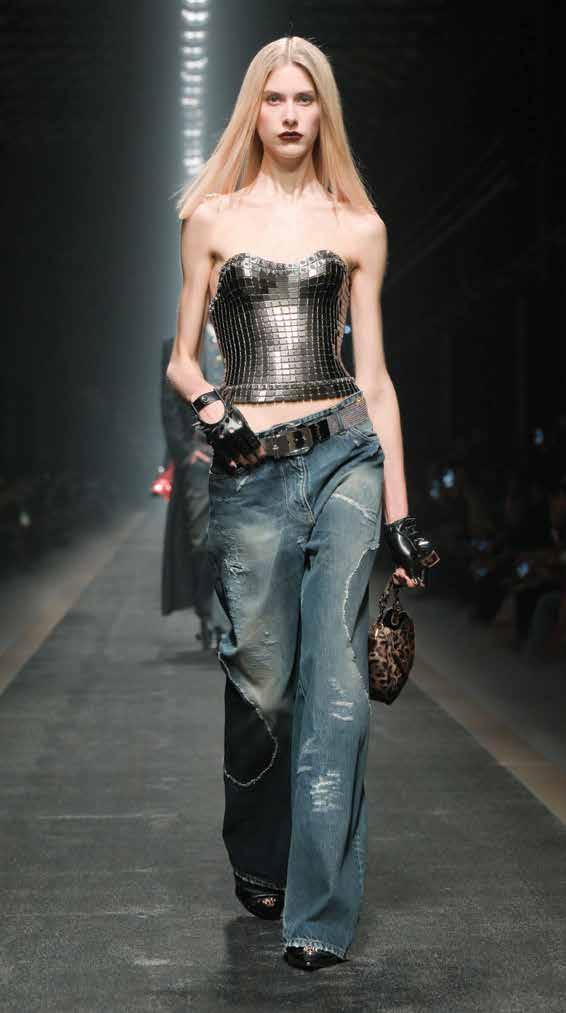

Designers in Paris leaned heavily on avant-garde silhouettes, textures and shadowy contrasts.
Material mixing made up part of Rick Owens’ tattered and frayed denim skirts and column dresses. Junya Watanabe spliced indigo jeans with swaths of black fur. Ukrainian designer Litkovska pieced denim with tailoring fabrics to create skirt and pant layers.
In a collection inspired by opulent and grand interiors, Ganni played with velvet-touch zebra denim, cozy knit denim and pearlescent denim. Skirts layered over baggy jeans created a peplum silhouette.
Ottolinger reimagined the basic skinny jeans with shadow pockets and pocketing and knee panels that peeled away from the body. In keeping with the bum-barring trend set a week prior on the Diesel runway, Duran Lantink showed bare back sculptural jeans that folded away from the body. Chanel married the transparency trend with denim prints.
Center seam details continued to trend thanks to labels like Gaucher and Alainpaul, which added undone hems to baggy styles. Sharp center creases highlighted the contrast washes Dice Kayek’s collection.
There were elements of near nostalgia in collections as well. Chloé maintained its bohemian aesthetic with split hem flare jeans. Coperni’s denim had an early 2000s vibe with tinted bootcut jeans, miniskirts and shrunken jackets. Isabel Marant brought a New Wave edge to men’s and women’s denim, mixing mini wrap skirts and vests with red tartan tops.
F Center seams
F Layered garments
F Opulent textiles
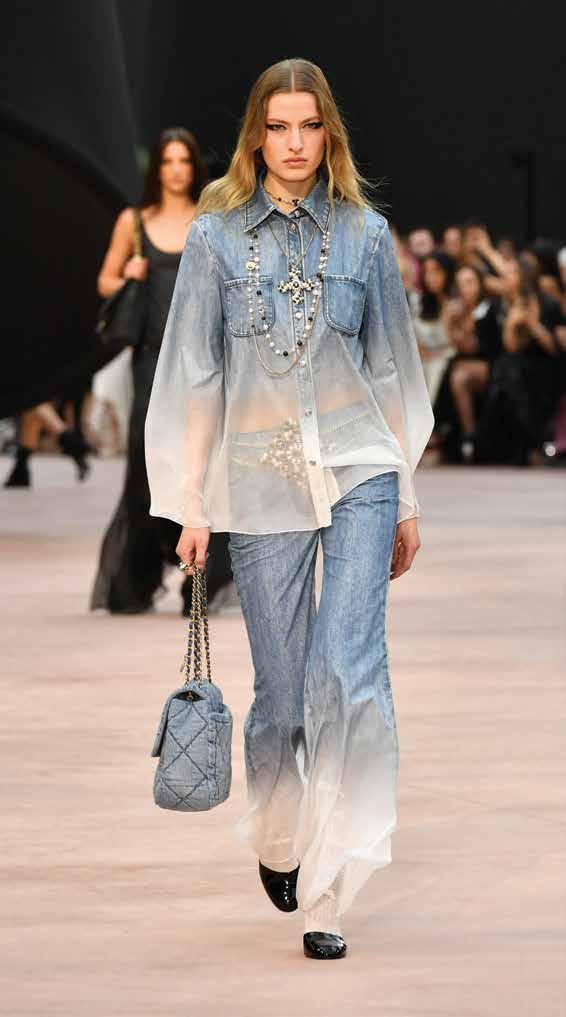
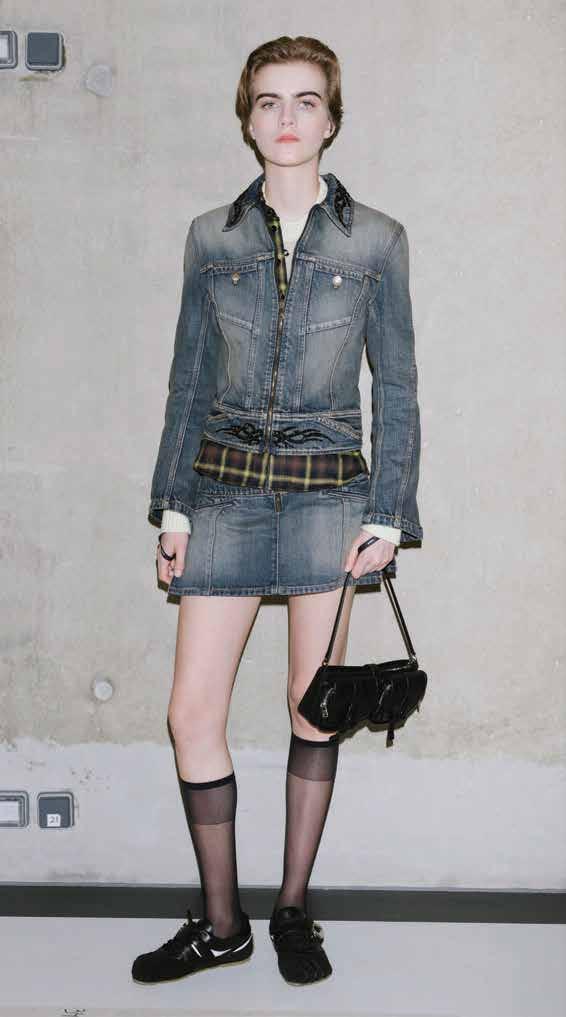
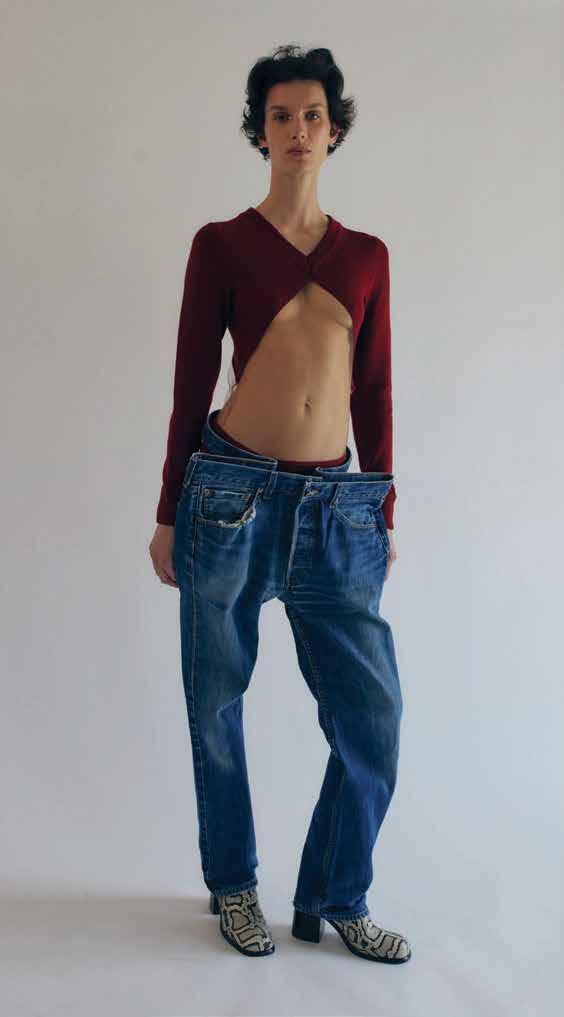
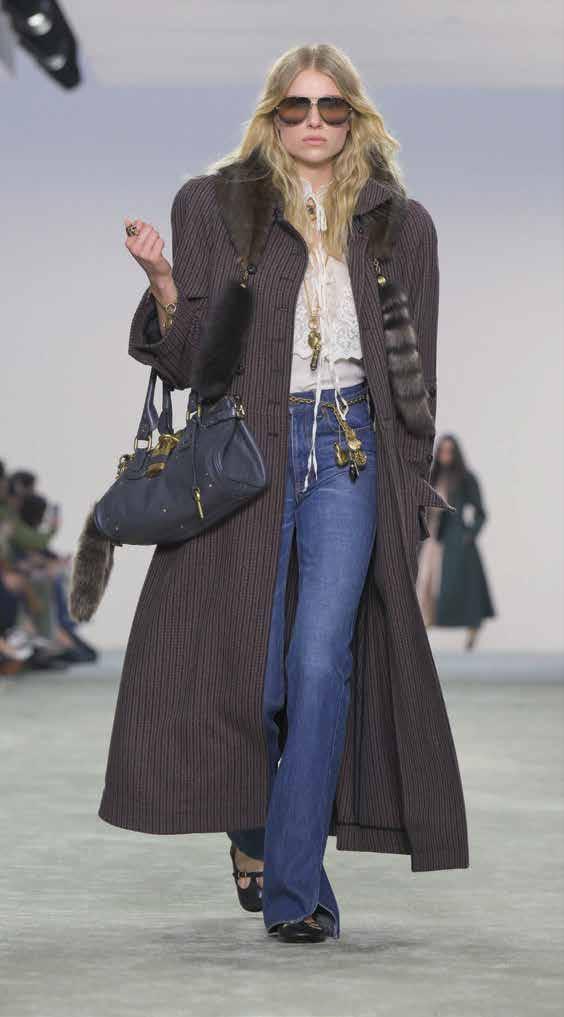
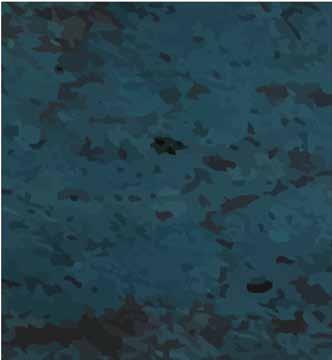

















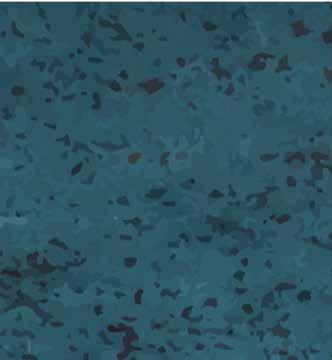
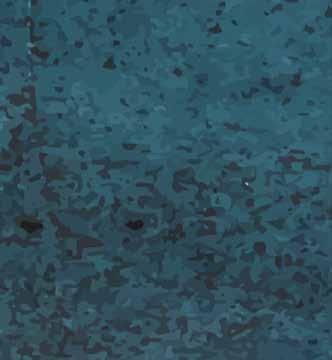







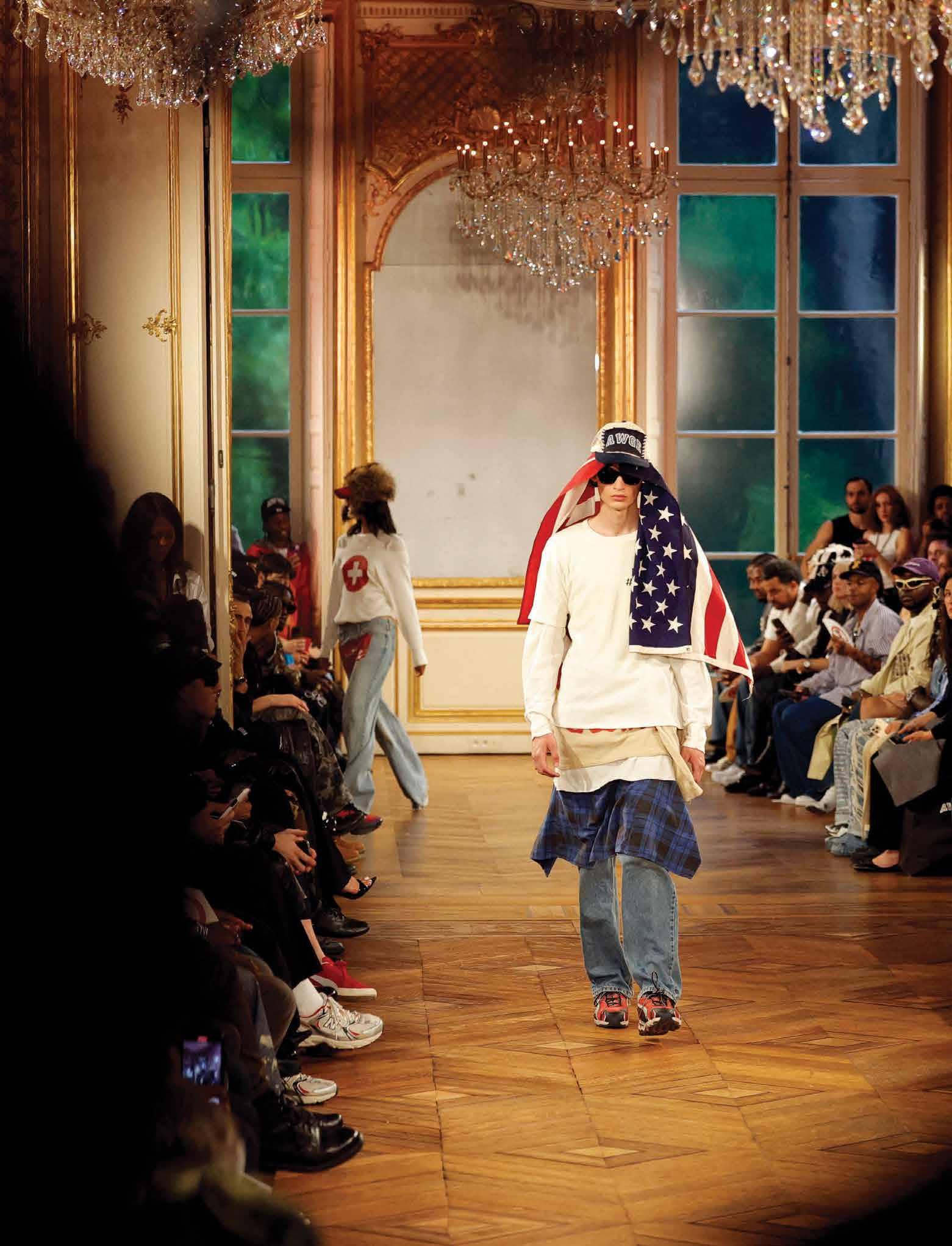

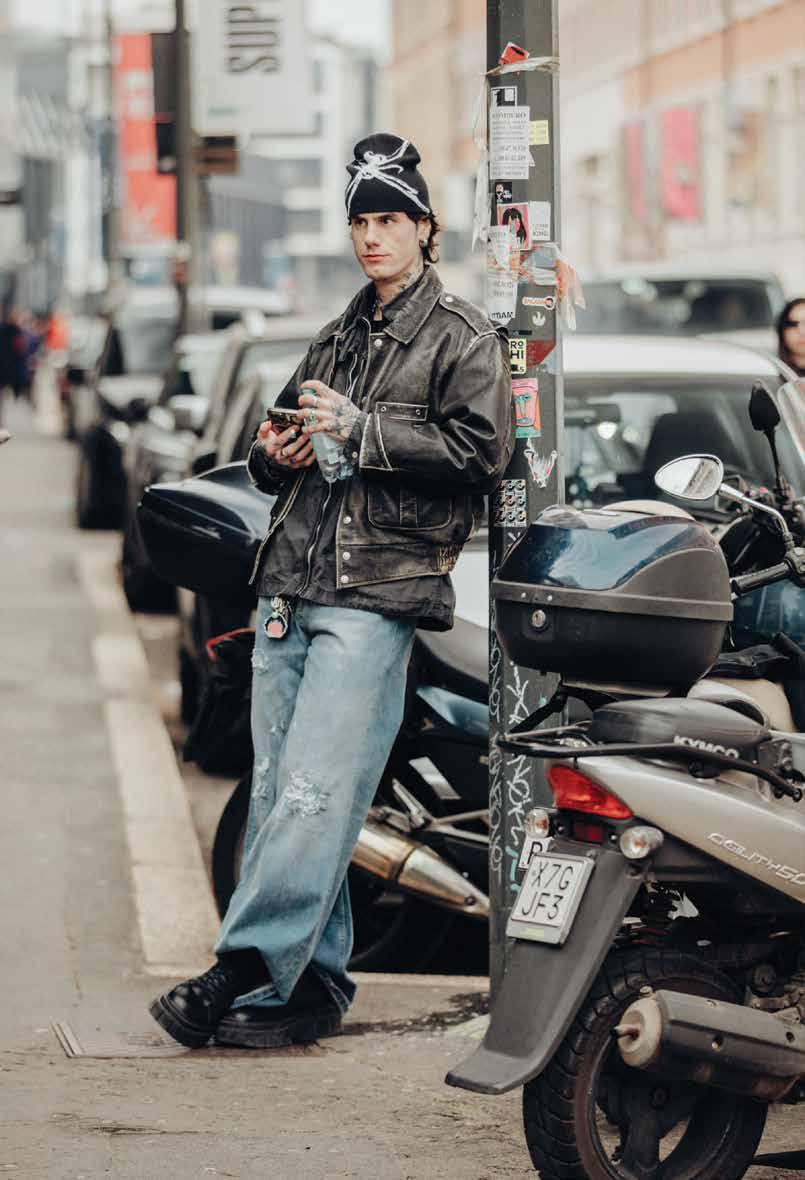
the evolution of fashion from offering comfort and security in 2020 during the uncertain early days of the pandemic to becoming an expression of joy and freedom in 2022 as consumers emerged from lockdown— perfectly illustrates how trends capture the zeitgeist. Denim, with its deep ties to cowboys, James Dean, and counterculture movements, frequently offers a window into the mindset of youth. From its rise as a symbol of teenage rebellion in the ’50s to its role as a canvas for political expression in the ’60s, and later its embrace by ’90s hip-hop culture, denim has consistently been at the forefront of shaping cultural identity. c Fashion responds to social shifts, but what happens when there’s no time to pause and take stock of unprecedented events? And how do brands navigate self-expression during a time of extreme divisiveness?
From an industrial and business perspective, Celik said global crises will push the denim industry in two main directions that will disrupt supply chain structures. “Political instability, trade restrictions and resource shortages will force brands to rethink supply chains. We need to expect more localized and close market production hubs to reduce reliance on unpredictable global markets,” she said. Secondly, brands are examining deadstock and circular denim solutions. Celik said these solutions will shift from niche to mainstream as businesses grapple with rising raw material costs and sustainability mandates.
“Nowadays, amidst conflict, fashion is trying to balance between function and expression,” said Ana Paula Alves de Oliveira, founder and strategic director of Be Disobedient, a denim and creative consultancy company.
Recent examples of street style reveal a shift toward denim with extreme silhouettes, DIY details and brash washes—perhaps a sartorial cry for help or a declaration of non-conformity in the wake of more demure trends like quiet luxury and trad wife. “We see distressed finishes, dirty dyes and worn-out textures evoking survival, alongside upcycling and material reuse as a response to scarcity. Simultaneously, deglobalization fuels a return to local craftsmanship, merging tradition with innovation. The industry is not just adapting; it’s redefining sustainability through necessity,” Alves de Oliveira said.

“We have been in a cycle of unprecedented times for some years now, the times just keep getting more and more unprecedented,” said Amy Leverton and Shannon Reddy of the consultancy, Denim Dudes. “Some sociopolitical figures are estimating that we are witnessing what is known as an ‘extinction burst’ which sounds terrifying, but for the more optimistic, it actually points toward the idea that what we’re seeing socially, politically and economically is the last major grasp at outdated ideologies and systems, and the tension we’re experiencing is essentially the growing pains before a transformation for the better.” This ideology is being applied to fashion as well, from the creation of new supply chains and the decline of aspirational purchases from luxury brands to consumers investing in one-of-one, small-batch designers that support individualistic style instead of viral micro trends. As news cycles, global affairs, legislation and technological advancements become overwhelming, Denim Dudes said consumers are retreating from the expectation to keep up with it all and turning their attention inward toward themselves and hyper local communities.
“Denim, at its core, has always been a mirror of societal shifts—whether it’s rebellion, resilience or reinvention. In a world currently on fire, denim won’t stay untouched. Denim has always absorbed the world’s tension and transformed it into wearable narratives,” said Sinem Celik, Bluprojects sustainability expert.
Denim Dudes sums up this feeling of global tension and polarization in Superpower Pivot, a Fall/Winter 2025-2026 theme that places designers’ heritage, opinions and experiences front and center.
American Sabotage—the brand AWGE, A$AP Rocky’s creative agency, presented at Paris Fashion Week Men’s last summer—is a visual example of the trend, Denim Dudes said. The collection featured American flag skirts, U.S. Marine jackets with restrictive silhouettes, and jeans with stacked waistbands.
“In the past we’ve seen brands, artists and consumers shy away from directly referencing political stances and letting their work speak and be interpreted for itself. Creatives are now not only directly vocalizing their viewpoints through their work, but they are also commandeering iconography typically associated with opposing viewpoints and re-writing the narrative around it and what it could represent in the future,” Denim Dudes stated.
The runway is an ideal stage to bring stories to life. GmbH founders Serhat Isik and Benjamin Alexander Huseby explore their heritage as Muslim immigrants in Germany in collections. Denim Dudes noted how they’ve been vocal about their heritage and beliefs when putting on runway shows, even aligning with the United Nations a couple of seasons ago. Mexican American designer Willy Chavarria played the audio of Bishop Budde’s sermon at President Trump’s inauguration during the finale of his Paris show in January, “giving grace and power to the immigrant and queer community,” Denim Dudes said.
“Fashion can be a really rich vehicle for symbolism and social signaling; these designers really lean into their platform in order to invoke positive change and unity in a time of division,” Denim Dudes said.
Christine Rucci, denim expert and founder of Godmother NYC, Inc., is less impress with recent efforts to subvert. “I think the division of runway, luxury, and streetwear has been blurred,” she said, adding that most fashion houses are making inauthentic dupes of denim worn by youth culture or made by small designers.
What it lacks, she said, is the outspoken political activism of designers like Katherine Hamnett, Vivienne Westwood, Claire McCardell and Franco Moschino.
Alves de Oliveira argues that disruptive fashion can be subtle. Stella McCartney seamlessly blends sustainable materials with red carpet-worthy designs, with the only noticeable clue of the designer’s passion for the environment being the adorable animals featured in her ad campaigns.
“In this century, Stella McCartney is the undisputed leader in turning fashion into a manifesto for innovation and sustainability. She has set the standard for how responsibility, ethics, and creativity can coexist, proving that well-communicated values become powerful industry drivers,” Alves de Oliveira said.
On the other hand, Alves de Oliveira said Ukrainian denim designer and Adidas collaborator, Ksenia Schnaider, embodies resilience as her country remained embattled in a war with Russia. “Operating between the U.K. and Ukraine, her brand transformed crisis into strength, proving that fashion can be a direct response to geopolitical reality,”
Alves de Oliveira said. “Both illustrate that transparency, honesty, and purpose are not just possible, they are essential. And both are women, which speaks volumes.”
Off the runway, social media has become the de facto platform for brands to address social and geopolitical issues.
In 2022, following the U.S. Supreme Court’s decision to overturn Roe v. Wade, several women’s denim brands took to social media to voice their opposition. Brands like Good American, Frame, Citizens of Humanity, and Madewell publicly expressed their dissatisfaction with the ruling and shared resources advocating for reproductive rights.
Under Chip Bergh’s leadership as president and CEO for 12 years, Levi Strauss & Co. (LS&Co.) emerged as one of the fashion industry’s most outspoken advocates, championing causes such as gun violence awareness, reproductive rights protection, voting rights protection and LGBTQIA+ equality. “Saturday Night Live” poked fun at the denim giant’s wokeness in 2017 with a spoof ad featuring cast members dressed in ill-fitting gender-free jeans. The company also regularly faced backlash from the NRA for
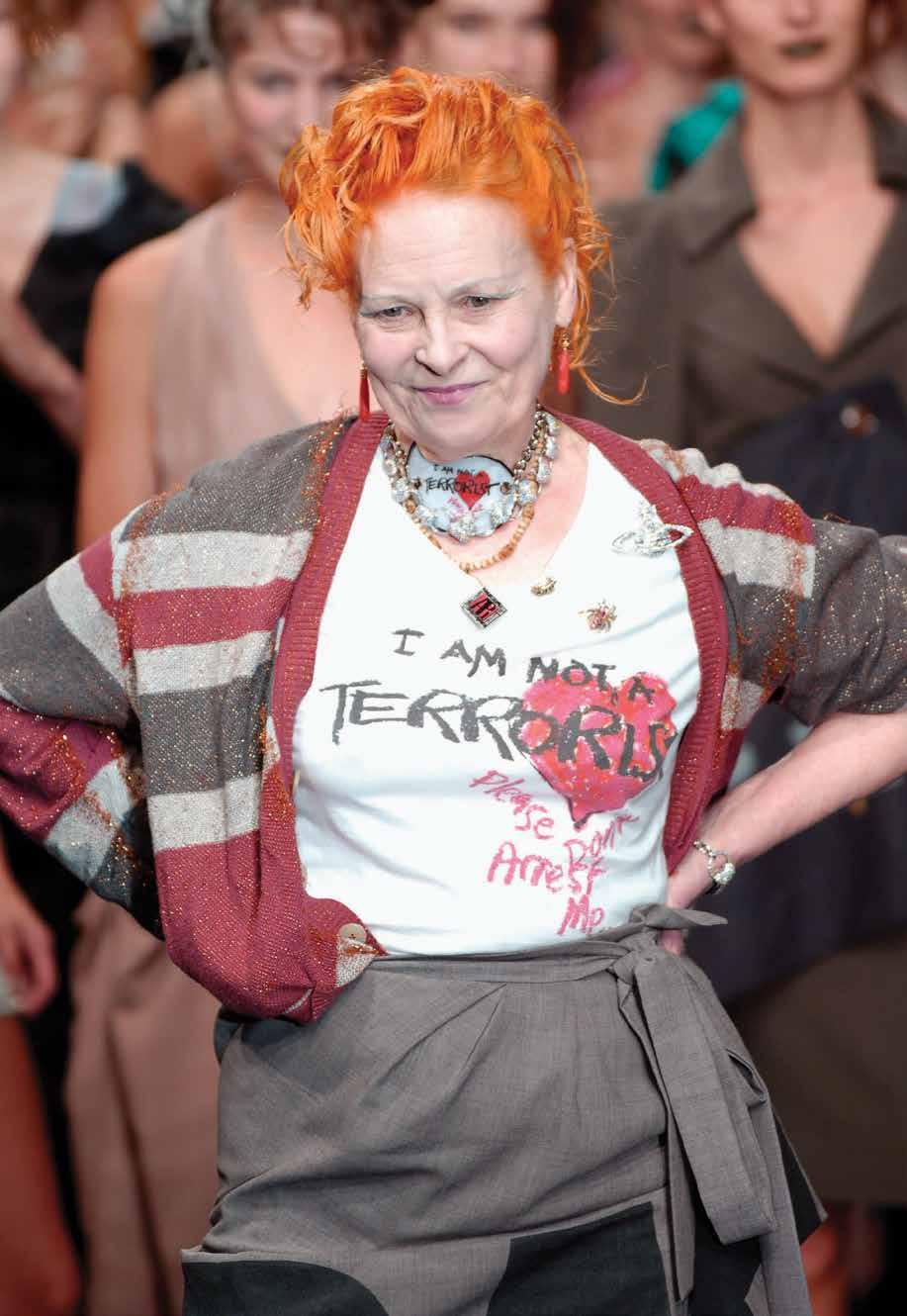
DENIM, HAS ALWAYS BEEN A MIRROR OF SOCIETAL SHIFTS—WHETHER IT’S REBELLION, RESILIENCE OR REINVENTION. IT HAS ALWAYS ABSORBED THE WORLD’S TENSION AND TRANSFORMED IT INTO WEARABLE NARRATIVES.” Sinem Celik, Bluprojects

its left-leaning opinions on guns. In an exit interview last year with Sourcing Journal’s sister publication WWD, Bergh said, that “navigating divisiveness” and geopolitics had made his job more challenging.
LS&Co. has seemingly stepped off the proverbial soapbox since Michelle Gass’ takeover in early 2024, choosing to focus on more bi-partisan topics like voting registration, and promoting its nostalgic ad campaign with Beyoncé.
“Brands are becoming more selective in their activism, navigating hyper-polarization and economic risks. While Levi’s may no longer make sweeping statements, its commitment is evolving—moving from loud declarations to tangible actions,” Alves de Oliveira said. “The key is authenticity. Empty messaging is no longer enough; brands that align their actions with their values will remain relevant and influential.”
G

Celik anticipates that there will be some disruption on the branding and marketing off and greater shift toward activism and transparency. “More brands will align their messaging with socio-political themes, positioning denim as a statement—whether through war-time aesthetics (militaryinspired, patchwork, survival gear) or messages of unity and resilience,” she said. “Transparency will become non-negotiable. With heightened consumer awareness, brands will be forced to show proof of ethical labor practices, material sourcing, and true circularity rather than just greenwashing.”
Indeed, turmoil is not a time for brands to fly under the radar or abandon activism in it’s many forms. Target, which announced in January that it would end its diversity, equality and inclusion initiatives, has become a target of a 40-day boycott, a lawsuit from shareholders and a diatribe of comments on their social media accounts. Over the last 12 months, Denim Dudes said there’s been an unprecedented amount of brand and product-specific boycotts, mindful purchase worksheets going viral on social media, and an uptick of content focused on ethical retailers to support, and ones to avoid.
Instead, Alves de Oliveira said companies must learn about the issues that affect their customer base, engage with consumers through authentic dialogue, and practice active listening. “Those who do will not only remain relevant but will also shape the industry’s future,” she said.
In an era of heightened visibility and exposure, where social media amplifies calls for cancellation into powerful nationwide boycotts, and tolerance for differing views continues to diminish, Alves de Oliveira remarked that every statement now carries a double-edged sword. Yet, she emphasized, “Avoiding reality is not neutrality; it’s willful blindness.”
“Fashion has always been a means of communication, and denim is not an exception. In times of crisis, brands with a solid audience have the opportunity and responsibility to foster meaningful conversations,” she said.
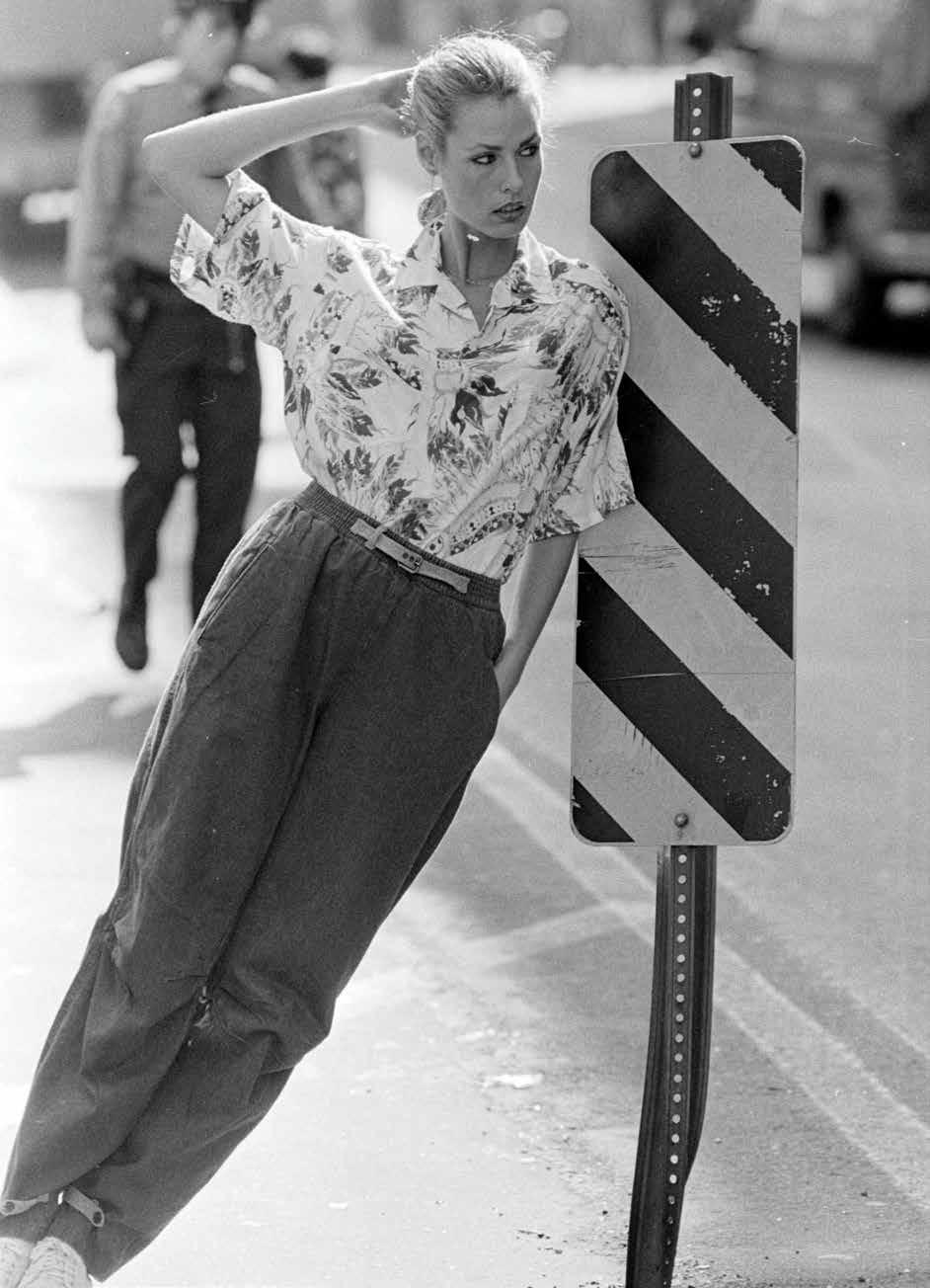
baggy, designer, artisan —those are just a few themes that have disrupted the industry, transforming blue jeans from durable workwear to statement-making fashion. How they’re executed has changed with the times—influenced by the ideas of new generations and talent—but they continue to be symbols of denim’s evolving style. Here’s a look at how out-of-the-box ideas continue to transform jeans.

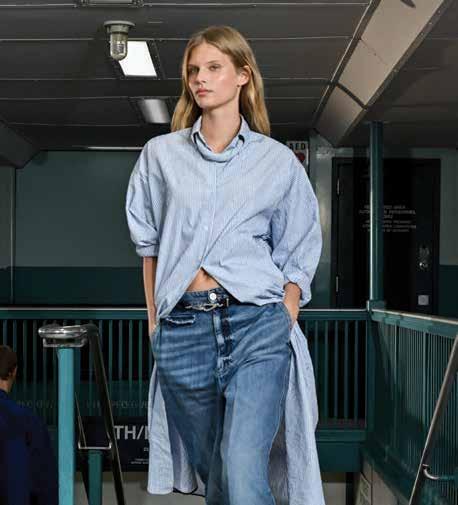
French designers Marithé Bachellerie and François Girbaud, who introduced the first baggy jeans to fashion at the beginning of the 1980s, were at the forefront of denim and jean style innovation. Produced in Italy, under the brand label, Closed, the baggy jean replaced the disco era’s tighter fits and was a welcomed change for consumers in the U.S.
The style wove a new frontier in denim, inspiring a multitude of new fits and styles still seen in the jean category today. The trend has come and gone and come back again, now with runway appeal and streetwear edge as the go-to jean fit for a generation that values comfort and fashion.
1 Baggy jeans by Marithé et François Girbaud for Closed in 1979.
2 Baggy jeans from Tommy Hilfiger’s Spring 2025 ready-to-wear show.
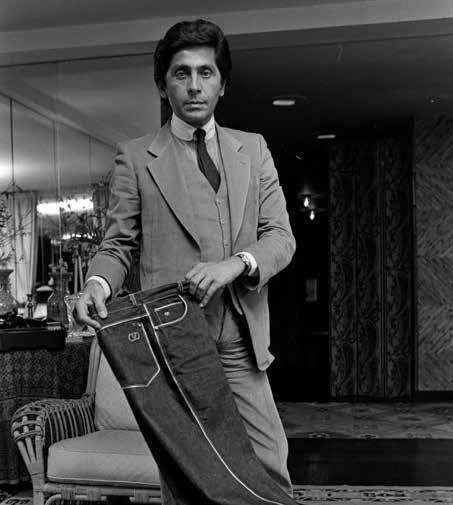

Logo Mania
The lasting impact of the designer denim revolution may hinge on one key aspect: branding. Calvin Klein was the first to rally the industry around more stylish branded elements for fashion-conscious women. His straight cut, slim fit, dark blue jeans hemmed perfectly for strappy high-heel dancing shoes were perfected for the moment. However, the pocket size and placement, with the signature loop stitch and designer label sewn at the top edge of the right pocket, immediately carved out a niche category in fashion.
Up until that point, branding served a more functional than fashionable purpose on many women’s jean styles. Noted fashion labels including Valentino and Pierre Cardin, and emerging jean brands like Sergio Valenti, Fiorucci and Bonjour, to name a few, followed suit, assisting the creation of what is now a global billion-dollar industry. The signature pocket design and branded label served as an ID of distinction. Decades later, designers are amplifying their logo with head-to-toe prints. Elevated by the next generation of creatives, logo mania will cement the status quo for designer denim today.
1 Designer Valentino Garavani introduces his new line of designer denim label, Valentino Viva, in 1979.
2 Logo jeans from Marine Serre’s Fall 2024 readyto-wear runway show.
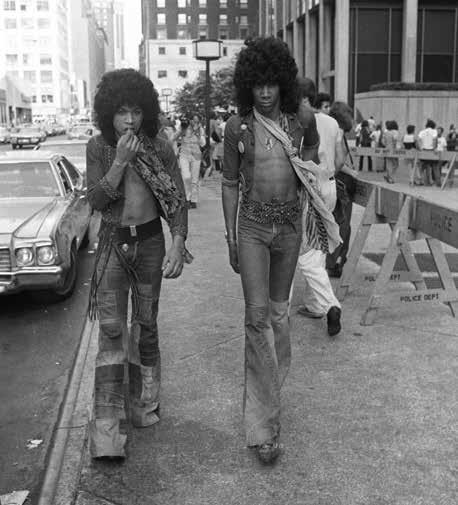
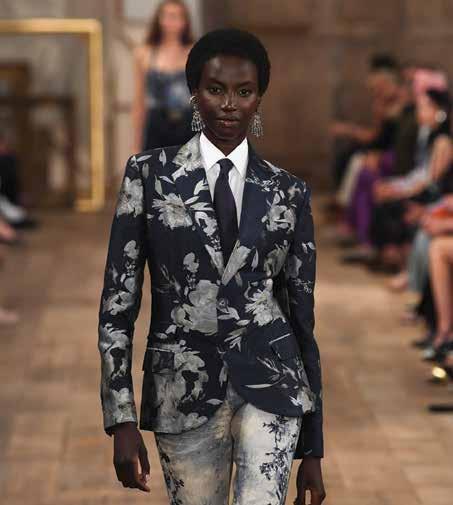
Crafting Culture
From embroidery, beadwork, metal studs and patchwork to purposely splashed paint and rips and tears, jeans have been an artistic canvas for designers and consumers alike for decades. While no one person is credited with the trend, the popularity of the doit-yourself embellishments gained more acceptance during the 1970s when the counterculture used jeans by Levi’s, Lee and Wrangler to communicate views on protest and power.
Artisan denim grew more refined in the 1980s and 1990s, as jean culture coincided with streetwear and designer denim. Hip-hop brands that were big on bling, like Rocawear and Baby Phat, joined the runway with established denim designers like Tommy Hilfiger and Ralph Lauren. Jean Paul Gaultier was the first to debut denim in the haute couture in 1999.
DIY continues to inspire in a post-pandemic world, even becoming a part of the consumer experience. Levi’s Tailor Shop, where customers can add patches, fringe and other custom baubles, is one example of how the brand has successfully reestablished itself as the go-to denim brand for a new generation.
1 Concert goers in DIY patchwork denim outside The Rolling Stones concert at Madison Square Garden in 1975.
2 Imaan Hamman on the runway in painted and embellished denim from Ralph Lauren’s Spring 2024 collection.

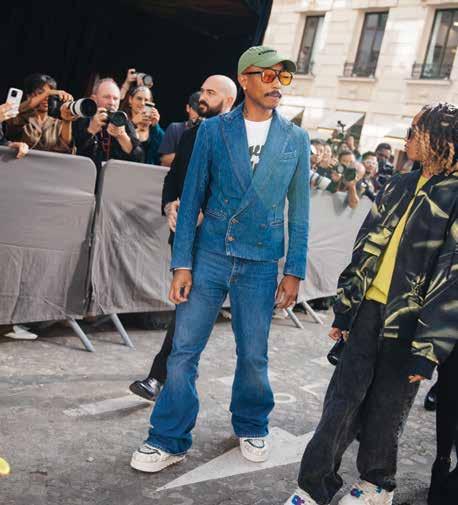
Fashion Icon for Self-Expression
Jeans have a long been a cultural conversation, one often as complicated as their history. Their evolution as a symbol of rebellion is connected to youth culture in the 1950s and 1960s. Jeans have often been a marker of protest and solidarity during decades of activism. Jeans they continue to represent durability, style and personal expression. Those who admire them exude cool confidence in their own unique way.
From early purveyors like Marlon Brando and James Dean to Marilyn Monroe and Katherine Hepburn, and musicians like Bob Dylan, Bob Marley and Joan Jett, these icons helped propel jeans to their ultra cool status. Fashion influencers from Jane Birken to Yves Saint Laurent have also worn jeans to embody personal style, uplifting their social status. Today, jeans go from day to evening with names like A$AP Rocky giving them red carpet approval and Pharrell Williams, whose love for denim goes beyond fashion, continuing to elevate their iconic status.
1 Yves Saint Laurent on the roof of El Hanch, his home in Marrakech, Morrocco in 1972.
2 Pharrell Williams at Paris Fashion Week in 2023.

the denim industry has undergone a remarkable transformation driven by a blend of technological innovations and sustainable practices. Advances in stretch denim have reshaped the workwear fabric’s place in fashion. Cutting-edge finishing technologies have not only enhanced the look and durability of denim but also reduced water and energy consumption. Integrating artificial intelligence and 3D prototypes has streamlined design processes, enabling more precise, personalized, and efficient production methods. Additionally, regenerative agriculture and textile recycling have emerged as vital solutions to address environmental concerns. Together, these innovations are redefining denim, making it more sustainable, efficient, and adaptable to the ever-changing demands of the modern consumer. c Here, industry experts discuss the impact of these innovations and how they continue to evolve. F

“Denim plays a vital role in moving towards a more sustainable fashion industry and the role of recycled fibers is huge. This is because denim is particularly resource-intensive to produce, consuming significant amounts of water and chemicals, and using just a small percentage of recycled cotton fiber can make huge environmental savings without compromising on quality,” said Matthew Neville, chief commercial officer of Recover. This familyowned materials science company launched the Recover brand of recycled fibers in 2014.
As recycling technology advanced and sustainability concerns rose, the denim industry began to wake up to this possibility. Neville said a big shift came as brands like Levi’s began incorporating recycled cotton into denim in the mid-2010s and making it more mainstream.
Indeed, recycled cotton has increasingly become a key component in denim production. However, achieving the quality and scale necessary to make a meaningful impact wasn’t always guaranteed. Significant investments made by denim mills in advanced mechanical textile recycling systems have greatly accelerated the production of recycled cotton, positioning these innovations as crucial drivers of circularity in the industry.
“With increasing demand for recycled fabric content, brands are encouraging suppliers to expand product offerings with both post-consumer waste and post-industrial waste cotton,” said Ali Tekin, AGI Denim’s R&D director.
“When our leadership first invested in mechanical textile recycling, there was curiosity but essentially no clear requirement for recycled cotton from the brands. Today, we are proud to say, that nearly all our clients require it in their fabrics and that policy is built into their sustainability goals. To go from that original status quo to the current environment where exciting conversations are had about what else we can provide from recycled viscose, lyocell, polyester and even linen—that is inspiring,” he said.
Last year, AGI produced more than 30 million meters of fabric with recycled cotton.
Recycling technology has made denim production more resource-efficient by reducing waste and minimizing its environmental footprint, Tekin added. Having its own recycling system and supply chain gives the vertically integrated mill greater control over its products from an earlier stage.
Additionally, because recycled fiber requires more optimization in downstream production, it has led the Pakistani mill to assess different parts of our operation for inefficiencies.
Recent investments have been designed with recycled fibers in mind, ensuring all processes are optimized for it. Overall, Tekin said it has encouraged the company to take a more holistic approach to making denim with recycled fibers.
“AGI Denim’s leadership has a history of investing in new technologies, and we are proud to say we were one of the pioneers who brought denim recycling by introducing one of the first dedicated mechanical cotton recycling plant in Pakistan,” Tekin said. “The technology has changed a bit since then, to say the least, but our commitment to turning waste denim

into new fibers and materials has not altered. Last year, we produced over 30 million meters of fabric with recycled cotton.”
Siddiqsons’ investment in recycling machinery has enhanced sustainability, reduced waste, lowered production costs, and strengthened its market position by offering eco-friendly denim solutions. The Pakistani mill began investing in cotton recycling in 2013, integrating advanced recycling machinery into its operations. Siddiqsons’ setup includes post-industrial waste and postconsumer waste plants, a waste recycling plant, and a recycled waste yarn plant, enabling the company to minimize waste, enhance resource efficiency, and contribute to a more sustainable denim industry.
The mill recycles 14,400 kg of waste yarn annually and has a shredding waste recycling capacity of over 4,380 tons annually.
“Textile recycling machinery has significantly enhanced sustainability in the denim industry by minimizing waste, optimizing resource utilization, and enabling large-scale recycling of blended fabrics,” said Abbas Jan, Siddiqsons director of sales and marketing.
“Beyond promoting circularity, investing in recycling machinery enhances resource efficiency, reduces production costs, minimizes environmental impact, and strengthens compliance with sustainability regulations.”
However, Jan noted that challenges persist in securing cost-effective raw materials, traceability and maintaining fiber quality,
THE TECHNOLOGY HAS CHANGED A BIT SINCE THEN, TO SAY THE LEAST, BUT OUR COMMITMENT TO TURNING WASTE DENIM INTO NEW FIBERS AND MATERIALS HAS NOT ALTERED.”
Tekin, AGI
necessitating continuous innovation and collaboration.
Zahra Ahmed, Artistic Denim Mills (ADM) director, said textile recycling has profoundly transformed denim production at ADM.
The Pakistani mill produces 12,000 tons of recycled cotton annually.
In 2020, ADM began its investment in recycling by partnering with Recover. The strategic collaboration enables ADM to offer clients a traceable and scalable solution for integrating recycled fiber into their products and valuable insights into the recycling process.
“We aim to demonstrate to our brands that recycling is a viable future without compromising product quality. While not all recycled goods are created equal, our commitment to innovation ensures that we offer products on par, all while reducing our environmental impact. This strategic approach positions us as leaders in sustainable denim production,” Ahmed said.
Beyond promoting circularity, investing in recycling machinery allows the vertical mill to initiate fabric innovation ahead of competitors

and has prompted ADM to experiment with different blends. “Our goal at ADM is to continue fabric innovation,” Ahmed said. “For instance, we’ve combined recycled cotton with hemp to develop a product that offers a unique soft hand feel while lowering the impact of the garment. This innovative, proprietary blend not only enhances the texture and appearance of our denim but also introduces a new aesthetic, that wasn’t previously available in the market. This opens exciting possibilities for both product differentiation and consumer appeal.”
While the fundamentals of mechanical textile recycling machinery have not changed in the last-half century, Neville said Recover has innovated how it uses machinery. Through continuous learning and improvements, the company has developed proprietary technology that optimizes the output. Recover’s annual production capacity is approximately 65,000 metric tons. “The result in a consistent, high-quality fiber that is spinnable even in ring spinning (which makes up most of the industry), and this is something that sets us apart from a lot of recyclers,” he said. There is still room for improvement in mechanical recycling, and this focuses mostly on improving the uptake of the fiber by spinners. Neville said the industry is also investing heavily in automated sorting technology, which would enable the industry to turn the huge quantities of post-consumer waste into valuable feedstock for textile-totextile recycling.
Traceability technologies are evolving the relationship between mills and brands. Up against consumer demand for transparency and legislation requiring digital product passports (DDP), suppliers have adopted various solutions to aid with traceability. FibreTrace, a technology that uses a unique identifying luminescent pigment to raw fiber that can be followed from farm to shelf in real-time, and Oritain, a fiber-testing technology that precisely pinpoints the area down to a few meters where a product or raw material originated, are some of the tools being utilized by mills.
Cone Denim, for instance, minted a partnership with Oritain to verify the origins of its cotton and share that data with customers.
Steve Maggard, president of Cone Denim, said that, since the partnership began in 2020, clients have responded favorably to the added security origin verification provides. Oritain’s fiber-testing technology verifies that cotton is compliant with legislation like the U.S.’s Uyghur Forced Labor Prevention Act (UFLPA).
“Cone Denim has publicly committed to operating sustainably and transparently, and Oritain is a key tool to meet that commitment. Not only is it admissible in a court of law, but it has been vetted and is recognized by our customers as valid,” he said.
Traceability and transparency are closely linked. Pakistan’s AGI Denim partners with Oritain as well as Green Story, which uses technology to generate information about a fabric or style’s footprint via a digital product passport (DPP). That data gives buyers insight into how much water, energy and land use went into making a fabric or style—and how much emissions are associated with the creation of such a product.
AGI is targeting EU and U.S. customers with the life cycle assessment (LCA) information; in the EU, incoming legislation will begin to mandate DPPs for a slew of products. This year, AGI will debut 100 styles—up from just a few in 2024—all featuring hang tags with a QR code directing buyers to a full LCA completed by Green Story.
AGI plans to continue working with Green Story to refine DPPs and LCAs for the denim industry. Henry Wong, AGI Denim’s VP of product development and marketing, said the mill wants the technology to be plug-and-play ready for other companies interested in providing their customers with the same information.
“Despite all the competition we have in our space, we still all live in the same world, so we want to see it be more than okay—be great,” he said.
CONE DENIM HAS PUBLICLY COMMITTED TO OPERATING SUSTAINABLY AND TRANSPARENTLY, AND ORITAIN IS A KEY TOOL TO MEET THAT COMMITMENT.”
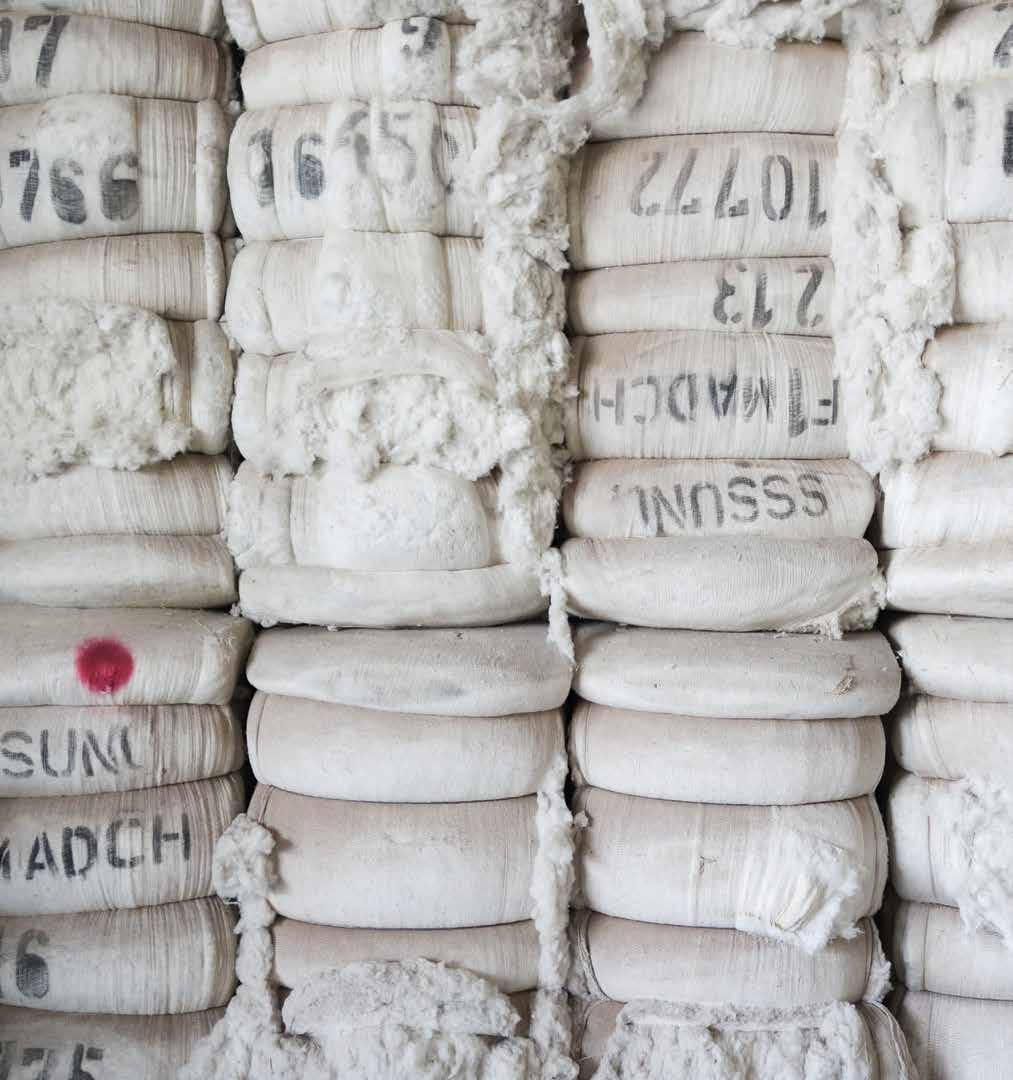
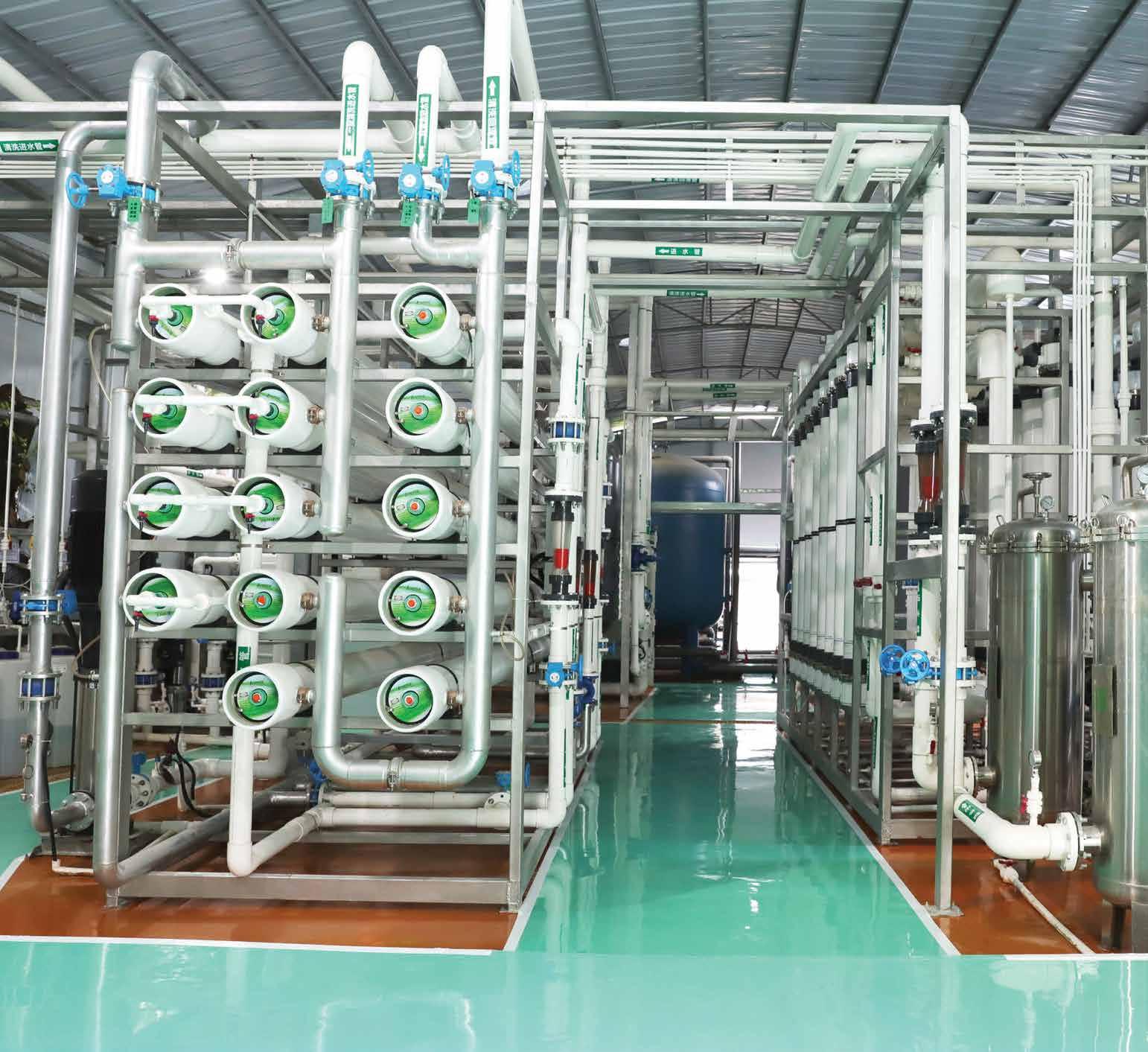
The denim industry’s water consumption sparked controversy in 2013 when Levi Strauss & Co. released the lifecycle impact of a pair of 501 jeans, revealing that each pair requires 3,781 liters of water—equivalent to three days’ worth of total water usage for a typical U.S. household.
The denim industry’s reliance on water, along with solutions to minimize water waste, has become a central focus for investment. Mills from all regions including Artistic Milliners in Pakistan, Arvind in India, Crystal International in Cambodia and Kaltex in Mexico are taking proactive steps to reduce water usage by implementing wastewater treatment facilities to collect, recycle and reuse water.
Among them, Advance Denim stands out as a
leader in driving these efforts. Mark Ix, director of North American marketing for Advance Denim, said the company built its wastewater treatment plant next to its factory in China. The wastewater produced during denim finishing is piped into the treatment plant, where it goes through a bioreactor, is filtered to remove indigo and chemicals and is then turned into clean water that can be reused in the factory. Advance measures its ammonia and chemical oxygen demand (COD) to ensure levels of water output by the treatment plant are far lower than government standards.
The plant can process 9,000 tons of water daily, but Ix said the mill doesn’t come close to using that capacity. “The key is, don’t use so much water—create your manufacturing process to limit the amount of water you use,” he said. To achieve that goal, Advance has, in tandem, worked to reuse the indigo filtered out of the water to decrease the amount of water waste it produces, before it ever hits the treatment plant.
Ix said the company has reduced the
THE KEY IS, DON’T USE SO MUCH WATER—CREATE YOUR MANUFACTURING PROCESS TO LIMIT THE AMOUNT OF WATER YOU USE.” Mark Ix, Advance Denim
amount of water it uses in denim production by 73 percent. On average, Advance Denim uses about 600,000 tons of water annually, meaning the treatment plan processes less than 2,000 tons a day. He added that the goal is to create a [wastewater] system that is robust but not overstressed. “The water you’re actually sending to your reverse osmosis system is just a trickle [compared] to what it was seven years ago,” he said. For Advance, the next item on the docket at its wastewater treatment facility is using renewable energy to power it. By the end of 2025, Ix projects that “no less than 40 percent of the power will come from renewable energy, as well.”
Cotton continues to be the foundation of jeans, but the introduction of additional fibers has propelled the garment into exciting new dimensions.
Textile expert Tricia Carey said the denim market has always been a hotspot for fiber innovation because its unique construction allows experimentation with new materials. “Denim’s coarser yarn counts make it more forgiving for fibers that may not be optimized for quality. Additionally, weft innovation provides opportunities to incorporate fibers that may not have the strength in warp applications since they don’t require dyeing,” she explained.
Additionally, Carey said the presence of vertical suppliers—where spinning, weaving, and sometimes garment-making happen within the same company—enables seamless integration of new fiber technologies and supports cost efficiencies.
Lenzing has worked closely with vertical suppliers to scale the use of Tencel lyocell in denim. The fiber’s foray into denim goes back to the ’90s but Tuncay Kiliçkan, head of global business development for denim at Lenzing, said it took some time for the industry to fully understand the characteristics of the man-made cellulosic fiber that’s derived from wood pulp. “Fiber innovations progress at a slower pace compared to other raw materials, and their adoption takes time. However, these advancements open new chapters for the industry. Brands are no longer willing to rely solely on cotton, making the adoption of alternative fibers like Tencel more essential than ever,” he said.
Tencel has become a key ingredient in the denim sector for its low amounts of water, low carbon footprint and softness. It has also become a point of differentiation in a denim market that has an increasingly homogenized look. “For consumers, little remains to justify a premium feel and a comfortable pair of jeans—aside from a luxurious hand feel, which Tencel fibers naturally provide,” Kiliçkan said. “As a result, there is strong demand for authentic yet soft denim products in both the EU and U.S. markets. Both mills and brands are well-acquainted with this solution, and it has now become a mainstream trend.”
Tencel has also created a blueprint for additional fiber solutions such as Refibra technology, which transform recycled cotton textile waste into new fiber, and Tencel Modal with Indigo, a fiber that Kiliçkan said significantly reduces water, chemical, and carbon footprints while offering superior fastness compared to traditionally indigo-dyed fibers. “I can say that it’s the next-gen denim fiber which can easily adopt to other segments than denim like activewear and knit,” he said. There’s room for growth, Kiliçkan added. “If the industry can be more patient and supportive, we will see greater diversity in the fiber portfolio. With these added innovations, denim will continue to evolve in both look and feel—while also driving more significant resource savings,” he said.
Denim is also deeply rooted in storytelling, making it an ideal platform to introduce and market fiber innovations in a way that
resonates with consumers, Carey added. “Most importantly, the denim industry is a highly collaborative community with deep technical expertise, where brands, mills, and innovators work together to push boundaries and drive meaningful innovation. This combination of technical adaptability and industry-wide cooperation makes denim a natural fit for pioneering new fiber solutions,” she said.
In 2019, Levi’s and Outerknown captured consumers’ attention by launching jeans made from a blend of 70 percent cotton and 30 percent hemp, engineered to feel just like cotton. This fiber innovation, called cottonized hemp, had been under development by The Flax Company—famous for cottonizing linen 50 years earlier—since 2000. Based in Northern France, The Flax Company began bulk production in 2019 with the debut of Marmara Hemp.
“The denim sector is facing major challenges in meeting market expectations, whether in terms of innovation, durability or even cost, and not just in terms of spinning, weaving or finishing. Fiber innovation is one of denim producers’ major allies in meeting brand challenges. Marmara is a golden opportunity to broaden the scope of possibilities while matching the new market rules,” said Denis Druon, CEO of The Flax Company.
The environmental benefits of hemp have intrigued the denim industry. However, hemp’s rough texture previously prevented it from being widely adopted.
“When we speak of a cottonized hemp fiber, we mean a 100 percent hemp fiber that we have tailored to similar specifications in terms of length and fineness, so that it can be spun as a blend on a cotton spinning system (ring
or open end) without modification of the existing equipment,” Druon said. “Hemp does not require water to grow or to be produced. So, each kilo used significantly saves water for our planet. Adding Marmara hemp to denim is a big step towards product sustainability.”
Over the past six years, Druon said the firm has worked with supply chain partners to reach the quality standards required by the spinning mills, particularly in terms of fineness/spinnability, to secure sowings to guarantee volumes, and to certify its production chain with an LCA, a C2C certificate and sustainability certification.
Cottonized hemp poses a unique set of challenges—the biggest being the selection of the raw material. “The process starts well before the plant even grows as there is a tremendous amount of work in seed selection, land preparation, straw cutting date in the field and then retting process,” Druon said. “For textile applications, we need fineness and fiber division, which is difficult to achieve with hemp fiber, but we’re getting there.”
The other challenge is to turn a natural fiber, where each field and each batch of fiber has its own particularities, into a fiber that will be homogeneous for every delivery and available in industrial quantities on a regular basis. This is the challenge met by Marmara Hemp, Druon said.

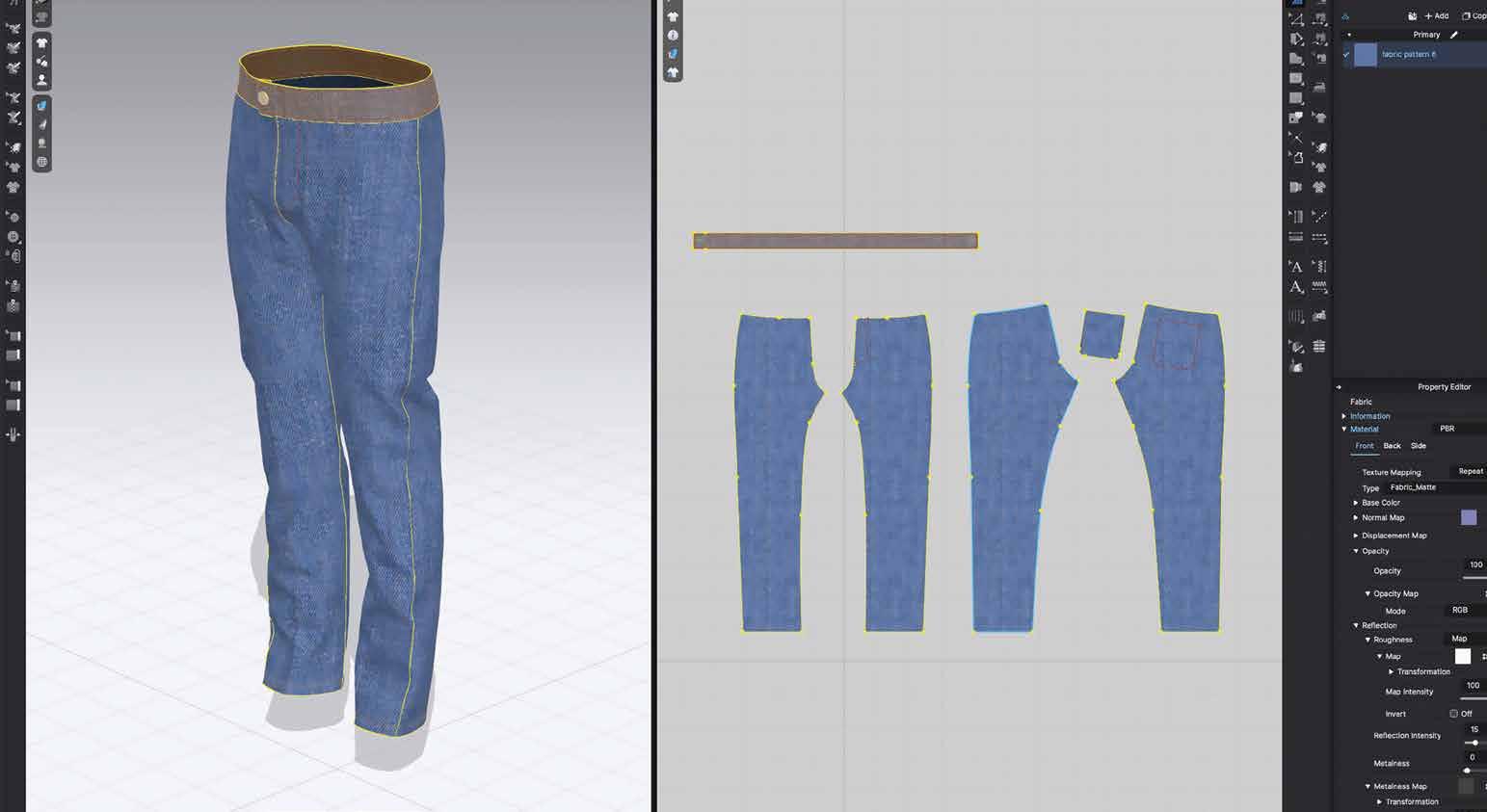
The key advantage of 3D prototyping is that designers can iterate and adjust styles in realtime, seeing photorealistic versions of their designs and assessing fit without producing a physical sample.
From fit and finish to shrinkage and wash, countless factors go into perfecting a pair of jeans. As the demand for efficiency grows, design is increasingly leaning on digital prototypes to minimize the need for physical sampling. Companies like Browzwear and CLO are leading the charge in 3D digital prototyping. CLO boasts clients like Diesel, Hugo Boss, L.L. Bean and Levi’s, and Browzwear has customers like Columbia Sportswear, Under Armour, Walmart and Kohl’s.
In the denim industry, creating fewer samples is particularly impactful because of the myriad steps that go into dyeing and finishing garments, as compared with a less-involved garment. By dynamically adjusting designs digitally, brands can reduce the number of samples they request before production, which decreases the emissions associated with producing the samples and shipping them, whether domestically or, more commonly, internationally.
“As a technical designer, I find it invaluable for quickly sharing designs and options with
I FIND [3D PROTOTYPING] INVALUABLE FOR QUICKLY SHARING DESIGNS AND OPTIONS WITH JUST A FEW CLICKS.”
Maria
just a few clicks,” said Maria Gunnarsson, founder of AMK Atelier.
Using 3D prototyping software can also aid brands and retailers in getting products to market faster. Rather than waiting for several iterations of a physical sample from faraway suppliers, designers can complete most of their vetting digitally, sending only the most finalized version of a product’s tech pack to a manufacturer for sampling.
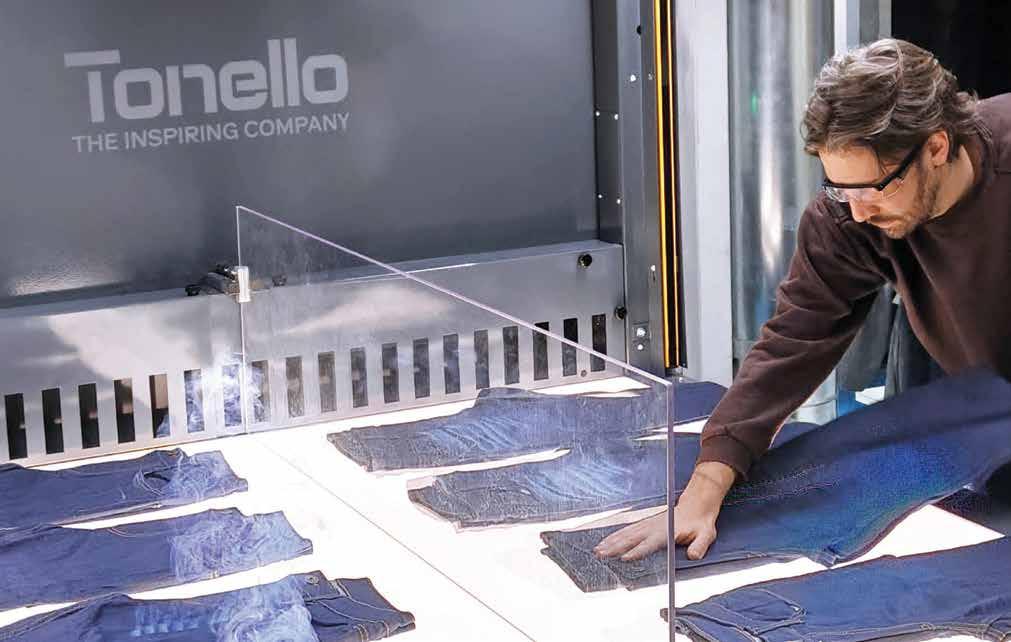
One of the most effective ways brands reduce their environmental footprints is through advanced finishing technologies.
“If the denim industry didn’t have advanced laundry technologies like laser and ozone, we would see significantly more pollution, water waste, and fewer sustainable finishing options,” said Carey. “Design possibilities would also be more limited, as traditional methods rely heavily on chemicals and manual labor to achieve desired aesthetics.”
Indeed, laser technology has revolutionized denim finishing, enabling companies to achieve worn and aged effects without potassium permanganate and manual scraping. The cutting-edge technology replicates an authentic vintage look while opening up
limitless creative possibilities—from natural 3D textures and effects to custom damages, lettering, and imagery. Designers can create a digital file of their desired finish, upload it into the laser system, and within seconds, the power of light effortlessly transfers the design onto the garment.
“This technology drastically increases productivity, improves quality, and enhances worker safety, ensuring precision and repeatability while eliminating harmful manual processes. It enables brands to scale up production efficiently while reducing dependency on skilled labor for finishing,” said Carmen Silla, marketing director of Jeanologia, which launched its laser technology in 1999.
Since Italian tech firm Tonello introduced the technology for garment processing in 1995, laser systems have evolved into highly precise and efficient tools, with innovations like B.O.P. (Be On Point), an AI-powered garment detection system that ensures accurate, error-free marking.
Laser has been a catalyst for other efficiency-driving innovations including Tonello’s All-in-One System, a washing machine that combines multiple sustainable technologies to streamline finishing while reducing resource consumption. The system includes EGO, which utilizes ozone to minimize water and chemical use; NoStone, which replicates stone-wash effects without pumice stones; UP, optimizing washing with an ultra-low liquor ratio; and Core, a nebulizing system that significantly cuts water usage.
In 2005, Jeanologia introduced G2 Ozone technology, replacing traditional waterintensive washing with an air-washing system. Building on this breakthrough, in 2023, the company launched G2 Indra Ozone Airwash. “Just as laser disrupted the dry finishing process, G2 air-washing machines are set to
replace water-washing machines, marking a new era for denim finishing,” Silla said. “Traditionally, water has been the carrier for transporting chemicals into garments. With G2 Indra, we shift from water to air, using ozone gas to generate the same abrasion, color reduction, and cleaning effects—without water, chemicals, or pumice stones.”
Though Tonello has been a trusted technology supplier for 50 years, Alice Tonello, R&D and marketing manager, said the family-run company has seen a notable shift in the industry’s approach to sustainable finishing technologies in the past decade. “It has become increasingly clear that the future of denim can only move in this direction, driving a deeper investment in innovative washing and finishing solutions that prioritize responsibility,” she said.
Several key factors in the past decade have accelerated this transition. “Increasing pressure from consumers and brands for more sustainable production methods, along with stricter environmental regulations, have made it clear that the industry could no longer rely on its old ways. At the same time, rising production costs, water scarcity, and the push for digitalization and automation have made investing in new technologies a necessity rather than an option,” Silla said.
Pivoting to these technologies has been a challenging endeavor, particularly for an industry that values its legacy and is recognized for its fragmented supply chain.
“While these innovations have already made a huge impact, there is still a need for broader adoption across the industry to maximize their environmental benefits. Advancing these technologies further is crucial to reducing denim’s footprint while maintaining the creativity and diversity that make it such a dynamic category,” Carey said.
Alice Tonello, Tonello
Resistance to change has been a major barrier, slowing down the adoption of sustainable and advanced technologies, Silla said. “The finishing industry has always been deeply rooted in tradition, relying on legacy processes where water, chemicals, and manual techniques are the main forces. Historically, the industry has depended on washing machines, pumice stones, and chemical treatments for washing, while manual labor and chemical applications have been essential for dry processes. This traditional approach is still dominant today,” she said.
Despite this, Jeanologia’s vision for the future of denim finishing is digital, which will reduce lead times, physical samples, and waste; automated to increase efficiency and consistency; and water-free.
The future of denim finishing technology is still taking shape, Tonello said. “Since its founding, Tonello has continuously introduced innovations to the market, and the focus now is on refining and improving existing technologies to make them even more efficient and less impactful. Progress isn’t just about invention; it’s also about adoption. Truly transformative innovations often take time to be widely embraced, but as awareness and industry priorities evolve, sustainable and high-performance solutions will become the standard,” she said.

As brands and retailers increasingly seek to offer products made from more sustainable fibers, cotton grown through regenerative practices has emerged as a leading option. Unlike conventional cotton farming, which can deplete the soil and rely heavily on synthetic chemicals and fertilizers, regenerative farming aims to go beyond sustainability by actively regenerating and enhancing the environment.
The global momentum behind regenerative cotton gained undeniable traction, with the farming practice increasingly recognized for its economic and environmental benefits. Last July, the certification body RegenAgri reported a dramatic surge in the adoption of its standards. The number of farms and supply chain
operators joining the regenerative movement grew fivefold in 2023, with 640 supply chain companies committing to the program.
Denim mills such as Vichuna, Soorty and AGI Denim have taken leadership roles in driving this transition. For Pakistan-based Artistic Milliners, which has a regenerative cotton program, rehabilitating the soil and ecosystem in a region fraught with the negative impacts of repeated chemical use and climate change has proven a way forward.
The RegenAgri-certified mill has partnered with hundreds of farmers to realize its more sustainable vision. In 2023, it worked with 92 farmers, and that number surged to about 600 in 2024. This year, Saqib Sohail, Artistic Milliners’ lead on responsible business projects, shared that the mill aims to expand the program to approximately 1,000 farmers.
The regenerative cotton program has enabled some clients to transition away from conventionally grown cotton—particularly those who have been priced out of using organic cotton. Furthermore, regenerative
WE HAVE TO CREATE AN ENVIRONMENT WHERE THE FARMERS ARE ABLE TO DO IT ON THEIR OWN…”
Saqib Sohail, Artistic Milliners
cotton offers valuable data to help brands and retailers meet EU sustainability and traceability requirements.
While regenerative cotton often comes at a lower price point than organic cotton, Sohail emphasized that launching a regenerative program requires substantial investment. He expressed hope that in the future, regenerative certification costs will decrease, making the practice more accessible.
“We have to create an environment where the farmers are able to do it on their own, especially when you are working with South Asian farmers who have small land ownership, not the big ranches in the U.S. and Australia and other places,” Sohail said.

Stretch denim revolutionized the industry, unlocking a world of new silhouettes and enabling denim to rival activewear in ways consumers had never experienced. For millennials who grew up with skinny jeans as a staple and Gen Z-ers who abandoned the fit during the pandemic, only to rediscover it as a trend item, the idea of denim without stretch feels almost unimaginable.
“In the mid-1970s we began working with mills to experiment with Lycra fiber in denim. As with many new fabric innovations, there were challenges to overcome. Designers had to figure out how to make fabrics that would stretch but not shrink excessively, avoiding the orange peel effect,” said Jean Hegedus, sustainable business consultant and former denim segment director for The Lycra Company.
With assistance from the Lycra brand technical team, and through numerous fabric trials, the industry began to see improvements in both fabric aesthetics and performance.
Burlington Denim was among the first mills to develop stretch denim in the U.S.
By the 1980s jeans themselves had experienced several incarnations, particularly sexy status symbols, Hegedus said. “It was at that time that designers began developing slim fitting, skinny jeans with Lycra fiber, and young women could be found sporting them in discos and clubs,” she said.
“I still remember trying on my first pair of skinny jeans and thinking how odd they felt, but they marked the shift from a denim-chino cycle to a denim-legging era,” said Tricia Carey, textile expert. “Comfort and flexibility became essential. Initially, the focus was simply on adding stretch, but as the market evolved, so did the technology—leading to better recovery and fiber blends that improved durability and shape retention.”
By the 2000s, the burgeoning premium denim market established the use of Lycra T400 fiber. “Not an elastane, it was made from two different types of polyester polymers, which provided inherent and long-lasting recovery so denim fabrics would keep their shape,” Hegedus said. This fiber paved the way for innovations like Xfit Lycra, a fiber technology that allowed designers to develop fabrics that would stretch and recover in all directions, and Lycra dualFX, a solution for denim with high stretch levels.
While previous denim fabrics tended to have 15 to 20 percent stretch, Hegedus said designers wanted them to stretch 30 to 80 percent or more. “This posed numerous challenges to mills and brands alike. As fabric stretch levels increase, so does the tendency for fabrics to have high growth (bagging and sagging) or high shrinkage. Stabilizing these fabrics was difficult at best,” she said.
Rita Ratskoff, The Lycra Company’s senior strategic account manager, said Lycra dualFX was quickly adopted by mainstream brands and retailers, as it significantly improved the comfort, fit and durability of jeans. “Levi’s adoption of stretch in women’s denim sparked global awareness and triggered widespread acceptance. American Eagle was an early adopter of Lycra dualFX technology,” she said. Stretch denim’s staying power in the market is partly owed to fiber companies’

willingness to evolve and adapt to the market’s ever-changing needs. “[Fiber innovation] is imperative—the industry thrives on innovation and can’t exist without it,” said Ebru Ozaydin, The Lycra Company’s strategic marketing director denim, RTW. “This is why The Lycra Company is so focused on looking beyond just trends and providing true denim innovation with and for our partners.”
A recent example includes Lycra FitSense Denim Technology, a “fiber-to-fashion solution” that enables designers to enhance jeans with targeted shaping. Additionally, Lycra is adopting bio-based inputs for products like Lycra EcoMade made with Qira, a dent cornbased 1,4-butanediol (BDO) produced by Qore.
“Stretch innovation has transformed the denim sector bringing added comfort, durability, and expanded design capability,” said Simon Hong, Hyosung global denim marketing director. The South Korean spandex producer began developing customized stretch innovations for denim in 2015.
Sustainability is increasingly playing a role in the future of stretch denim. “As consumers demand more eco-friendly products, denim is being held to higher environmental standards,” Hong said.
TRIGGERED WIDESPREAD ACCEPTANCE.”
To meet this challenge, Hyosung has developed many customized sustainable textile solutions for denim beginning with the introduction of RCS-certified, 100 percent recycled Regen Spandex made from reclaimed production waste we commercialized in 2020. In 2022, the company launched Regen Bio Spandex made with 30 percent industrial corn and has since increased the Bio Spandex offering to include higher content of renewable resources.
Hysong’s Creora 3D Max Spandex delivers high-performance stretch and recovery with a small portion of spandex content uniquely allowing the garment to be recycled, and Creora SlipFree Spandex improves seam slippage resulting in reduced waste. “We continuously study the denim market to drive textile innovation and stay ahead of consumer needs,” Hong said.
Artificial intelligence (AI) is revolutionizing the world of design and quality control, ushering in a new era of innovation.
Many companies are leveraging AI to enhance creativity while maintaining the human touch in their designs. For instance, G-Star Raw uses generative AI to assist its designers, and the Netherlands-based brand has already begun selling products that incorporate AIgenerated ideas. Other brands use AI to push the limits of what’s possible, showcasing bold and imaginative denim designs in lookbooks and ad campaigns. While these designs may be challenging to mass-produce, they inspire clients to think more creatively.
In an even better scenario, Maria Gunnarsson, founder of AMK Atelier, said consumers could pre-purchase AIgenerated products, allowing brands to produce only what is in demand, eliminating overproduction. “I believe we have only scratched the surface of AI’s potential in supporting us. Education will play a crucial role in helping us evaluate and integrate digital designs into more efficient fashion production methods,” she said.
On the production side, mills are harnessing AI to streamline quality control processes by inspecting fabric bolts or finished goods. Advance Denim uses AI to help identify and pinpoint defects in textiles, said Mark Ix, director of North American marketing for Advance Denim. The process uses cameras and sensors to capture data about a given fabric, and an algorithm helps to identify imperfections.
Previously, Advance used cameras in its finishing machines to identify defects, but the system wasn’t properly trained to differentiate between normal denim characteristics and actual flaws. With the advent of AI, the technology now can more accurately distinguish between what’s intentional and what’s a defect.
“They couldn’t tell the difference between just regular character in denim and a defect, so we boxed those and put them in the corner, and now AI has helped teach that kind of technology to differentiate between the defects and stuff that’s supposed to be there,” Ix said.

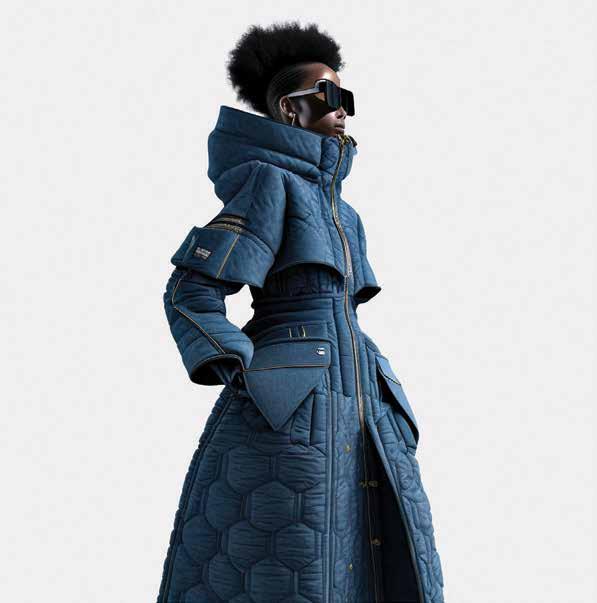

I BELIEVE WE HAVE ONLY SCRATCHED THE SURFACE OF AI’S POTENTIAL IN SUPPORTING US.” Maria Gunnarsson, AMK Atelier

Not all innovations are the stuff of sci-fi movies. The denim industry is increasingly looking to nature for inspiration, resulting in nature-derived auxiliaries and bio-based performance fibers that deliver the same results as their fossil fuel counterparts. Companies like The Lycra Company, Hyosung and Candiani Denim are pioneering bio-based stretch fibers, while chemical specialists like Archroma have been touting the benefits of natural color for years.
Switzerland-based Archroma launched EarthColors in November 2014 with the vision of transforming agricultural waste into highperformance dyes. Since its launch, Dhirendra Gautam, VP of global marketing for Archroma, said EarthColors has inspired several brands and retailers such as G-Star Raw and Espirit to push the boundaries with their designs by introducing sustainable dyes to their collections.
“We continue to see growing interest in bio-based coloration solutions. As technology improves, brands are increasingly seeking eco-

friendly alternatives to meet consumer demand and regulatory standards,” Gautam said.
Companies like Archroma continue to improve their chemistry as well. Historically, natural dyes faced challenges with colorfastness and vibrancy. Ongoing research is overcoming these challenges, ensuring that nature-sourced dyes can compete with synthetic ones in terms of durability and color consistency. Gautam added that the future of nature-sourced dyes looks promising, especially as sustainability continues to drive innovation in the textile and fashion industries. Up next, Archroma is preparing to launch FiberColors, which will upcycle wool waste into a new range of high-performance bio-based sulfur dyes.
“The denim industry, like many others, is increasingly under pressure to adopt more sustainable practices due to growing environmental concerns. With advances in technology and innovation, it is increasingly feasible to produce high-quality, natural dyes and chemicals on a large scale, hence reducing costs and addressing past concerns about durability and vibrancy,” he said.
Natural dyes have been part of Maria Gunnarsson’s design toolbox. However, the founder of Amsterdam-based AMK Atelier, said education is key to raising awareness among both the industry and consumers
about the advantages of using ingredients from renewable resources. “It’s crucial to recognize that we can’t continue prioritizing only the cheapest and fastest methods of designing, developing, and producing clothing,” she said. “If the industry doesn’t demand or invest in more sustainable chemicals, meaningful change will never happen. Education must reach not only the next generation in schools but also brands and consumers, ensuring a collective shift toward more responsible choices.”
The adoption of nature-derived auxiliaries in textiles is still in its early stages, said Alberto De Conti, head of Rudolf Hub1922. “While their use is, in principle, widely supported as a noble industrial practice, the reality is that their higher cost, driven by the premium on renewable sources, limits their widespread adoption in denim manufacturing and finishing,” he said.
Rudolf offers 69 auxiliaries (and counting) that have bio-based carbon content ranging from 25 percent to 100 percent. Key products for the denim industry include Rucolase DWS, the first and only bio-abrasive for waterless stone washing of jeans, derived from food waste, and Perrustol MMX, a 93 percent biobased hydrophilic softener with exceptional natural, anti-yellowing properties.
The demand for nature-derived auxiliaries,
AS TECHNOLOGY IMPROVES, BRANDS ARE INCREASINGLY SEEKING ECO-FRIENDLY ALTERNATIVES TO MEET CONSUMER DEMAND AND REGULATORY STANDARDS.”
Dhirendra Gautam, Archroma

which typically have a significantly lower product carbon footprint is moving in a positive direction. De Conti said the current implementation of sustainability reporting directives in the EU, and likely soon in the U.S., require large enterprises to disclose climate-related risks, including greenhouse gas emissions.
“The denim industry is about to face even greater complexity, building on the already detailed certification requirements for chemical safety,” he said. “Soon, we’ll also be required to provide more transparency regarding product carbon footprint. One of the main drivers of CO2 emissions in chemical auxiliaries is the type of raw materials used. To reduce environmental impact, selecting the right renewable sources and implementing a strong logistics strategy will be essential. Therefore, there will certainly be a future for chemistry made out of renewable sources.”
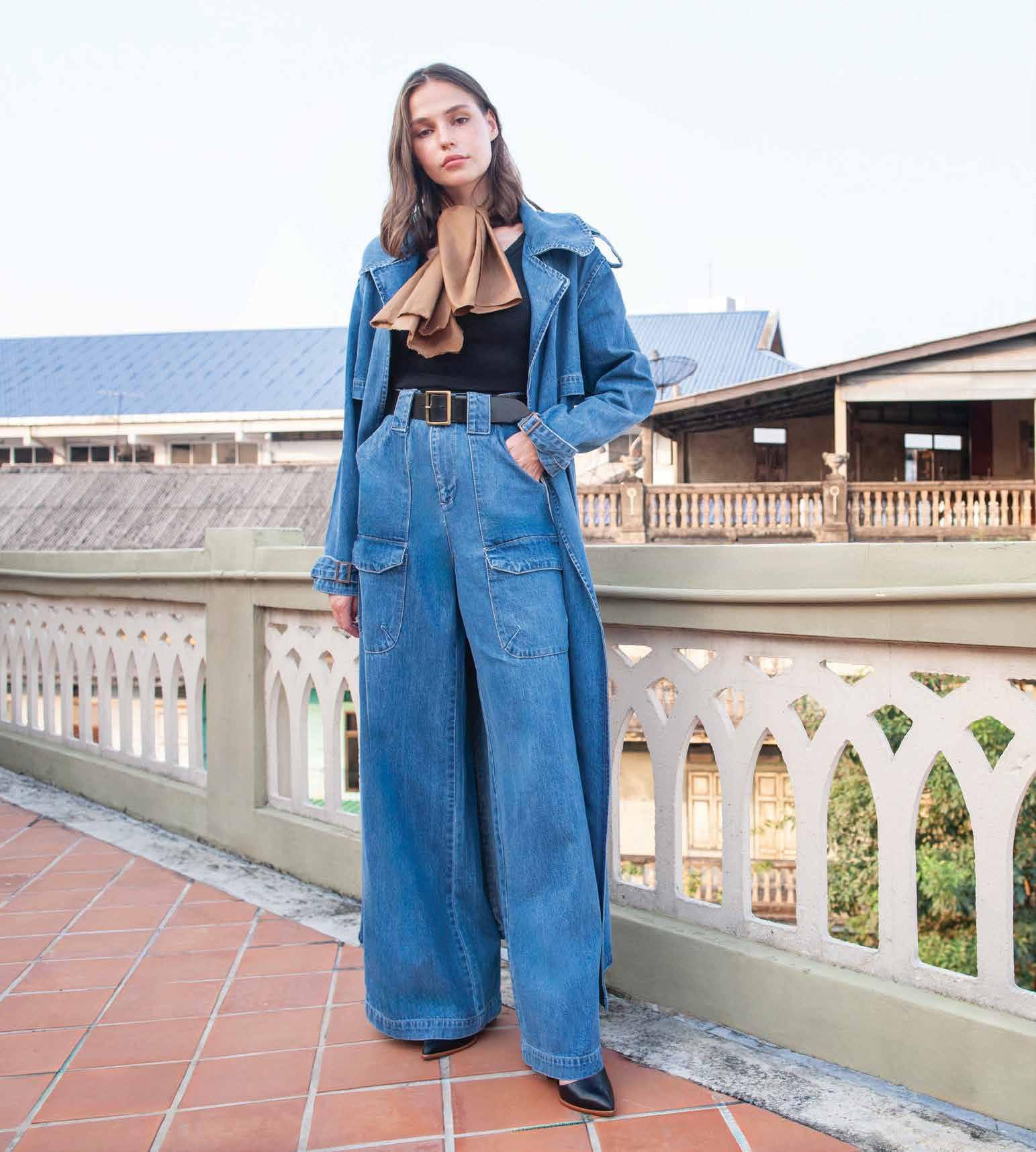
by Angela Velasquez
the role of a denim mill has evolved far beyond the traditional boundaries of fabric production and sales. Today’s most successful mills are not only trend forecasters, sustainability and traceability advisors, and technology innovators but also experts navigating the complex geopolitical challenges impacting the denim supply chain. Calik Denim expertly balances all these roles with professionalism and foresight. c “We are not just supplier of our customers; our solution partner mission maintains our position as a highly preferred business partner,” said Serdar Ozcan, Calik’s sales, marketing, P&D director. c These qualities and more come together in Calik’s Fall/Winter 2026-2027 called “Interdipendency,” a moniker Ozcan said is based on the “invisible network connecting every aspect of life” and how actions “ripple outward, influencing and being influenced by the world around us.”
It might seem like a deep philosophy for denim, but it highlights the level of responsibility the Turkish denim mill takes in its decision-making processes. “Calik Denim places respect for people and the planet at the forefront, crafting fabrics designed for wellbeing, durability, and minimal environmental impact. As fashion evolves, transparency, traceability, and commitments to sustainability are reshaping the industry,” Ozcan said.
Examples of this include water-saving indigo and finishing technologies like Dyepro and D-Clear, and Re/J, a commercially successful collection of fabrics made from 100 percent recycled materials. This concept has garnered significant industry attention over several seasons, arriving at a pivotal moment when brands are placing greater emphasis on product longevity and embracing circular design principles.
“We see many customers who place sustainability at the core of their vision and consider it indispensable,” Ozcan said.
Calik remains bullish about B210, the R&D output that provides the opportunity to increase the amount of man-made fibers in order to produce high-performance denim fabrics that result in more than 99 percent biodegradability. Though the trend toward rigid and cellulosic fiber-based fabrics has allocated less space for B210 in Calik’s collections, from a broader perspective, Ozcan said this is a positive development in terms of sustainability.
“If, at some point, the trend shifts back towards high-elasticity and high-performance fabrics, we will be ready to make products biodegradable again using our B210 technology,” he said, adding that it still is available and can be applied to all synthetic fiber fabrics. “This is a great added value that can crown our customers’ sustainability journeys both in business processes and communication.”
In addition to sustainability, the F/W 26-27 collection considers several important market trends that are affecting the wide variety of brands Calik works with.
Calik sees a reinvention of denim luxury and premium denim with a distinctive twill look. Design-wise, Ozcan said trends are moving toward denim with a shiny and draped appearance—a look that will attract the attention of luxury fashion brands and will make them want to maximize denim in their collections. To meet this demand, Calik’s new Leisure Luxe collection offers fabrics that combine man-made fiber with special cotton combination resulting in a balance of softness and “tailored comfort,” he said.
Workwear-inspired fashion remains a bright spot in the denim category as well. With Worktive, Calik adds style to workwear with ready-to-dye herringbone fabrics and canvas made with recycled polyester.
Established product lines like Denovated, FixFit, Maxymove and Rawtech, which eliminates the need for industrial washing, return with updates that suit the season like heavier weights and richer colors. Calik is also integrating graphene into fabrics to enhance their antibacterial and anti-odor properties, which enables fewer home washings, allowing for less energy and water consumption. Additionally, Ozcan noted how graphene provides high abrasion resistance and thermal regulation. “In this way, we offer a product that is both highperformance and sustainable,” he said.
As high elastic and high-performance athleisure wear products have become trendy, Calik sees trends are returning to denim’s origins. Trends are shifting back to denim’s roots, driving Calik to develop concepts that balance tradition and wearability. “As the consumers are more aware of sustainability and durability, untreated denim with natural fading potential has become more popular with more wide leg or bootcut type of fits,” he said.
Ozcan said demand for fabrics made with 100 percent cotton is significantly higher than in the past, underscoring the unrelenting popularity of vintage denim. Calik’s new Roots Age collection captures the essence of heritage denim with rigid and comfort stretch fabrics inspired by the California Gold Rush. Some also include linen. “Roots Age is loomstate, original denim— unprocessed and raw—which provides a truly vintage-inspired look with its naturally hairy, ultra-nappy texture,” he said. It’s the type of fabric that denim heads gravitate to.
In general, Ozcan said denim from 1950s and 1960s is influencing fashion with its authenticity, craftmanship, heavy weight strong constructions, neppy and hairy surfaces, selvedge and raw look ideas which their dark indigo blue color becomes fresher and brighter as it ages.
“But as we always say, trends repeat themselves over the years. The return to the roots of denim and the strong trend of rigid denim looks right now does not mean that there will be no need for high elasticity denim next season. You always need to be prepared; the world is changing very fast and therefore denim too.”
The shifting nature of trade policies in different countries and the lack of stability in these changes poses unique challenges for Calik and its partners as it prepares for the F/W 26-27 season. “Unstable trade policies can make it difficult for both brands and fabric manufacturers to define their production and sales strategies,” Ozcan said.
YOU ALWAYS NEED TO BE PREPARED; THE WORLD IS CHANGING VERY FAST AND THEREFORE DENIM TOO.”
The best Calik’s leadership can do during uncertain times is stay plugged into the rapid news cycle, listen to clients and continue to it does best: produce denim.
“The U.S. is currently implementing a tax policy that appears to be political against Mexico, Canada, China and the EU,” Ozcan said. “We absolutely do not find it right to implement practices that will negatively affect global trade and that can be described as a tax/trade war because every aggressive decision taken and the use of taxes as a weapon in this way brings with it a retaliatory action from the other side. These political actions have a very negative effect on producers and therefore the country’s economy in the long run.”
On the other hand, Ozcan said the greatest opportunity for denim is that its appeal never fades. “Denim has a unique spirit in fashion, maintaining its popularity among all age groups globally, from the youngest child to the oldest,” he said. “This enduring appeal ensures that the industry always remains dynamic.”


Can the denim industry print a more sustainable future? by Kate Nishimura
denim has long been branded one of the most climate-adverse, chemical-heavy, water-wasting fabrics to mill and manufacture. But a new class of innovators aims to turn that reputation on its head, replacing conventional indigo dyeing with digitally driven printing processes that capture characteristics consumers havecome to crave without the ecological impact. c January saw the introduction of LAB Denim, a multinational biotechnology firm specializing in bio-based, indigo-free, postweave colorization. c If that sounds like a mouthful, it’s because there’s ample science behind the technology, which creates denim nearly indiscernible from conventional jeans using an entirely modern process.
“Denim as a fabric has been done a certain way for a long time; you dye the indigo yarn and weave it with the non-dyed yarn, and you create the fabric. And when you do that you end up with a rich color, and then you’ve got to strip that color out of it,” CEO Dustin White explained. “Each step has its challenges, and I think that there’s been a lot of progress in many ways, in how to improve those processes.”
Co-founded alongside Dr. Mickael Mheidle, a Swiss expert in digital printing and biosciences for textiles, the technology reframes denim manufacturing through a 21stCentury lens.
“Denim is analog, and we’re moving to digital. When you do that, obviously the first thing you start with is you’re no longer going to dye the individual yarn and then weave it, because that that defeats the purpose,” White said. “You’re going to take a pre-woven fabric and you’re going to feed that into some type of a colorization system.”
But rather than go with traditional digital printing processes, in which pigment ink is applied to fabric using a binding agent or reactive inks are applied to chemistry-treated fabric, the group has created a process all its own.
A proprietary indigo replacement made with patented chemistry and bio-based color enhancers (derived from inputs like algae) is applied to cotton or cotton-elastane white fabric using a digital colorization machine,
spitting out fabric with the same quirks and charm as a pair of old Levi’s, for example. Using digital design tools, creatives can create the unique details and characteristics typically found on vintage jeans or create new styles all their own without being hemmed in by the ecological impacts of traditional washing and finishing.
“Dr. Mheidle looked at, ‘How do I fix the denim industry, knowing that it’s one of the worst offenders of pollution? What do we have to eliminate?’” White said. Limiting water use was the No. 1 objective. “So how do you do that? You have to create a chemistry that doesn’t require using water to either pre-treat or post-treat the fabric.”
Unlike a traditional reactive dye, which might rely on urea or soda ash to pre-treat fabric to optimize the dyeing process (and copious amounts of water to wash away the chemistry post-dyeing), Mheidle’s “New Blu” class of inks can achieve a range of colors and effects without water, White said.
“He’s created not just a color, but a process that eliminates the pre-treatment and post treatment, meaning there is no fixation or washing off process,” he added. “You simply take the woven fabric, run it through the system, and out comes true denim, but with 97 percent less energy and over 99 percent less water.”
LAB Denim’s patented technology encompasses a process called Digital Ring dyeing, in which a unique technical and chemical process is used to stop the ink from penetrating all the way through a fiber in order to match the functionality and wear of analog rope dyed denim.
Of course, laser processes can be used post-printing to achieve the true texture of a worn pair of jeans. The group sees ample opportunity for partnership with some of the denim industry’s leading finishing innovators, who have worked to replace stone-washing techniques—which are polluting and waterguzzling—with lasers to achieve whiskering and distressing.
White said LAB Denim’s potential is catching on with the industry—and quickly. With a design center in Los Angeles, a production facility in Germany, continued research and development in Switzerland, and a sample production hub in Tampa, Fla., the firm is
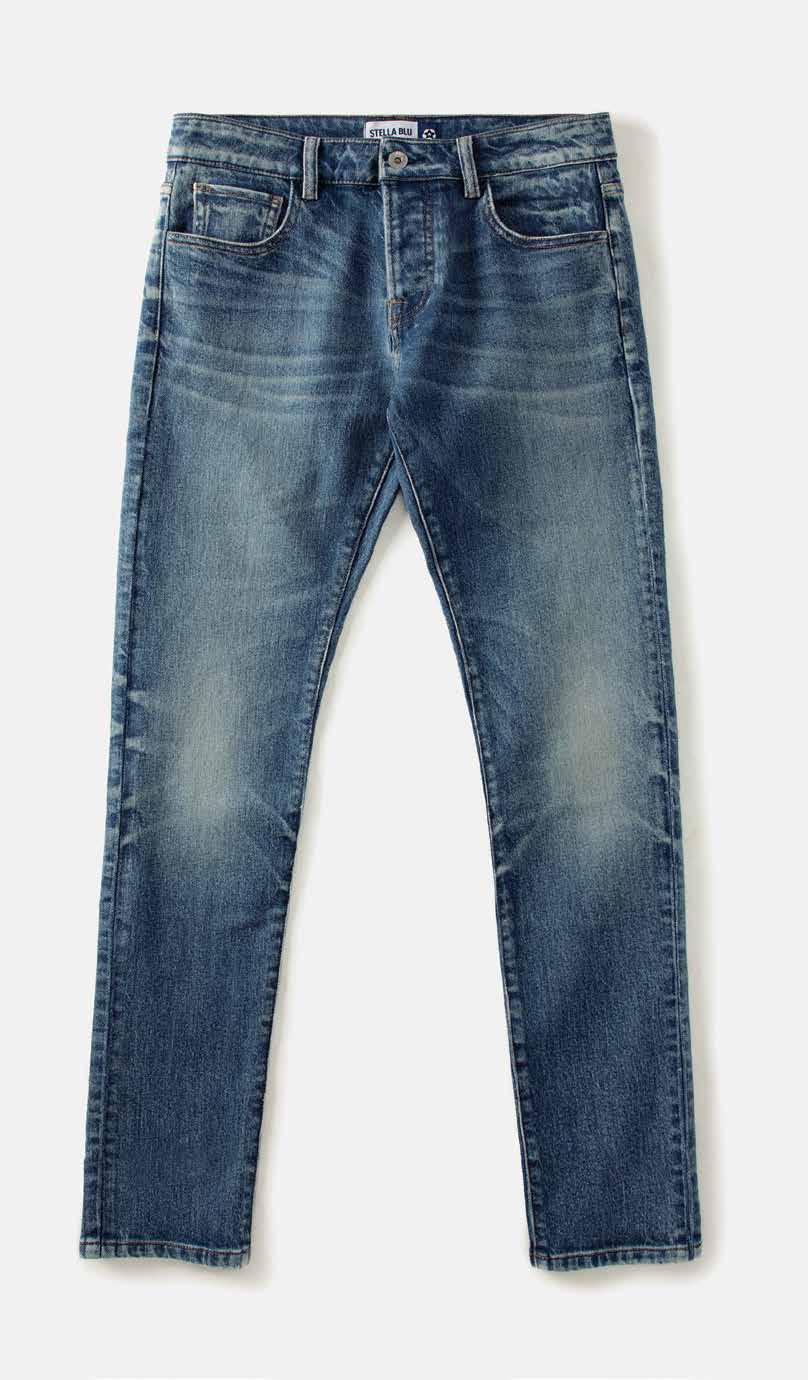
looking to make inroads across production markets. One large San Francisco brand has its own LAB Denim machine on campus.
“The goal is to show up in these markets and bring our dedicated equipment, bring in the fabric from wherever it’s coming from, colorize the fabric, and then use the local market for cutting and sewing,” White said.
Each medium or large-scale machine can produce between 1,500 to 3,000 pairs of jeans per hour, answering the question about scalability. “It’s just about building the machines,” he added, noting that each one takes about three months to produce. The company is looking at locales like Bangladesh and Pakistan—already denim production hubs—as its next targets, along with the U.S. and the EU. New machines are scheduled to be built by August.
With and industry momentum behind it, White said LAB Denim could be the push the denim sector needs to move away from polluting processes and embrace a more sustainable future.
Meanwhile, indigo-dyed fabrics innovator Stella Blu has been flirting with digitalization
for years. The Italian producer—a division of Prosperity Textiles—modernized its offering by installing a waterless textile coloration system called Cooltrans two years ago.
Developed by Shanghai based textile manufacturing firm NTX, the process can add color to nearly any textile without employing heat or water. Not much, at least—Cooltrans is said to cut down on water usage by 90 percent.
“By utilizing the Cooltrans technology in the production process, we significantly reduce water usage and chemical waste, making our denim production more sustainable and ecofriendly,” a spokesperson told SJ Denim.
“Our technology is particularly well-suited for use with cellulosic fabrics, especially those made from cotton and Tencel, which are key components of typical denim fabrics,” they added. “This includes both standard and stretch materials, enhancing versatility across different products.”
Though the technology opens up “a wide range of design possibilities, it represents a distinct product line that can’t be directly compared with traditional denim methods,” the group said. “Nonetheless, it excels at
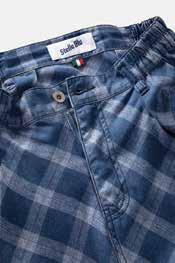
with designs achieved with Cooltrans technology.
replicating complex wash effects, achieving a faded look similar to conventional denim but with its own unique characteristics.”
That distinct quality comes from the technology’s ability to achieve a look that traditional denim methods can’t easily match—“This includes more vibrant colors, sharper patterns, and an overall distinctive aesthetic appeal,” a Stella Blu spokesperson said. “While it might be hard to visualize without seeing it firsthand, these products offer a fresh take on classic denim looks while being more sustainable.”
The efficiencies gained through the unique printing process also help save resources, and can shave off costs.
“In terms of cost differences between Cooltrans products and those made with traditional processes, Cooltrans tends to have a competitive edge due to reduced water usage and chemical waste, which lowers environmental impact and potentially production costs,” the spokesperson said.
Currently, the group is focused on optimizing and expanding the application of Cooltrans within its existing product lines. “As for future expansions or exploring alternative printing technologies, it will depend on ongoing research and market demands,” they added.
Spokesperson, Stella Blu
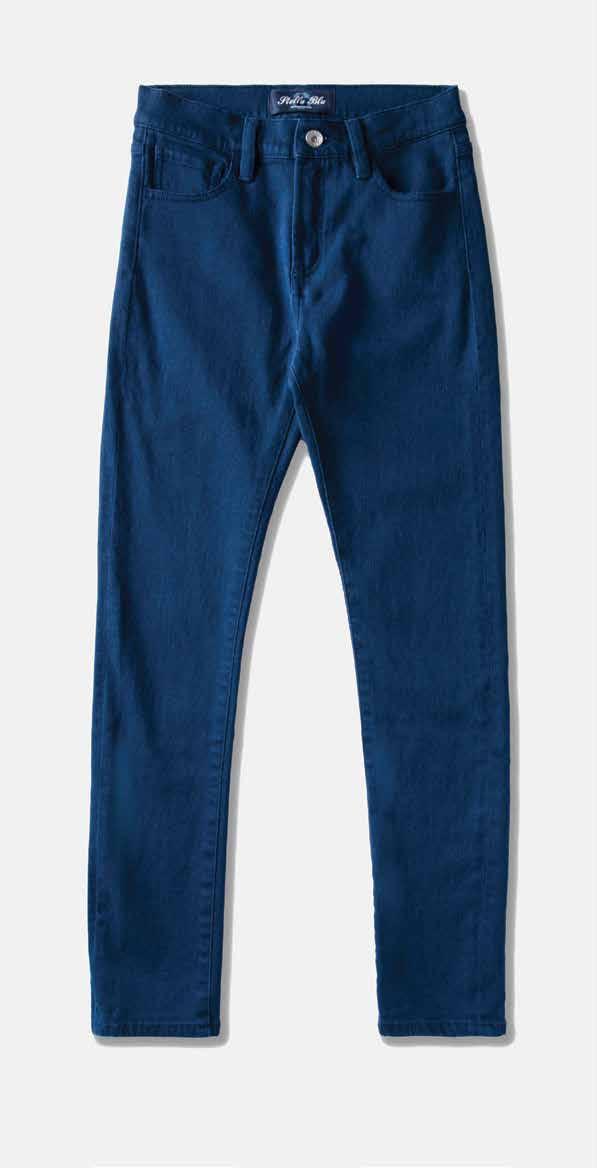
IIT’S NO SECRET that traditional denim washing processes are problematic to the planet. But while many companies’ innovations have tried to solve the beloved material’s inherent laundry challenges, only a few have made a significant impact. Until now.
With its roots in the chemical sector, Florence, Italy-based Soko has emerged as a deeply knowledgeable pioneer because it is also a service provider. It offers 360-degree solutions to improve washing and finishing processes by interacting with the various players in the field, such as brands, fabric producers, laundries and many others.
With that expertise under its belt, Soko has cracked the code with its newest innovation: Soko HydroGel. This novelty is so pioneering because it changes the physical state of the medium where the washing takes place—the water itself.
“Everyone thinks about changing the products, but Soko instead has changed the medium in which the process takes place by gelling the water, thus obtaining a gentler treatment towards the fiber and also allowing a process with less water consumption,” said Matteo Urbini, managing director, Soko. “Essentially, HydroGel creates a wash in a bubble of gel that protects the fiber and washes it with just a few liters of water.”
Going into further detail, HydroGel arises from a family of products that address the various types of washing processes, all preserving fiber integrity and the elasticity of stretch fabrics.
HydroGel S is the most complete product of the range. Once added to water, this “allin-one compound for stone

washing” transforms into a gel bath, offering the benefits of fiber protection, with an even salt and pepper effect, and a single step process that drastically reduces the water consumption.
HydroGel B is dedicated solely to hypochlorite bleach. With “less stress for the stretch,” the solution provides a shield for the fabric that maintains bleach efficiency.
HydroGel N, the neutral version of Hydrogel, is the most versatile, leaving ample opportunity for the technician to achieve artistic results.
Regardless of the HydroGel used, the aqueous bath gel achieved offers a number of laundry advantages.
With a viscosity higher than water, the HydroGel treatment process literally envelops garments in a gel-like bubble. This creates a more protective environment with fewer risks to the fabrics, including higher fiber protection and reduced breakage.

“ESSENTIALLY, HYDROGEL CREATES A WASH IN A BUBBLE OF GEL THAT PROTECTS THE FIBER AND WASHES IT WITH JUST A FEW LITERS OF WATER”
MATTEO URBINI , managing director, Soko
Another important advantage to HydroGel is that the gel can treat the entire wash, from the raw garment to the cleaning or bleach in a single gel bath. This results in an enormous savings of water. In fact, when using HydroGel S, only 4 liters are enough to achieve what would normally require over 30 liters. The subsequent steps remain the same for both, but the savings go from 30 to 4 from raw to bleach.
With HydroGel S the entire process from desizing to bleaching takes place in a
single step and a single gel bath, introducing a single product that already contains all the ingredients needed to complete the process.
Another notable advantage is the fact that HydroGel doesn’t require laundries to purchase any extra machinery or complicated preparation to create the gel. Just put it in the washing machines! Overall, by “changing the shape of water,” HydroGel protects the fiber, reduces the damages, reduces water consumption and simplifies the process. ■
Renewable resources are on the
of

the argument for sustainable stretch denim is solid . While fits cycle in and out of style, and the post-pandemic trend for ’90s-style rigid constructions caught on with young generations, the demand for stretch denim—be it with comfort, traditional or power stretch levels—remains steady. c However, the pressure is on as fiber producers, denim mills and brands to work together to minimize the fabric’s environmental impact. c Since elastane-enabled jeans hit the market in the late Seventies, the woven material—typically a blend of cotton and spandex made from fossil fuel—has made a lasting impression. So much so that finding a pair of jeans without stretch is something of a Herculean task; the synthetic-and-soft fabric has become the standard, representing 77 percent of the global denim market, per Candiani Denim.
The Milanese mill would know, considering Candiani’s stretch denim set new standards for comfort and fashion in the Eighties. Though conventional stretch offers the wearer many advantages—like asset enhancing fits and more mobility, for example—the environment pays the price as elastane is, essentially, plastic.
That is why Candiani spent five years on something of a Promethean task: Coreva. Launched in 2020 as an alternative to synthetic yarns, Coreva is a patented technology that replaces elastane fibers with natural rubber—effectively making Candiani the first mill to offer plastic-free stretch denim fabric made with biodegradable yarns.
Swapping petroleum for plants, Coreva has been embraced by the likes of Outerknown, Stella McCartney and Denham. Los Angeles label Triarchy held the North American exclusive on the innovation through 2024. Candiani also launched a house brand of jeans called Coreva Design.
However, innovating comes with a financial risk. Though there’s a conversation about reducing the industry’s dependency on fossil fuels, Simon Giuliani, Candiani Denim’s global marketing director, said one challenge as a producer and manufacturer is investing in new technology that brands may or may not adopt.
Change won’t happen overnight. Giuliani likens the denim industry’s education on renewable ingredients to the food industry and how its evolved as consumers’ have grown more aware of healthier food choices and sources. In fact, Candiani has taken a very literal approach. Since launching Coreva, the mill has hosted several events where it served canapés made with tomatoes grown from composted denim.
“We were really trying to say, ‘Guys, you should look at fashion the same way you look at food. If you did, you might make different choices,’” Giuliani said.
Despite the financial risk, fiber manufacturers are stepping up to the plate with sustainable alternatives.
Hyosung believes that the more eco-minded solutions for designers, the merrier. The South Korean company is known for sustainable innovations like Creora Regen, the brand name of its sustainable spandex, nylon and polyester fibers and Regen Bio Spandex, a range of bio-based spandex fibers either made with dent corn or sugarcane. Bossa, Kipas, Artistic Milliners and AGI Denim are among the denim mill using the alternative fibers.
Per life cycle analysis data, Hyosung’s Regen Bio Spandex production is expected to reduce carbon emissions by 80 percent when its new vertically integrated plant in Vietnam becomes operational in 2026. The Vietnam facility will produce Regen Bio Spandex with renewable resources derived from sugarcane.
“As consumer awareness of environmental issues continues to rise, demand for sustainable denim—including those made from organic, recycled and bio-based materials—is expected to increase,” said Simon Hong, Hyosung’s denim lead.
“Additionally, as active lifestyles become more widespread, the preference for stretch denim is also predicted to grow. As a result, the demand for functional qualities such as stretchability and soft comfort is anticipated to strengthen.”
Another fan of industrial field corn? The Lycra Company. The fiber technology group
has returned to its roots with a bio-derived version of the world’s original spandex fiber.
“A fun fact is spandex was originally invented with a renewable material derived from the manufacturing and harvesting of oats,” Steven Stewart, The Lycra’s Company’s chief brand and innovation officer, said.
“The reason it went to petroleum-based was because it grew so fast, there wasn’t enough supply. In a way, Lycra is returning to its roots. We were the inventor, the original solution provider in the space, and we’re trying to get back to where we began.”
The renewable fiber is made with Qira through a joint venture with Qore. The two teamed up in 2022 to enable the world’s first large-scale commercial production of this bioderived spandex, using Qira as a main ingredient.
Through this partnership, 70 percent of The Lycra Company’s spandex fiber content will be sourced from annually renewable feedstock, which is anticipated to yield a 44 percent carbon footprint drop, per LCA data. When fully commercial, the bio-derived feedstock will be made from field corn grown in a 100mile radius of Qore’s facility in south central Iowa sourced chiefly from individual farmers.
There are efforts underway by The Lycra Company to look at alternatives for the remaining 30 percent of additives.
“You can’t do everything for everybody all at once,” Stewart said as it relates to converting existing products into this renewable offering.
“We’re trying to find the way to say, ‘Okay, what are the big chunks? Where do we start? Who’s committed?’ And then, take it step by step.”
Turkish denim mill Orta Anadolu is one of the first mills to bring denim made with Lycra fiber made with Qira to the market.
While the ideal product for the denim industry would be a fully biodegradable alternative crafted from 100 percent renewable feedstock, companies remain focused on balancing durability and quality with affordability to ensure it meets consumer expectations.

WE WERE THE INVENTOR, THE ORIGINAL SOLUTION PROVIDER IN THE SPACE, AND WE’RE TRYING TO GET BACK TO WHERE WE BEGAN.” Steven Stewart, The Lycra Company
Neslihan Sebla Önder, Orta’s manager of marketing and sustainability, pointed out how sustainable qualities like degradability can sometimes weaken the overall performance of a fabric. “And we don’t want that; we want all the materials to be used in the system for a very, very long time. It I can only wear them for one season, that’s not a sustainable product. That’s a problem,” she said.

While it’s a problem worth unpacking, as breaking down these barriers is how the industry advances, it shouldn’t be one that diminishes the impact of existing solutions that can help the denim industry reduce its dependency of fossil fuel.
“If you’re waiting for 100 percent biobased materials and do nothing in the meantime, you will have no impact whatsoever,” Önder said. “The idea is like, let’s start here and do something. Then we can improve.”
A shift in perspective is also on the mind of AGI Denim, which is actively offering Creora Regen, Regen Bio Spandex and Lycra fiber made with Qira in its roster of sustainable fiber ingredients. The Karachi, Pakistan-based denim manufacturer, too, sees the staying power of sustainable stretch. However, Henry Wong, AGI Denim’s vice president of product development and marketing, said its impact goes beyond jeans and includes high-stretch apparel categories like activewear.
“When we talk about stretch fiber itself, we’re addressing two percent of the jean’s material,” said Henry Wong, AGI Denim’s vice president of product development and marketing. “Whereas the thinking really needs to first solve the other synthetic [categories] in a very urgent matter, which I think the industry hasn’t really invested a lot of thinking into yet.”
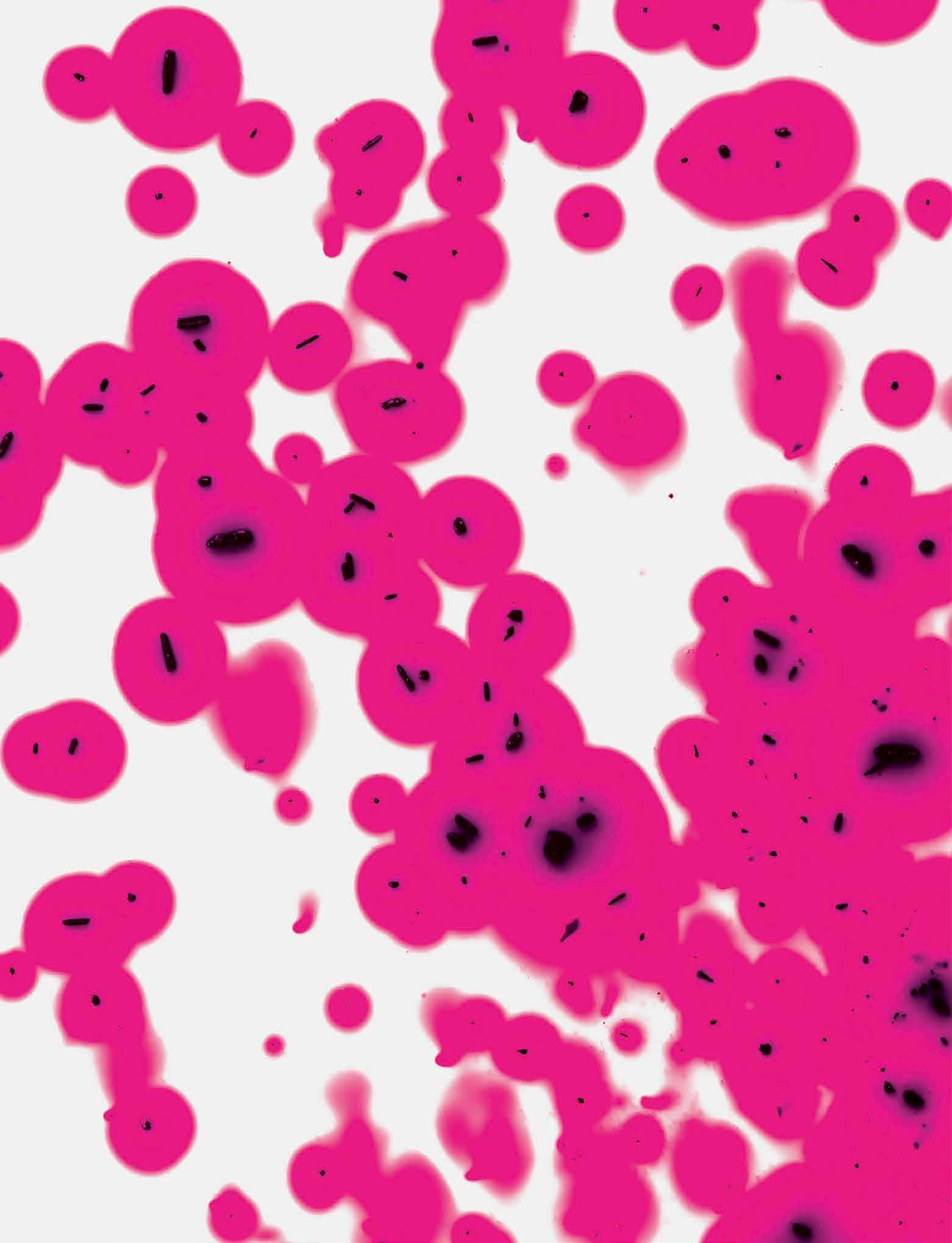

Will the denim industry ever break free from its reliance on potassium permanganate?
by Angela Velasquez
consumers adore vintage -looking jeans, but potassium permanganate (PP), a chemical oxidizer that is used to accentuate worn, faded design elements on denim remains one of the denim industry’s dirty little secrets. c Though PP is not banned in any country, it is on the hazardous chemicals list of the United States Environmental Protection Agency and is classified as a hazardous substance by the European Chemicals Agency for being toxic to aquatic life, causing severe skin burns and eye damage, damaging a fetus and fertility and damaging organs through prolonged or repeated exposure. c In 2018, Levi Strauss & Co. took a major step forward in chemical management when it launched Project F.L.X., a future-led operation model digitizing denim finishing and eliminating manual techniques. Through Project F.L.X., the denim giant eliminated up to 90 percent of chemical formulations used in jeans finishing, reducing thousands of chemical formulations to a few dozen and phasing out of the use of potassium permanganate.
It is still a work in progress, however.
“Levi Strauss & Co. is committed to responsible chemicals management and to driving sustainable progress within the apparel industry. We have greatly reduced the use of aerosolized PP spray and continue to mandate strict usage guidelines in the places it has not yet been phased out, including the use of personal protective equipment and detailed safety protocols,” the company stated.
Indeed, the trajectory of the textile industry is increasingly aligned with environmental and health safety standards, which are steering away from chemicals like PP. Sumit Sarker, sustainable textile expert at Bluesign Academy, said this shift is driven by growing consumer advocacy for sustainable practices and the availability of safer, more efficient alternatives.
“Moreover, as regulations tighten globally, the industry is responding by innovating and adopting cleaner technologies,” he said. “This regulatory and market evolution strongly indicates that the use of potassium permanganate could very well be phased out in the near future.”
The chemical is in the Candidate List of the ZDHC MRSL V3.1, meaning that it is a potential candidate for phase-out and addition to the main list in the next update of the ZDHC MRSL. “The decision to include the substance in the Main List of the ZDHC MRSL V4.0 will be taken by the MRSL Council based on the possibility of scalable safer alternatives being available, as we always intend our MRSL to be a pragmatic standard that can be implemented by the global industry,” ZDHC stated.
Until then, ZDHC has a host of recommendations outlined in a training module on ZDHC Academy for chemical management in denim industry explaining exposure and emission controls as well as best practices for storage and handling.
“Our position is that potassium permanganate must never be used without appropriate engineering controls (such as water curtains and localized extraction) and workers must always use appropriate personal protective equipment. Suppliers are strongly
encouraged to evaluate alternatives to manual spraying of potassium permanganate such as lasers, robotized spraying or safer chemical alternatives,” ZDHC stated.
Rather than prohibiting PP spray, a February 2024 report by Clean Clothes Campaign Turkey (CCC Turkey) said MRSL urges brands to take occupational health and safety measures when using it, which leads to signatories taking various approaches to PP spray in their supply chain.
For example, CCC Turkey said H&M implemented a PP spray ban at the start of 2024 and reported that Diesel is using alternative chemicals. In a questionnaire, Zara-owner and MRSL signatory Inditex confirmed to CCC Turkey that it uses PP spray but that periodic checks are made on its factories to examine whether sufficient safety measures are being made.
Other brands are less specific about their use of PP spray but highlight other sustainable technologies. CCC Turkey found that Guess and Pepe Jeans—both of which are not MRSL signatories—highlight their use of Wiser Wash technology. However, it is unclear if the technology is used in all jeans production.

“It is unclear whether any brand 100 percent moved away from PP,” said Bego Demir, Clean Clothes Campaign Turkey coordinator. “We have encountered instances of companies promising not to use PP in their products, but that products made by PP were nonetheless available in their shops.”
Any denim product treated with PP cannot be certified as a Bluesign product. The sustainable chemistry management system has taken a firm stance against potassium permanganate in the denim supply chain due to its significant health and environmental risks.
Bluesign System Partner companies are required to phase out the use of PP in denim finishing by the end of 2025. In the time remaining, Bluesign requires strict safety measures to minimize risks to workers. Additionally, wastewater treatment processes are required to limit the discharge of
I WOULDN’T WANT TO CRUSH ANYONE’S DREAMS, BUT I BELIEVE THAT THE MAJORITY OF THE INDUSTRY STILL USES POTASSIUM PERMANGANATE IN PRODUCTION.” Luca Braschi, Soko

manganese into the environment. Partners must conduct substitution checks and develop a phase-out plan at their production sites.
“The ultimate goal is the complete elimination of potassium permanganate to ensure a safer and more sustainable denim industry,” Sarker said, adding the industry-wide shift reflects a “strong commitment to eliminating hazardous substances in denim processing.”
Making that transition is not without challenges. “While there is a strong movement among our system partners towards banning potassium permanganate, its use persists in many operations due to specific customer requests. Despite these challenges, there is a shared commitment across the industry to eliminate its use. Bluesign supports these efforts and is optimistic that, through collaborative efforts, we can fully achieve this goal,” Sarker said.
Saitex is committed to removing PP from its denim supply chain as part of its Bluesignapproved sustainability efforts. However, it is one of the partners that still uses it “in exceptional cases where no viable alternative exists and the application falls outside Bluesign’s scope,” said Jerome Lallouette, Saitex COO.
In these instances, Lallouette said the company ensures strict control measures, including a closed-loop water system to capture, treat, and safely dispose of the chemical, preventing environmental discharge and precision robotic spray application to ensure worker safety. “This approach balances sustainability goals with operational realities, ensuring that any necessary use of PP remains minimized, controlled, and environmentally responsible,” he said.
Most companies rely on a suite of solutions to replace PP.
Approximately 85 percent of Saitex’s production is PP-free. The vertically integrated denim manufacturer started removing the chemical from its manufacturing system eight years ago.
Saitex prioritizes laser technology, ozone treatments, and eco-friendly chemical alternatives to achieve vintage and worn-out denim effects without hazardous substances. Additionally, most of Saitex’s fabrics are designed to react well with the technology it uses to eliminate PP.
“There is no one-size-fits-all solution, but rather a combination of innovative techniques that can be applied case by case to achieve the desired denim aesthetics while reducing reliance on PP,” Lallouette said.
Sarker said ozone treatment is a widely used method, effectively bleaching denim with ozone gas, reducing water and chemical use. Laser technology provides precise fading effects without chemicals, improving worker safety. Enzymatic finishing also offers a biodegradable and eco-friendly approach.
Tonello, the Italian company specializing in sustainable technologies for denim and garment washing, dyeing, and finishing, offers multiple alternatives to PP.
One effective approach combines The Laser with Core and the All-in-One System. By using laser technology with ozone washing, Alice Tonello, R&D and marketing director for Tonello, said it’s possible to achieve similar effects without the need for hazardous chemicals. Additionally, the Core nebulizing system enhances these results by applying products that amplify the laser
effect, creating an even closer match to traditional PP treatments.
Despite the options, Tonello said only some brands and clients see PP as a major concern.
“It’s likely that potassium permanganate will eventually be banned, but the market expects a viable alternative that offers the same cost-effectiveness and ease of application. Until then, its phase-out will depend on the availability and adoption of safer, scalable solutions,” she said.
Although there is a desire in the industry to replace PP with safer alternatives, in some cases, Sarker said the alternatives may not yet be feasible or effective technologically or financially for some companies.
“Brands are under constant pressure to reduce their use of potassium permanganate due to its environmental and health risks, and they are actively exploring and testing safer options. However, the transition is complex and requires significant industry collaboration and innovation to fully implement safer alternatives,” he said.
“I wouldn’t want to crush anyone’s dreams, but I believe that the majority of the industry still uses potassium permanganate in production,” said Luca Braschi, Soko marketing and technology manager.
A significant factor behind its popularity is its cost-effectiveness. PP is one of the least expensive and easiest products to apply. Price dictates the market and decisions, Braschi said, adding that if a product costs less and achieves the results every brand desires, producers must comply with this rule.
“We don’t have exact percentages, but a majority of brands are using PP, because it is very cheap and a fast process,” Demir said.
Most brands rely on supply chains of factories they don’t own but effectively control through their purchasing practices, he said. Their unrelenting demand for lower prices and the ability to take their business elsewhere leads to factories driving down their expenses including wages and measures for workers’ health.
“This also leads them to take the cheapest options to achieve the look a brand desires, unless certain methods are specifically excluded by brands and explicitly enforced by them,” Demir said. “Brands have thus far chosen the cheapest chemical option to reach a stressed denim look and have not felt an economic need to change to other methods. As long as their image is not at stake, the cheapest option will do.”
Inserting a new product within the production chain is never easy, as you are going to modify routinized and optimized processes, said Andrea Venier, managing director of Officina39.
“The situation is even more difficult if the product you want to replace has a low cost and at the same time has consistent performance over time,” he said. “Unfortunately, there are still many companies that use PP for denim productions and washes, but just as many that are trying to implement alternative solutions.”
The Italian chemical company is one of those changemakers. Though there is “no single solution,” Venier said there are several alternatives that include products without PP and heavy metals. Officina39 introduced ZeroPP last year, an integrated package of low-impact specialty chemicals that works in synergy with the latest machine technologies like laser, ozone and nebulization. The

cost-neutral alternative completely replaces permanganate and achieves similar basic effects, Venier said.
However, companies also need to learn from their past mistakes to ensure that the alternatives are verifiably less hazardous. Demir noted how PP was intended to be a replacement for sandblasting which caused the occupational disease silicosis, a deadly illness that killed hundreds of workers. CCC Turkey reports that PP’s long-term effect could be similarly damaging and that studies are needed to determine whether it causes cancer.
Sarker said it is critical to ensure sufficient data is available on alternatives’ toxicity and environmental impact to prevent regrettable substitutions. Similar oxidizing agents that may pose occupational health risks and wastewater issues akin to PP should be avoided.
Many experts in the industry believe PP will have the same fate as sandblasting.
In 2009, to halt the spread of silicosis, Turkey banned the use of sandblasting materials containing silica. The following year, Levi Strauss & Co. and H&M announced a global ban on sandblasting and encouraged others to join this ban in a move toward eliminating sandblasting as an industry practice.
“If brands now publicly commit to eliminating potassium permanganate, it will also be phased out from the industry. It is the collective responsibility of the entire industry— brands, manufacturers, and stakeholders—to drive this change and adopt safer, more sustainable alternatives,” Lallouette said.
“We are proud that most of our customers share this same vision, making the elimination of PP a key priority in their sustainability goals. This shared commitment strengthens our efforts to innovate and transition toward safer, more responsible production methods,” he added.
IF BRANDS NOW PUBLICLY COMMIT TO ELIMINATING POTASSIUM PERMANGANATE, IT WILL ALSO BE PHASED OUT FROM THE INDUSTRY.” Jerome Lallouette, Saitex

Driving change is challenging, but Venier predicts that PP will eventually be banned from the denim industry. Until then, he said it’s up to the supply chain to educate brands how to use alternative solutions through dedicated workshops.
“Education on sustainability and reducing environmental impact is a gradual process that takes time to be fully embraced,” he said. “If brands decide to eliminate this kind of product from their productions, they will consequently push their suppliers to replace PP in their productions. This certainly can help speed up the decision to eliminate and permanently ban the product. The less demand and need for a product, the easier it will be to eliminate its use.”
H Soko’s PP substitute, Soko Authentica, costs approximately 5 cents per garment.
Change doesn’t come easy for denim, especially due to the distinct washes and finishes that are signature to the final product. While the transition away from PP is notably difficult for the denim category, Sarker is hopeful that increasing consumer demand for sustainability and tighter regulatory pressures will help brands make the leap to PP-free manufacturing.
“Brands are actively embracing innovative solutions like laser technology and plant-based dyes to overcome these hurdles. While there is some resistance due to the costs involved and traditional practices, the industry is gradually recognizing the long-term benefits of safer chemical practices. There’s a growing willingness within the industry to explore these new technologies, showcasing an evolving approach towards more responsible manufacturing methods,” he said.
Trump’s tariff plans spark uncertainty for the denim industry as brands and mills navigate rising costs, labor challenges

president donald trump’s renewed push for tariffs on Mexican goods is sending ripples through the denim industry. c Since taking office as the 47th president just over two months ago, Trump has signed multiple executive orders that have caused panic across the globe, including efforts to dismantle the Department of Education and reduce the federal bureaucracy. However, one order that has put the denim industry—along with many others like pharmaceuticals and automotive—on edge is the president’s plan to impose new tariffs on key trading partners, including Mexico.
During his first term, Trump imposed tariffs on $380 billion worth of Chinese goods. In response to these aggressive trade measures, the U.S. and China negotiated a Phase One trade agreement in early 2020, aiming to rebalance their trade relationship and safeguard American intellectual property and technology.
While China was a primary target of Trump’s trade policies, his efforts to reshape global commerce extended beyond Asia. He also imposed the United States-MexicoCanada Agreement (USMCA), which replaced the North American Free Trade Agreement (NAFTA)—signed in 1992 by Canada, Mexico and the U.S.—to create a “more balanced and reciprocal trade environment, support highpaying jobs for Americans and foster economic growth in North America,” according to U.S. Customs and Border Protection.
Fast-forward to 2025, and the president has continued his aggressive trade policies— this time with an even sharper focus on addressing trade imbalances and “protecting domestic industries.”
While specifics are currently scarce, Treasury Secretary Scott Bessent has said the administration will likely impose reciprocal duties on about 15 percent of the nations
that have a trade imbalance with the U.S. Twice-deferred 25-percent duties on goods from Mexico and Canada are also set to take effect on April 2—which Trump refers to as America’s “Liberation Day”—and the White House has repeatedly touted its intention to move forward with them.
“Many consumers might not know this, but the U.S. heavily relies on Mexico for our denim. In fact, in 2023, Mexico was the leading importer of denim fabric (made from at least 85 percent cotton) to the U.S., with imports valued at nearly $56 million, according to Statista,” said Javier Palomarez, founder and CEO of the United States Hispanic Business Council (USHBC). “If Trump’s tariffs on Mexico are broad and ultimately apply to many goods—including materials or products related to denim—the ultimate cost of importing denim from Mexico will greatly increase.”
Despite the challenges ahead, denim mills and brands remain cautiously optimistic.
While Artistic Milliners (AM) is based in Pakistan, where most of its production takes place, it recently expanded its global footprint by acquiring VF Corporation’s Dickies de Parras S. de RL de CV facility in Parras, Mexico.
When the acquisition was announced,
and shifting supply chains.
by Andre Claudio
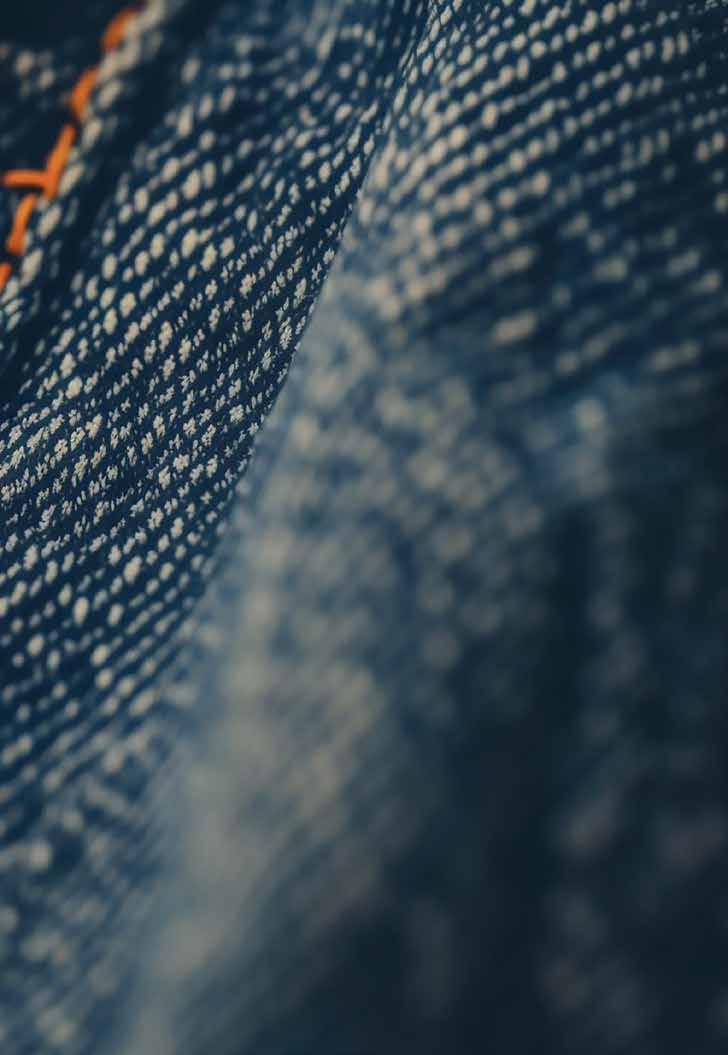
IF THESE TARIFFS TAKE EFFECT, THE IMMEDIATE IMPACT WILL LIKELY BE A DOWNTURN IN MEXICO’S TEXTILE AND APPAREL MANUFACTURING SECTOR.”
Erik Kingsley, Kingsley Szamet
Law Firm
AM moved quickly to upgrade the 10-acre complex, which consists of two buildings. The company also reaffirmed its commitment to expanding in Mexico, stating that it remains on track to scale its operations in the region. Its decision to push forward with these plans showcases AM’s confidence in the long-term viability of its expansion strategy, regardless of looming tariffs.
“We are continuing business as normal. We strongly believe in the add value benefit of being in [Mexico] and investing in it,” Sergio Turbay, executive vice president of global strategy and sales at AM, told SJ Denim. “The great thing is that our brands and partners believe in this as well. So, we are continuing our investment, and we look forward to expanding our manufacturing in the region [even further].”
Los Angeles-based women’s denim brand Ética is also unconcerned about Trump’s tariffs and is “proceeding with business as usual.”
“As of right now, we’re not too worried about it—but we’ll see what happens [further down the line],” a sales representative at Ética Denim, which operates a factory in Puebla, Mexico, told SJ Denim. “I’ve been asking our CEO [Agustin Ramirez] about it, and he doesn’t seem too concerned. So, for now, we’re taking a wait-and-see approach.”
The representative added that Ética’s size gives it more flexibility compared to larger brands. “We’re still a relatively small brand and company, so we’re able to be a little nimbler than some of our bigger partners. That gives us some breathing room to adapt if needed.”
Dr. Sheng Lu, professor of apparel studies at the University of Delaware, is not as optimistic, though. Lu noted that if denim products made in Mexico do face new tariffs when exported to the U.S., their price competitiveness could be significantly impacted, potentially leading to a loss of market share.
Lu’s research for the “2024 Fashion Industry Benchmarking Study,” conducted in collaboration with the United States Fashion Industry Association, shows that a significant portion of U.S. denim imports from Mexico serve the mass and value market segments, where consumers are highly sensitive to price changes. “While Mexico is a key supplier of denim products to the U.S. market, similar products are also widely available from Asian countries like Bangladesh and China,” he said. “Additionally, many ‘Made in Mexico’ denim garments incorporate U.S. cotton, yarns and fabrics through a regional supply chain. As a result, a decline in U.S. denim apparel imports from Mexico could also have a negative impact on the U.S. textile industry.”
Beyond the tariff increases themselves, Lu noted that a major concern for U.S. denim brands is the ongoing uncertainty surrounding trade policy. With no sourcing destination considered “safe” or immune to Trump’s tariffs, U.S. brands and retailers are hesitant to commit to expanding production in any country, he added.
“A significant increase in sourcing ‘Made in the USA’ products is unlikely due to limited production capacity,” he said. “Even sourcing diversification—once a widely adopted strategy to mitigate risk—may be less effective this time, as any country could be targeted.”
Another significant challenge facing mills and brands is the increasing labor shortage in Mexico.
For years, Mexico’s appeal as a manufacturing hub has been driven by its low labor costs and young workforce. In fact, fully loaded manufacturing labor costs range from $6 to $8 an hour, including bonuses and benefits, while roughly one-third of the country’s population—around 42 million people—is 19 or younger, according to Boston Consulting Group (BCG). However, Mexico’s
labor market has begun to show signs of strain.
According to AM, rising labor costs in the region are largely due to the USMCA agreement aimed at “leveling the playing field.”
“Fabric pricing in the region reflects what our clients expect compared to other regions and their macroeconomic situations,” Turbay said.
“Just like our clients, we must remain calm and take a long-term view. We believe that trade policies for clothing will eventually be exempt, and we’re in a strong position to compete due to our global presence. This is a key differentiator that we’re very excited about.”
Erik Kingsley, partner at Kingsley Szamet law firm—where he focuses on employment law and workers’ rights—echoed AM’s sentiment, adding that Trump’s proposed 25-percent tariffs on Mexican goods could have “significant implications” for labor markets on both sides of the border.
“If these tariffs take effect, the immediate impact will likely be a downturn in Mexico’s textile and apparel manufacturing sector. U.S.-based brands that currently rely on Mexican production may scale back orders, seek alternative suppliers or even relocate operations to avoid higher costs,” Kingsley said. “This could result in job losses and wage stagnation for Mexican workers in these industries. In some cases, factories may shut down altogether if the cost increase makes them uncompetitive in the global market.”
Over the long term, Kingsley added, continued aggressive trade policies could push companies to diversify their supply chains, reducing reliance on Mexico in favor of other manufacturing hubs in Central America or Asia.
“Mexico may respond by incentivizing domestic production or strengthening trade relationships with non-U.S. partners,” Kingsley said. “Additionally, we could see increased automation in manufacturing as companies seek to offset higher costs by reducing labor dependence.”
Beyond the impact on Mexico, these tariffs could also disrupt U.S. employment.
“If the cost of importing textiles rises significantly, American retailers and brands may face financial strain, leading to job cuts or price hikes that affect consumers. Additionally, since Mexico remains a key trading partner under the USMCA, these tariffs could strain diplomatic and economic relations,” Kingsley said. “Businesses operating in both countries should prepare for potential volatility and legal challenges as these trade measures unfold.”
Although the future remains uncertain, Patricia Medina, principal of Mexico-based denim manufacturer Aztex Trading and co-director of Mexmakers, a collaborative network of Mexican textile and apparel manufacturers focused on sustainable and traceable full-package production, believes Mexico will continue to be a vital manufacturing hub—especially for brands that recognize the shifting global landscape.
“The world in which NAFTA was created no longer exists, but Mexico still has a crucial role to play,” Medina said. “We can and will serve the new markets—those that prioritize more than just the initial cost of production.”
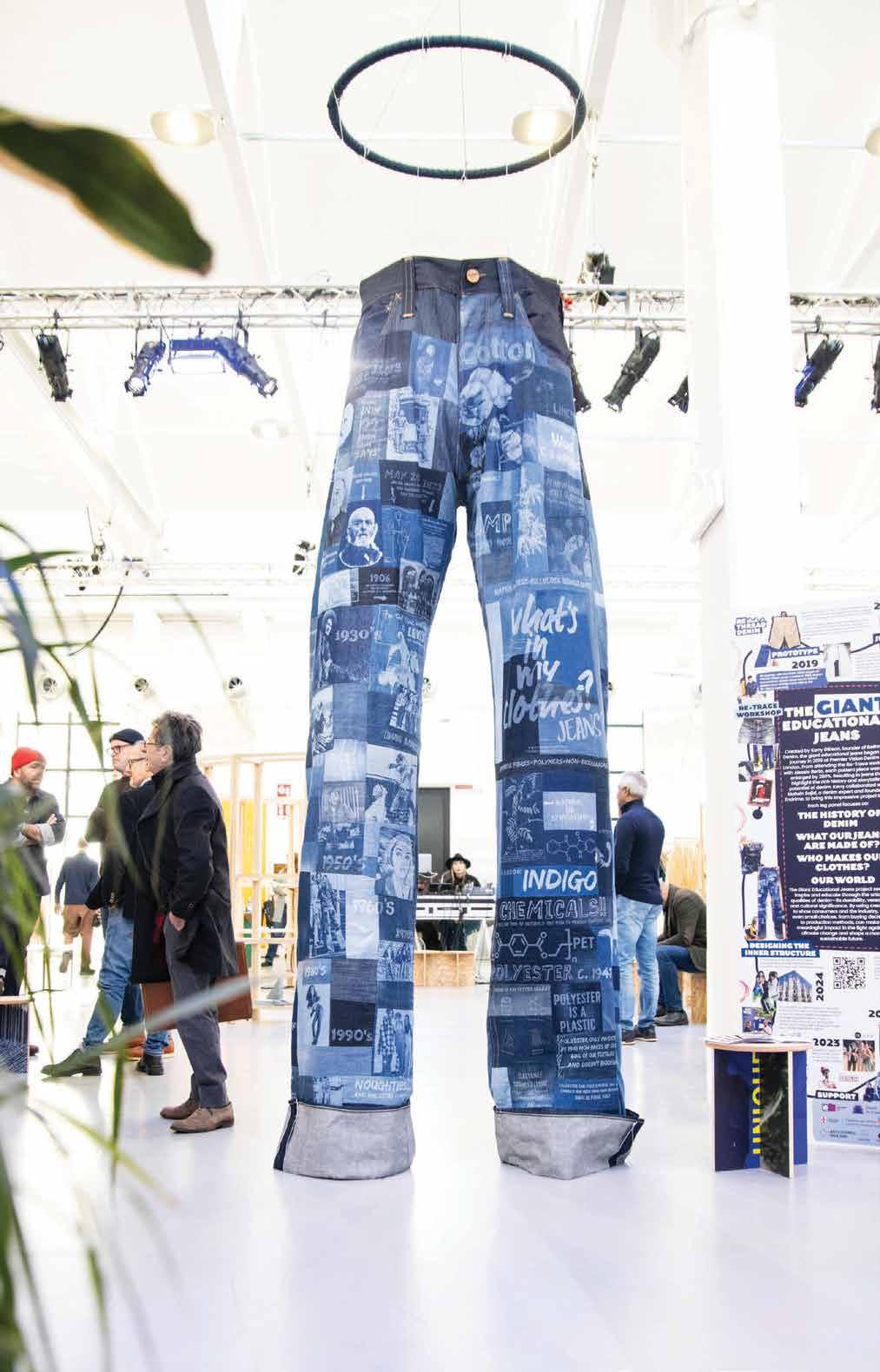
five years ago , during the deadliest days of the pandemic, the future of trade shows was uncertain. With travel and inperson meetings on hold, the denim industry began to question the necessity of gathering multiple times a year in distant locations. As a result, digital programming surged, online fabric libraries started to replace physical samples and collaborations formed over Zoom. However, the appeal of long-distance business relationships eventually faded. By 2021, in regions where travel restrictions had lifted, professionals were once again boarding flights—face masks on and negative Covid test results in hand—to attend trade shows.
“The landscape of business communications has shifted significantly with the rise of digital tools; however, I firmly believe that trade exhibitions will still hold a crucial role in our marketing approach. These events provide unique opportunities for face-to-face engagement, which is instrumental in building and nurturing trust within our long-term relationships,” said Mostafiz Uddin, the founder and CEO of the Bangladesh Apparel Exchange and Bangladesh Denim Expo. “Even in an increasingly interconnected world, nothing quite compares to the personal connections that can be forged at trade shows. They allow us to not only showcase our products and services but also to interact directly with clients and potential partners in a meaningful way.”
The purpose of B2B events, along with expectations regarding their size and attendance, has evolved since the pandemic.
Fabio Adami Dalla Val, show manager for Denim Première Vision (Denim PV), said attendance at the Milan events in 2024 has been shaped by a variety of factors, reflecting both broader industry trends and shifting global dynamics.
“We have seen a progressive return to in-person events after the pandemic, with a renewed appreciation for physical interactions. However, the focus has clearly shifted from quantity to quality, with companies prioritizing meaningful engagements over sheer volume,” he said. “At the same time, the denim market itself is evolving, with key players consolidating and becoming more selective about where they invest their presence.”
Denimandjeans, which hosts shows in Bangladesh, India, Japan and Vietnam, restarted its events in 2023. Since then, Sandeep Agarwal, its founder, said the organizers have “more or less sustained” interest.
Panos Sofianos, the denim curator for Munich-based Bluezone, said 2024 was a challenging year. “However, against the backdrop of economic challenges, we were very happy with the overall result. 2025 started with a good and strong show that recorded a slight increase in visitor numbers which makes us
NNISHAT FABRICS is a key player in the global fashion landscape, which is driven by a constant pursuit of innovation. Nishat Fabrics has established a worldwide reputation for excellence by providing a wide range of high-quality fabrics.
Founded in 2024, NDenim emerges from this textile giant with a clear mission: to redefine denim through adaptability, innovation and a dedication to ‘craft solutions.’ “Blu and Beyond,” the brand’s tagline, represents its commitment to preserving denim’s history while fearlessly embracing progress.
“Unbound Horizons—A Performance-Driven Denim Collection” by NDenim—will make its debut at Kingpins Amsterdam 2025. Engineering denim for movement, endurance and adaptability is the goal of this collection. NDenim leads the way by producing denim that can be worn in both urban and rugged settings as fashion and function become increasingly intertwined. Unbound Horizons is based on the idea of freedom, exploration and creativity. Tailored for individuals who value performance and adventure, the collection seamlessly integrates highperformance materials with cutting-edge designs, ensuring denim that excels in any setting. NDenim’s new line demonstrates that denim transcends mere fashion; it serves as a reliable tool, a versatile fabric engineered for performance.
The Unbound Horizons collection is comprised of four distinct ranges, each curated to address specific performance needs. From mobility and durability to protection and luxury, every line within this collection offers a unique innovation that sets it apart.
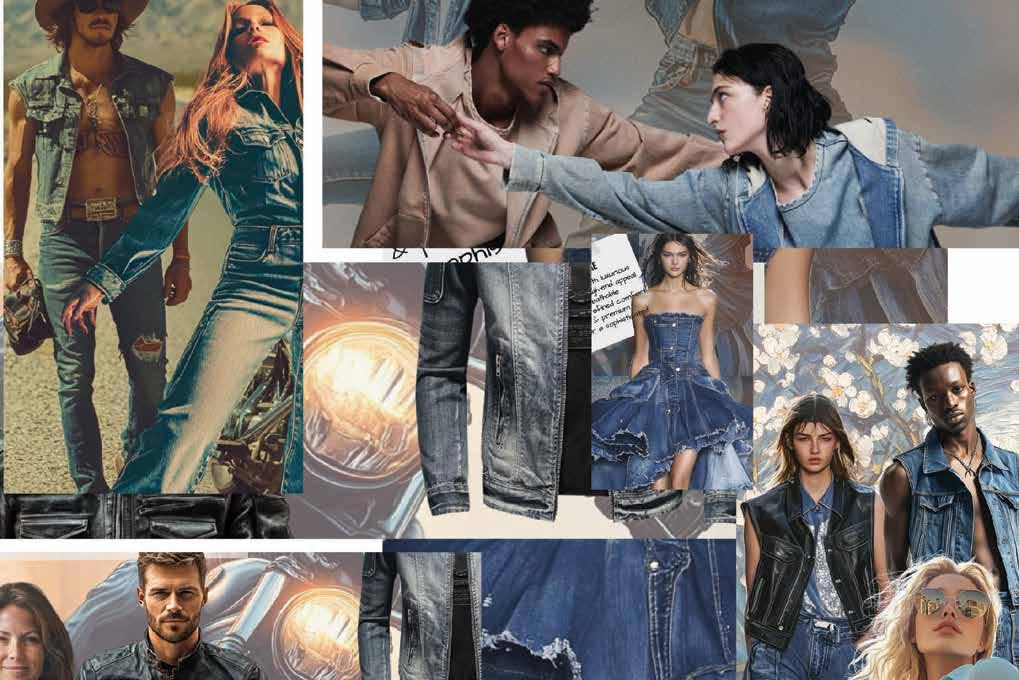
HORIZON MOTION: DENIM THAT MOVES WITH YOU
The Horizon Motion range prioritizes unrestricted mobility and effortless wear. Utilizing 4-way stretch and bi-stretch fabrics, this line provides unparalleled flexibility and comfort. Lightweight yet durable constructions, coupled with wrinkle-resistant and shaperetaining properties, cater to an active, on-the-go lifestyle. Whether for activewear-inspired denim, travel-friendly styles or commuter wear, Horizon Motion ensures comfort and functionality without sacrificing style. A palette of sleek blues, modern neutrals and soft blacks reflects a minimalist yet forward-thinking aesthetic.
HORIZON FORTIFY: ENGINEERED FOR STRENGTH AND DURABILITY
For those requiring resilience, the Horizon Fortify collection offers unmatched durability. Reinforced weaves, crafted from cotton/nylon blends and innovative technologies like Cordura® and Kevlar®-infused denim, make this collection ideal for rugged environments. Abrasionresistant and anti-tear features provide protection in challenging conditions, while moisture-wicking and breathable properties ensure lasting comfort. Targeted at moto jeans, workwear and utility-inspired denim, Horizon Fortify delivers on the promise of strength without compromising wearability.
THE INCREASING DEMAND FOR HIGH-PERFORMANCE, FUNCTIONAL DENIM HAS PROPELLED INNOVATION TO NEW HEIGHTS.
HORIZON VANGUARD: PROTECTION AND PERFORMANCE BEYOND LIMITS
The Horizon Vanguard collection meets the needs of modern explorers facing extreme conditions. Featuring flame-resistant, waterrepellent and UV-protective technologies, these garments are designed for outdoor adventure gear, tactical apparel and all-weather denim. Windproof, insulated fabrics offer protection against the harshest climates, making this line a preferred choice for those seeking performance apparel that withstands any challenge.
HORIZON LUXE: ELEVATED, PREMIUM PERFORMANCE DENIM
The Horizon Luxe range redefines luxury denim with women-centric designs and high-fashion interpretations. With a silk-like drape, luxurious hand-feel and subtle sheen,
this line delivers premium textures and refined comfort. Lightweight, breathable fabrics enhance the collection’s elegance and sophistication, targeting high-end appeal and stylish comfort.
As NDenim prepares to showcase Unbound Horizons at Kingpins Amsterdam 2025, the collection reflects a broader trend within the denim industry. The increasing demand for high-performance, functional denim has propelled innovation to new heights. NDenim’s approach, blending advanced technology with traditional craftsmanship, envisions a future where denim is not only fashionable but also a high-performance material tailored for diverse aspects of modern life.
With Unbound Horizons, NDenim solidifies its position as an industry leader, committed to evolving and redefining denim’s potential. By incorporating functionality, durability and luxury into a single collection, NDenim sets new benchmarks for performance-driven denim. ■

confident for the next months to come,” he said.
Uddin said Bangladesh Denim Expo had “an incredible turnout with over 5,543 visitors from 56 different countries” attend the last Dhaka event in November.
Despite a polar vortex that had temperatures drop below freezing during Kingpins New York in January, retailers and brands showed up. “It is typically the smaller of our two shows in New York and we found that our attendance was in line with previous January shows,” said Vivian Wang, the newly appointed CEO of Kingpins Show.
In the past, the success of an event was often measured by its attendance. While the metric continues to be a way to gauge interest, exhibitors and attendees are increasingly using the events for education and inspiration. “Trade shows are no longer just about networking; they must offer real strategic value to justify participation,” Adami Dalla Val said.
Though the show started in NYC 20 years ago, Kingpins Amsterdam has become the organizer’s second home. The Dutch event, which will take place this year on April 16-17 and Oct. 15-16, is widely consider the industry’s kick-off event for each season.
“Kingpins operates more as a platform than a traditional trade show. Of course, we organize events where the denim suppliers and buyers can review the latest collections and place orders. But we also are a place for the global denim community to meet, get inspired and share ideas. The mechanics of what we do has not changed fundamentally. But it appears more and more important to provide a place
to encourage business, as well as the exchange of ideas,” Wang said.
While Kingpins has experimented with bringing a consumer element to their events, its strength is in education and fostering connections between industry stalwarts and the next generation of designers, wash experts and sustainability experts. “Education has always been central to Kingpins and that will continue going forward. We want to keep bringing new ideas and innovations—and innovators, as well—to our shows. That is what keeps our industry moving forward and has propelled the development of new sustainable products and practices,” Wang said.
Adami Dalla Val feels a responsibility to create experiences that sparks creativity and facilitates meaningful and high-level interactions. “What sets [Denim PV] apart is its unique format, blending exhibition spaces, artistic installations, and exclusive content to foster dialogue and discovery,” he said. “It is more than a marketplace; it is an experience—a space where the boundaries of denim are constantly pushed, embracing cross-industry contamination with the lifestyle sector, technology, art, and craftsmanship. The event celebrates denim’s evolution beyond its classic definition, acknowledging its role as a cultural and creative force that intersects with multiple industries.”
Sofianos described Bluezone’s programing strategy as “edu-tainment,” adding that a diverse range of expert talks, keynotes, panel discussions and trend forecasting is working very well. The addition of Keyhouse, a curation of sustainability and tech-
focused market disruptors, brings a unique perspective to the show as well.
“There is still a platform to launch and present novelties, however the focus is shifting toward networking, education, collaboration and implementing technology. Building and strengthening relationships within the industry is easier when you meet in person. Getting educated in seminars, workshops or trend forecasting sessions is possible on a broader scale when industry players with different expertise meet at one place. Establishing new collaborations on existing challenges is being enabled when you address the problem and concrete action points within the network of a trade show and its experts from different fields of competence,” he said.
While shows are no longer battling covid, they’re being faced with new issues beyond their control.
Geopolitical disturbances that complicate travel and “general instability” in key sourcing regions are among the challenges that Agarwal sees for 2025. On top of it, he said they’re happening more frequently now. “We are keeping our fingers crossed and hoping that some of these conflicts will come to an end. Such conflicts affect not only denim but each industry and there is big hope that positive news will flow which will boost up the markets,” he said.
Sofianos pointed out how ongoing global economic uncertainties as well as price discussions in the textile industry complicate planning events accordingly ahead in time. Besides that, he said difficulties like deciding on the right date for an event and the quantity of denim events for the industry persists.
In addition to B2B denim events being very competitive now, Uddin said its crucial for organizers to consider the implications of the ongoing trade wars and various socio-political conflicts currently unfolding around the globe.
“The denim industry, like many other sectors, is likely to feel the effects of these
INDUSTRY IS EASIER WHEN YOU MEET IN PERSON.” Panos Sofianos, Bluezone
external challenges in several ways. Trade tariffs may increase costs for manufacturers, possibly leading to higher prices for consumers. Additionally, we might see a shift in sourcing strategies as companies seek to navigate these complexities, to maintain competitiveness and profitability,” he said.
Moreover, the participation of denim brands in global events could also be impacted, forcing trade show organizers to revisit old pandemic alternatives. “We could see a change in which countries are able to showcase their collections due to restrictions or diplomatic tensions,” Uddin said. “Events may need to adapt to these realities and perhaps focus more on localized markets or virtual presentations.” rrent events, but our aim is to continue to be a place that connects the denim industry and to put together programs that inform and inspire and encourage collaboration.”
Despite the challenges being felt across the B2B network, Wang is optimistic for 2025. “There is a lot of uncertainty affecting all businesses right now,” she said. “We are keeping an eye on current events, but our aim is to continue to be a place that connects the denim industry and to put together programs that inform and inspire and encourage collaboration.”
AAS THE DENIM INDUSTRY embraces more sustainable materials, hemp has emerged as a versatile and eco-friendly option. To meet growing demand, sustainable hemp manufacturer Panda Biotech is expanding its operations, making this durable, low-impact cellulosic fiber more accessible to mills and brands.
Here, Mark D’Sa, senior vice president of business development at Panda Biotech, discusses how the 100 percent American and Native American owned company is driving innovation in hemp fiber production and helping brands embrace a greener future through its growing infrastructure and advanced processing capabilities.
SJ DENIM: How has demand for hemp evolved in recent years?
Mark D’Sa: Our initial output was spun into coarse-count yarns blended with cotton and used in denim. Later iterations were used in canvas and twills, with higher percentages of hemp in the fabrics. More recent trials focused on spinning finer yarn for knitted fabrics. The early adopters of U.S. hemp fiber have been Mexican mills, which have been great partners in producing fabrics that have received positive feedback from customers.
On the retail side, they are expanding their hemp assortment in both knit and woven categories, with continued growth expected as textile-grade hemp fiber becomes more widely available at scale.
How are you creating hemp specifically for textiles? And what do denim mills need to know about using hemp?
M.D.: Our mechanically cottonized hemp fiber is exceptionally clean, containing no dust and less than


1 percent hurd—the woody, inner-core fiber of the hemp stalk—with fiber lengths ranging from 25 millimeters to 55 millimeters. This makes it ideal for blending with cotton, viscose or lyocell.
Hemp adds a distinctive character to the final product— one that, when thoughtfully designed, can deliver outstanding results with sustainability and set your offerings apart in the market. We’re also excited to partner with Twin Dragon Marketing Inc. (TDMI) to unveil a new hemp denim collection at Kingpins Amsterdam.
Given the growing demand for sustainable materials in the fashion industry, how does hemp compare to more commonly used fibers in terms of environmental impact?
M.D.: Hemp is a remarkably resilient and durable natural fiber that requires significantly less water and fertilizer to grow compared to other commonly used fibers, while offering soil remediation and regeneration benefits.
It also has an impressive carbon sequestration rate. For example, at Panda’s full hemp supply capacity, the carbon dioxide (CO2) conversion is equivalent to removing approximately 60,000 cars from the road each year. Additionally, hemp is fully biodegradable and can be processed without chemicals.
“HEMP FIBER ADDS A DISTINCTIVE CHARACTER TO A FINAL PRODUCT—ONE THAT, WHEN THOUGHTFULLY DESIGNED, CAN DELIVER OUTSTANDING RESULTS WITH SUSTAINABILITY AND CAN SET YOUR OFFERINGS APART IN THE MARKET.”
MARK D’SA senior vice president of business development, Panda Biotech
Beyond these benefits, properly processed industrial hemp yields a fiber that blends seamlessly with cotton, viscose, lyocell and other fibers, creating soft yarns and sustainable fabrics. As a result, hemp fiber offers an attractive, eco-friendly option for the fashion industry as it increasingly incorporates more sustainable products.
Panda Biotech officially opened its hemp gin in Wichita Falls, Texas last June. How are you incorporating sustainable practices into the facility’s operations?
M.D.: Panda Biotech’s Panda Hemp Gin operates within a 500,000-square-foot facility, with the current capacity to process 10 tons of industrial hemp per hour. We take pride in being a global leader in zero-waste hemp processing—sustainable,
traceable and eco-friendly. Our facility is certified for zero discharge of hazardous chemicals (ZDHC), and every part of our hemp feedstock is mechanically processed using a state-of-theart automated line.
Sustainability has been at the core of Panda Biotech’s mission since day one, a legacy passed down from our parent company, Panda Energy, which spent over three decades building some of the cleanest energy facilities worldwide. It is part of our DNA, woven into every aspect of our operations and supply chain.
In our first year of operation, we proudly earned both the Oeko-Tex® Standard 100 certification and the United States Department of Agriculture (USDA) Certified Biobased Product label. We’re not stopping there, though. Additional certifications are currently in progress and will be announced soon. ■
Beyoncé is taking denim on tour.
the tourdrobe this spring and summer will be serving “denim on denim on denim” thanks to Beyoncé taking her Grammy Award-winning “Cowboy Carter” album on the road. Denim has been a mainstay in the Houston-native’s wardrobe since releasing the album last year—even inspiring a multi-part campaign with Levi’s. c From April 28 to July 14, with stops in Los Angeles, Chicago, New Jersey, Houston, Washington D.C., Atlanta, Las Vegas, as well as London and Paris, brands and retailers will have the chance to capitalize on BeyHive-approved western wear, just as they did with club

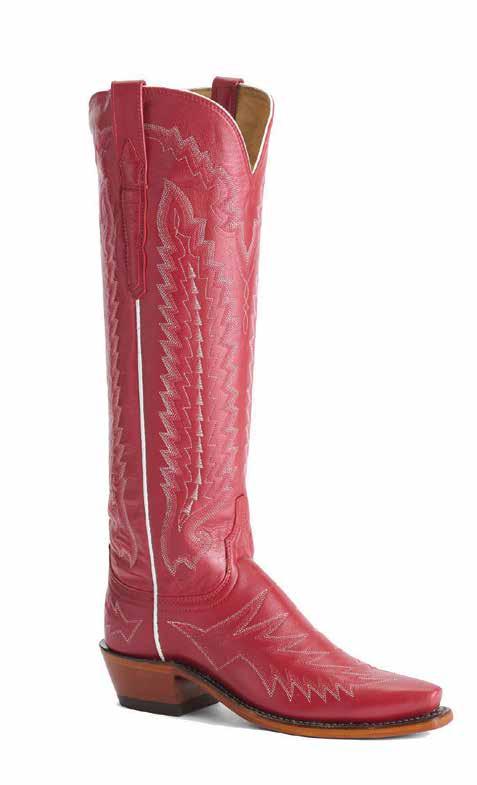
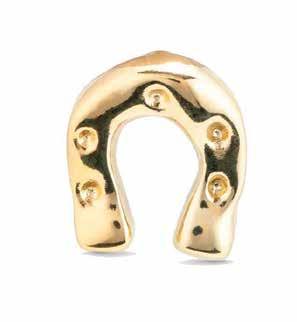

fashion for Beyoncé’s 2023 Renaissance World Tour. c The tour promises yet another season of bold, western-inspired fashion, from iconic double denim and bootcut jeans to timeless western shirts, cowboy boots, and hats. Fans will add their own flair, rocking rhinestones, embroidery, fringe details, and eye-catching bandana prints to keep the looks fresh and electrifying. c Here, SJ Denim has curated the ultimate tourdrobe for concert goers. Expect a seamless blend of Americana kitsch and rhinestone cowboy as Beyoncé and her stylish fans bring her iconic style to the stage.


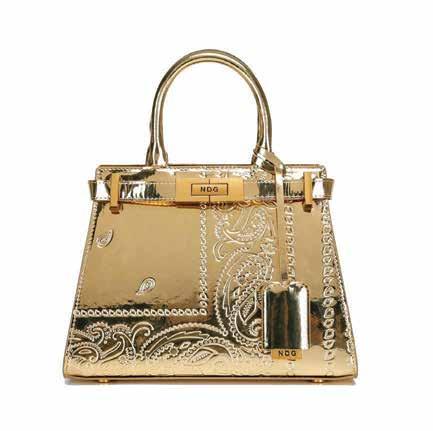

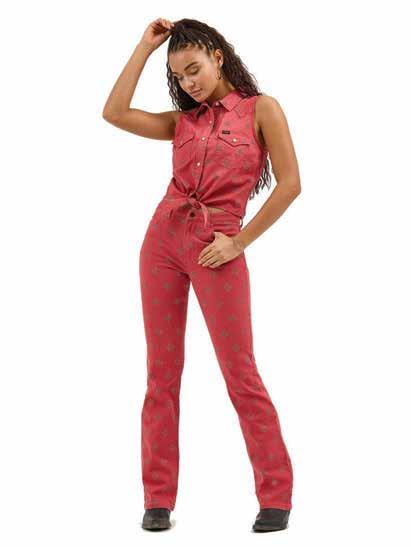

SOURCING JOURNAL THE YEAR AHEAD
From inseams to finishes, mills to marketing, each edition of SJ Denim shines a spotlight on the industry’s most relevant issues, trends and personalities. Be a part of our Summer, Fall or Winter issues!

SUMMER
AD CLOSE: MAY 9
DISTRIBUTION: DENIM PV, KINGPINS NY, BLUEZONE
FALL
AD CLOSE: SEP 24
DISTRIBUTION: KINGPINS AMSTERDAM
WINTER
AD CLOSE: NOV 3
DISTRIBUTION: SJLA, DENIM PV, BLUESZONE, KINGPINS NY
DEBORAH BARON Advertising Director, Fairchild Media Group, dbaron@fairchildfashion.com

•Loomstate original denim, unprocessed and raw authenticity
•Ultra-Nappy texture with natural hairiness, a true vintage-inspired look
•Balancing tradition and wearability

•Authentic shirting & mid-weight fabrics, classic aesthetics with a timeless feel
•Heritage yarn & weaving techniques, a return to traditional craftsmanship
•Rigid and comfort stretch articles

